21 Things You Need to Know Before Visiting Colombia
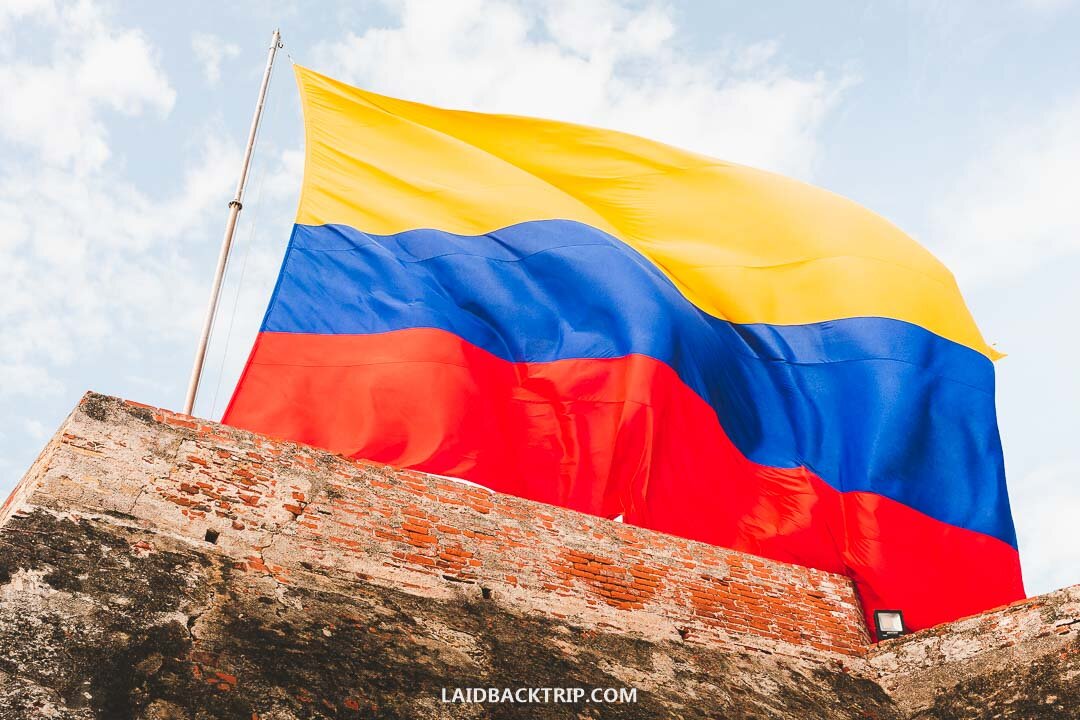
Colombia is a South American country with such rich diversity that instead of our planned one month visit, we stayed here much longer. An interest in traveling to Colombia grows every year, so we want to share with you 21 essential things you should know before planning a trip and visiting this beautiful country.
Colombia was the first destination we visited in South America, but we must admit, it stole our hearts. It is probably not a coincidence that many travelers have a very similar feeling.
Thanks to it, Colombia quickly gained a reputation of being one of the top travel countries on the continent.
Colombia is at the moment on the radar of many international travelers. Therefore we think you should know more about it before your trip.
Still, the country is unique, you can expect to deal with many specific situations, and in a nutshell, it is always better to be well-prepared.
Colombia is a very diverse country, and it offers an incredible number of attractions, from white sandy beaches to over 5000 meters high mountain tops.
But before you pack your stuff and set off, it is also good to know that customs, safety, or overall culture are very different from what you know by heart back at home.
This is why we've put together this list of things you need to know before visiting Colombia. It includes a few random tips we've collected during our travels.
Actually, there were 21 things you should know before traveling to Colombia, but we wrote this post on the road, and while editing it later at home, we came up with a few more, so the math does not match.
We hope you won't mind and will enjoy this post!

#1 WATCH YOUR STEPS
We've never stumbled that many times when walking on streets as in Colombia. Some parts of the pavement are very often missing, and all of a sudden, there is just a hole, so watch your steps, especially in bigger cities.
What is even more important, be really careful after the dark as some less visited places still have very poorly lit streets, and it is very easy to fall.
You might think that broken pavements are something you can get used to after some time, but it is actually quite hard.
Especially when sightseeing in the city with a camera in hand.
This problem is more in cities such as Bogota or Popayan than in smaller colonial towns, but we recommend you to mind your steps all the time.
Cities are not wheelchair and stroller-friendly because usually, you must surmount a big step when you want to get from the road to the pavement.
That does not mean Colombia is not a destination for families. Still, you will very likely find it much more comfortable to carry your kid in a baby carrier rather than struggle with a stroller.
Also, do not expect that vehicles yield at pedestrian crossings; always look around as traffic can be crazy.
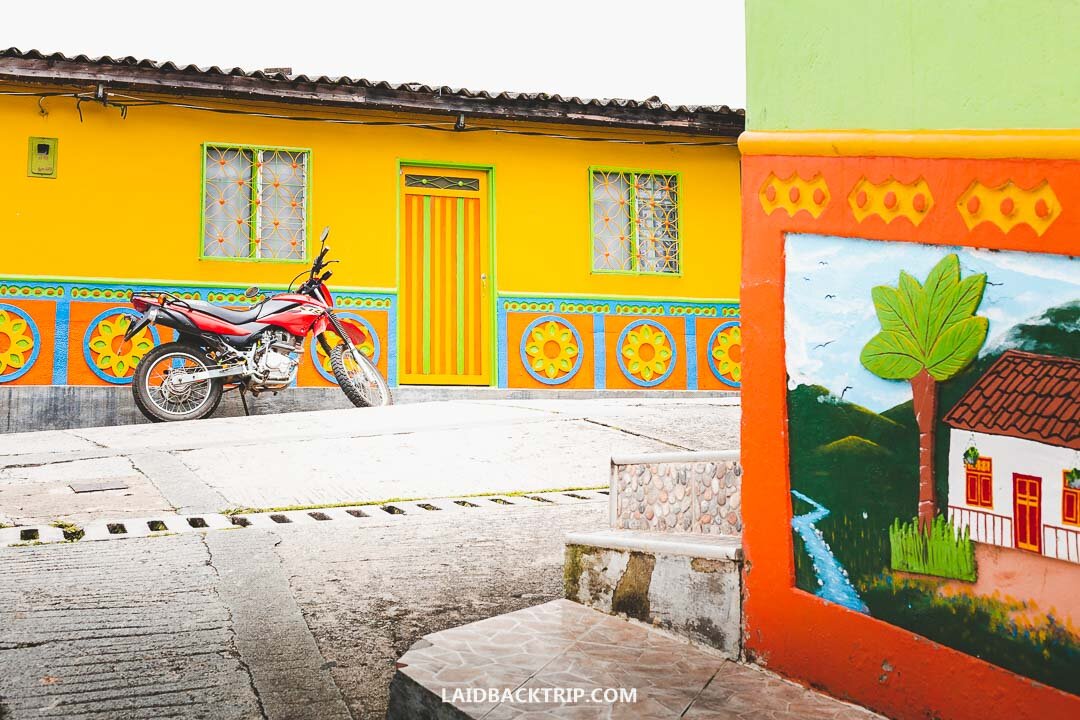
#2 COLOMBIA SAFETY
Colombia surely does not have the best reputation when it comes to safety. And it's not just Colombia, but other countries on this continent as well.
That's why it is essential to stay safe in South America while traveling .
On the other hand, the situation has been rapidly improving, and we are now confident that you should be fine when you follow all the basic safety rules.
Of course, mishaps happen, but they happen anywhere in the world, not only in Colombia.
By the way, when talking about safety, you should arrange your travel insurance before the trip!
World Nomads provides travel insurance for travelers to cover their trip essentials, including sports and adventure activities.
SafetyWing is affordable travel insurance for backpackers, long-term travelers, and digital nomads.
Travel smarter and safer!
The association with drug cartels and violence slowly disappears.
But of course, even though we could read that safety in Colombia is much better than it used to be, we were a bit concerned before our travels to Colombia.
It was our first experience with visiting a South American country, and some of the articles we could read online made us feel uneasy.
Fortunately, our fears did not fulfill.
In all countries around the world, it is useful to know that some areas, either in the city or a country in general, are better to avoid.
Still, when you use your common sense, travel with someone, follow mostly the backpacker's trail, don't wear shiny jewelry, and don't walk lightheaded after dark, you should be fine.
You should always watch your belongings (once in Bogota, I left my phone in a jacket I had around my waist and was a victim of a sneaky robbery immediately), especially in crowded places and on public transport.
Always have your backpack with you, don't store all valuables in one place, and pass everything over without resistance in case of robbery.
To keep your valuables safe, consider purchasing a money belt or anti-theft daypack .
Because we take lots of photos during our travels, it is impossible to keep the camera in the backpack all the time.
We usually use a smaller mirrorless camera when walking around the city and use the larger one when traveling in the countryside.
Also, when Martin takes photos, I try to be around, stay cautious, and pay attention to his surroundings (however silly it might seem).
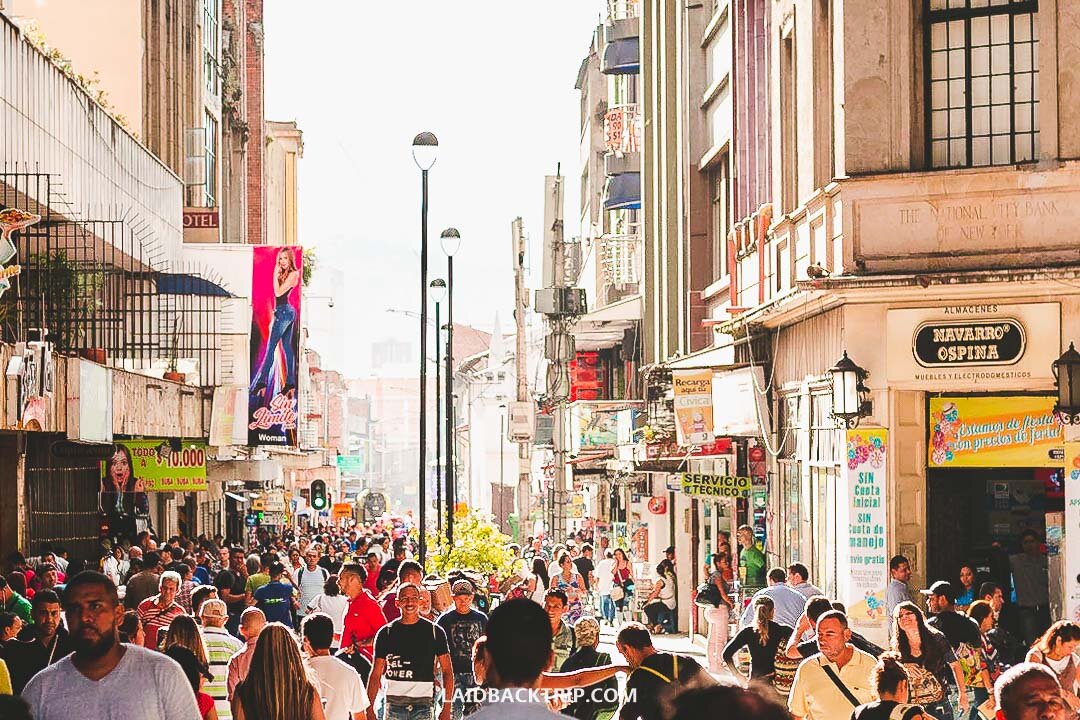
#3 FORGET YOUR DIET FOR A WHILE
Colombian food is hearty and filling. To put it mildly. In a nutshell, especially at the beginning of our trip, we felt a bit desperate, and it was hard to adapt to this change as this food was completely different from our usual eating habits.
Every meal we found was fried, not fresh, without herbs, or too sweet, not exactly what we usually eat.
Also, not every time we travel we can allow spending lots of time looking for a restaurant, that's why we often ended up with food we were not 100% satisfied with.
After some time, the situation improved.
We learned some Spanish words, we always in restaurants looked for menu del dia which consists of soup, the main course with meat, salad, and juice (for about 10 000 COP) and for dinner, we usually cooked something on our own.
Later, we discover some really nice restaurants and generally, after we traveled more south of Medellin, the situation improved and we looked forward to eating again.
The street food usually consists of empanadas (fried pastry with meat and potato filling), which we usually bought when traveling all day on the bus, and arepas (dough made of maize), which we found particularly ugly.
Certainly, we do not want to put you off.
It is just good to know that Colombia is not a foodie destination (when traveling on a budget ), such as the whole of Southeast Asia , although it is, of course, only our individual point of view.
#4 COLOMBIAN FRUIT IS DELICIOUS
Although we found food in Colombia a little bit dull, we must say that fruit is incredibly delicious.
We got addicted to papaya and pineapple, which became our everyday must-have, but we also tried native fruits such as guanabana, guava, lulo, tomato del arbol, and many more.
The best place where to find fresh fruit is in local markets.
Luckily, you will find at least one market with veggies and fruits in every town or city.
In our post dedicate to long term travel , we mentioned that it is quite important to maintain a daily routine - for us, buying delicious fruit was a thing we always looked forward to.
We are not afraid to say it was one of the reasons why we were able to travel for so long.
Not only in Colombia, but South America overall.

#5 LEARN SOME SPANISH BEFORE YOU GO
English is not widely spoken in Colombia. To be honest, we were unpleasantly surprised that literally, no one speaks English, quite often not even people working in the tourism industry.
After a first few days when we had a problem ordering meals in the restaurant or figure out how much a bus ticket cost, we came to an inevitable conclusion that it is necessary to learn some basic Spanish.
We recommend you to have at least a translator on your phone ready; otherwise, you won't be able to get any help.
In case you have more time to prepare for your trip, either take a Spanish language course or buy a Spanish textbook .
Once you learn some basics, your trip will surely be more pleasant.
We traveled in South America for a year , and if there's one thing we regret, it is a fact we hadn't spoken Spanish fluently as we missed many opportunities to talk to locals more naturally.
#6 COLOMBIANS ARE VERY FRIENDLY AND HELPFUL
Colombians are very friendly and helpful. We are sure this is something every traveler to Colombia will confirm, and we also think it is one of the most important things to know before visiting the country.
When you ask for any information or advice, locals will try to help you immediately
And when they don't know the answer, they will surely find a friend around who can solve your troubles.
We even experienced a situation when a bus driver gathered all staff from a bus terminal, only because he did not know an answer to our question himself.
If you have a problem or don't know your directions, Colombians will do their best to help you out.
#7 COLOMBIA IS NOT A CHEAP COUNTRY (AS IT USED TO BE)
Colombia is not that cheap when it comes to traveling. Don't expect similar prices as in Southeast Asia for sure.
Bus tickets are pretty expensive and although the food and accommodation are slightly cheaper than in Europe, traveling in Colombia cost us more than we expected.
It is probably highly individual opinion, but we can imagine more friendly countries for our bank account as budget travelers.
The entrance fee to San Agustin Archaeological Park is not very budget-friendly, and adventure activities in San Gil don't come cheap either.
Sadly, the quality of services often does not reflect the price, but it is the same as in other countries. Some services are exceptional; some are very poor.
Even though Colombia is not the cheapest country we've ever visited, it is by far not the most expensive, and the visit was totally worth it.
Simply put, Colombia is not Brazil or Chilean Patagonia , and it's still a very affordable destination, though it's not as cheap as you might expect.
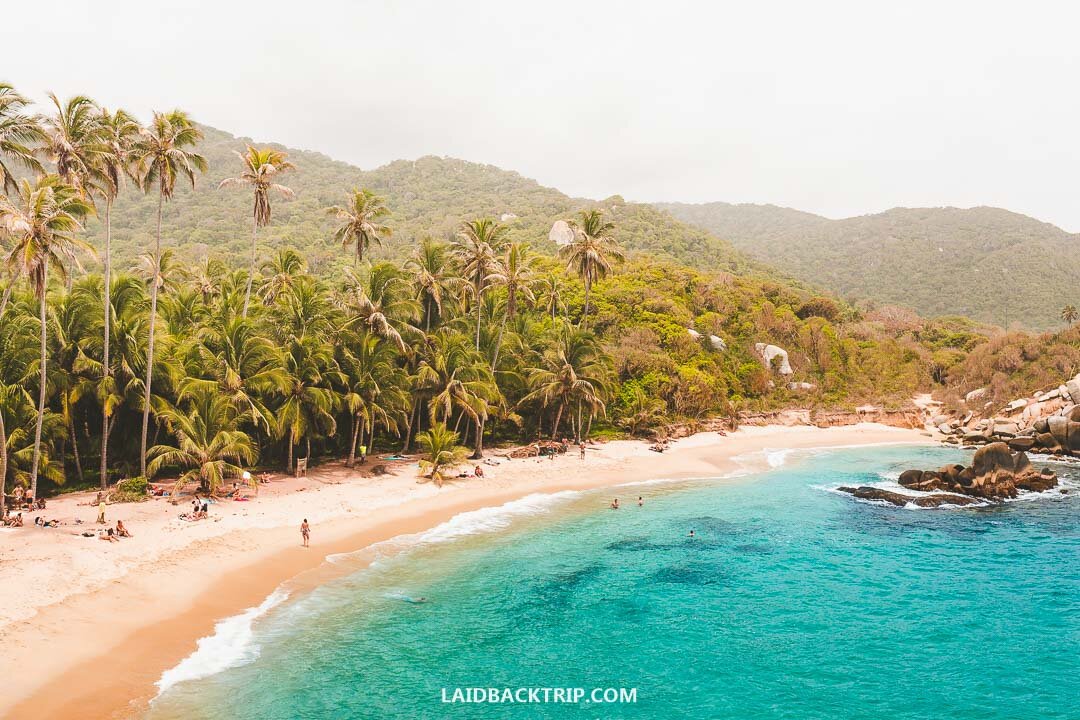
#8 PUBLIC TRANSPORT IS SLOW
It is very likely that you will travel around Colombia by public transport. And although it is possible to get by bus to almost all destinations, expect tiring journeys, winding and bumpy roads and a lot of sitting.
When traveling by bus, be prepared that the journey will be more than slow.
Our average travel speed was less than 40 km/h. The distance you can cover per day is limited, so don't forget to plan your itinerary accordingly.
After 4 days in Cartagena , we took a 15-hour bus to Medellin. The journey was long and tiring, and eventually, we found out that flight tickets were only slightly more expensive and would have saved us a bumpy ride.
#9 WEEKENDS AND HOLIDAYS GET BUSY
Colombians love to travel, especially in large groups. They also love to celebrate. It seemed to us that every weekend local people decide to take all their family and friends for a trip.
It is an awesome habit, but some places were, thanks to it, super-crowded, and accommodation in the most popular destinations booked.
Try to avoid long weekends, and if you travel on Friday or Saturday, book in advance.
Also, when you plan your itinerary, check out national holidays, and make sure you reserve tours or hotels, just in case.
Busy weekends have one big advantage, though. Some places and areas are safer.
That's why, for example, we hiked to Cerro de Monserrate in Bogota or explored Arvi Park in Medellin during the weekend, even though the trails were busy.
#10 SUGAR IS IN EVERYTHING
One of the first words we learned in Spanish were ‘sin azucar’, which means without sugar. We found everything in Colombia too sweet, to be honest.
From a classic bread to white yogurt, you must expect that sugar is an ingredient that is not missing.
What more, there's more sugar in it that you are probably used to.
Even if you are a sweet tooth, you might find the amount of sugar higher than acceptable. But maybe not. Feel free to let us know your thoughts in the comment section.
We had to make an effort while shopping and look for exceptions, which took us quite a lot of time.

#11 COLOMBIA IS A DIVERSE COUNTRY
We have never believed we would enjoy traveling in Colombia that much. The country is incredibly diverse, and it offers a place for every type of traveler.
You'll find in Colombia the Caribbean Sea, Pacific Ocean, wonderful sandy beaches, photogenic wildlife, diverse flora, mountain ranges, volcanoes over 5000 meters high, deserts, colonial cities, wax palms, indigenous tribes, and much more.
Generally speaking, Colombia is a destination for everyone, and creating the perfect Colombia itinerary is incredibly hard, as it is simply impossible to see everything quickly.
Nature and the fact Colombia is rich in architecture but also archaeological places means only one thing. The country is getting every year more and more popular.
#12 HOT WATER DOESN'T MEAN HOT IN THE TRUE SENSE OF THE TERM
Does your accommodation advertise a hot shower? Let's say that a hot shower in Colombia means rather tepid water.
It was a real treat when we found a place with warm water as it happened very sporadically.
It is ok in places such as the Tatacoa Desert , where temperatures often exceed 30 degrees Celsius.
Still, we would have appreciated warmer water in colder areas such as Bogota or Manizales.
On the other hand, we realize that we always stayed in cheaper hotels.
In case your Colombia budget is higher, you might have a different experience as we believe the service is better.
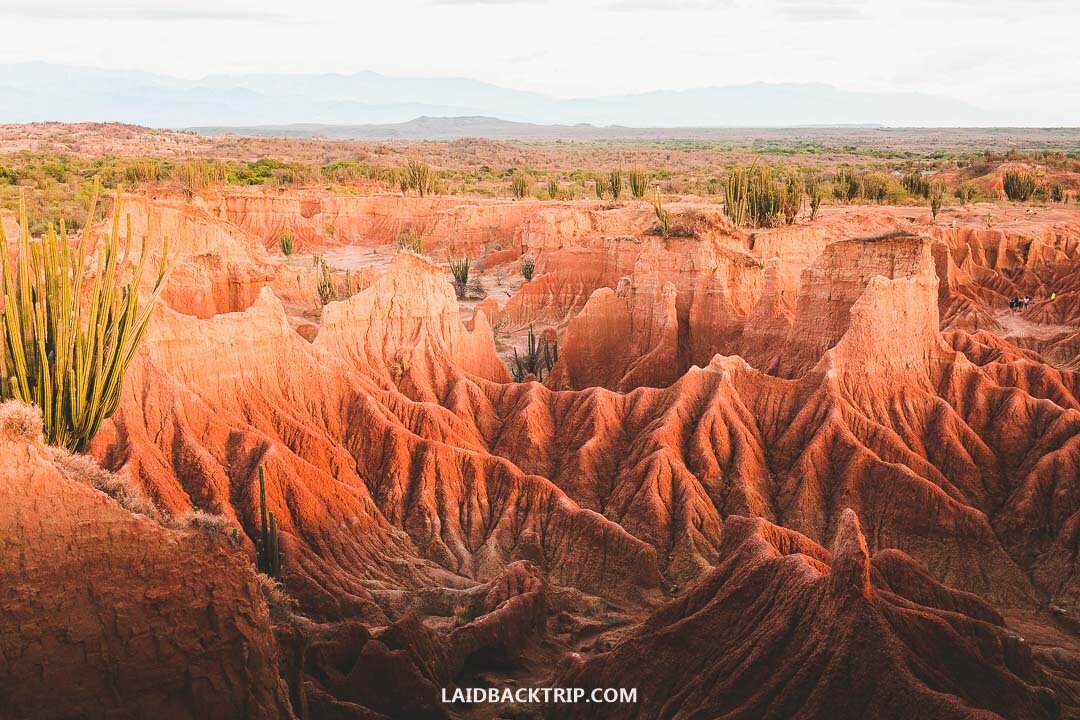
#13 POLICE AND SOLDIERS ARE EVERYWHERE
There is still a strong police presence in Colombia. You can see police officers and soldiers everywhere around.
And it takes time to get used to the fact that they are not here because something is going on, but they are on the streets to make sure that no issues will arise.
Safety, as we've already mentioned, has been increasing in this country every year, but it will probably take longer to experience the sensation of walking the streets of Colombia without being watched all the time.
#14 NETFLIX TV SERIES NARCOS
Have you seen the TV series Narcos from Netflix, and did you like it? Fine, but keep it for yourself when traveling in Colombia.
Drug trafficking and violence are still a very sensitive topic here in Colombia for understandable reasons, and locals have a feeling that the show doesn't depict the reality correctly.
Also, they don't want Colombia to be seen as a drug country again, so generally steer clear of this topic. This is one of the things you should know before traveling to Medellin , but other places as well.
In cities such as Medellin, which has been for long infamous for drugs and especially narco baron Pablo Escobar, is actually talking about this issue some kind of taboo.
The country has been transforming, and the transformation is a long and painful process.
So respect local peoples' decision and do not speak about this topic, at least publicly.
Luckily, there are plenty of things to do in Medellin that will allow you to see the city in a new light.
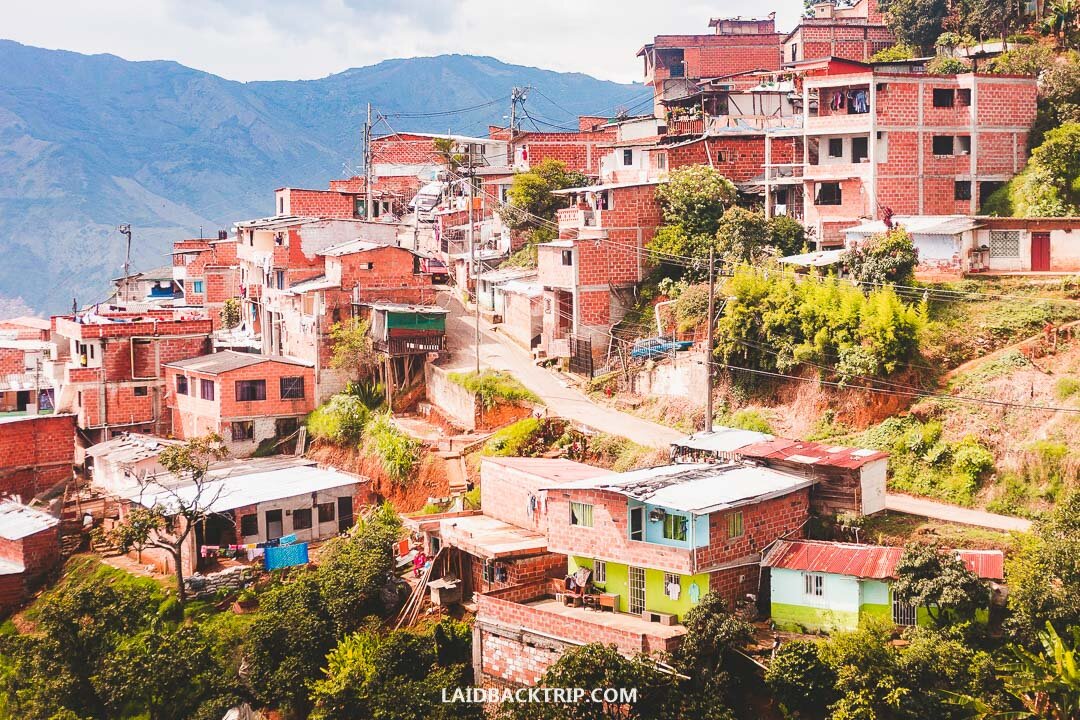
# 15 HAGGLING
You probably can try to haggle in Colombia, there are some places such as the markets (for example in Medellin), where it is even expected, but we didn't have the need, to be honest.
Unlike in Southeast Asia, we almost never felt overcharged, and most of the times we saw that locals pay the same price as we do.
For us, it was a nice change not to bargain all the time.
#16 BAGS OF WATER
You can buy water in big plastic bags, and although it is not the most practical thing, it helps you save some money as it is cheaper than bottled water.
We bought a few bags of water before traveling to the super hot Tatacoa Desert , as the water in the desert was really expensive.
But let's talk about water more closely.
Same as any other developing country, Colombia also has a huge problem with plastic. We are not afraid to say that it is your responsibility as a traveler to reduce your plastic consumption to the very minimum.
We know it is often not 100% possible, but when you buy, for example, a 5-liter plastic bag or barrel of water, it is much better than when you buy five one-liter bottles.
Therefore, when traveling abroad , not only to Colombia, always have your favorite reusable water bottle .
On top of that, most of the better hostels and hotels have a large tank of water in the lobby where you can refill your water bottles for free.
You might want to check out this water bottle with integrated filter if you want to try something new and sustainable.

#17 BEAUTY IS IMPORTANT
You might notice that Colombian girls are very often well-positioned when it comes to world beauty competitions.
When in Colombia, we could see that the cult of beauty here is really strong, and everyone, guys included, care about their visage, maybe too much if you ask.
An obvious trend is to wear braces at every age to have straight teeth, and it also seems that plastic surgery is a real thing here.
We do not want to say whether it is good to know, but it is surely a thing you will notice.
It is necessary to say that we often felt badly dressed in our outdoor and functional clothes.
Speaking of beauty, the colonial town of Barichara is often considered the prettiest town in Colombia.
# 18 COFFEE
Where else to drink coffee than in Colombia, the country with one of the world's largest productions?
Colombians usually drink coffee called tinto', a small, cheap, and sweet cup you can buy along the road.
Tinto is the second quality coffee, as most of the premium quality is exported (it is too expensive for locals).
If we can give you advice, avoid this type of coffee and rather visit a good coffee shop where the cup of coffee costs more but is also better.
Besides visiting a coffee shop, your other alternative is to visit a proper coffee farm in one of the coffee towns such as Salento , Jardin , or Manizales .
We visited an organic coffee farm in the heart of Zona Cafetera , and not only could we see how hard it is to get a tasty cup of coffee on customers' tables, but also we could taste the best coffee we've ever had.
And by the way, Salento is also home to Cocora Valley , where you will find the national trees of Colombia - wax palms.

# 19 COLOMBIANS ARE VERY POLITE
Even in informal everyday conversation, Colombians talk very politely, and instead of using simple sentences, they always say extra thousand words.
Although it is nice, this habit always made it much harder for us to understand the real point as our Spanish was not the best.
And when we politely asked the person to repeat the sentence more slowly, we usually receive the exact same answer, with a few extra new words.
It is funny when we think about it now, but it was a bit stressful on the road, especially when we were in a hurry.
Generally, it is safe to use a taxi in Colombia. It is always better to ask in the hotel or in the restaurant to call a radio taxi for you than to hail the cab on the street.
Always agree on the price before you sit in the car.
We never had a problem with yellow taxis; drivers always brought us to our destination safely and asked for a reasonable amount.
You can use Uber in bigger cities. Note that Uber in Colombia is illegal, so it is always better to sit in the front next to the driver, so it looks like he is giving a ride to a friend, not to a customer.
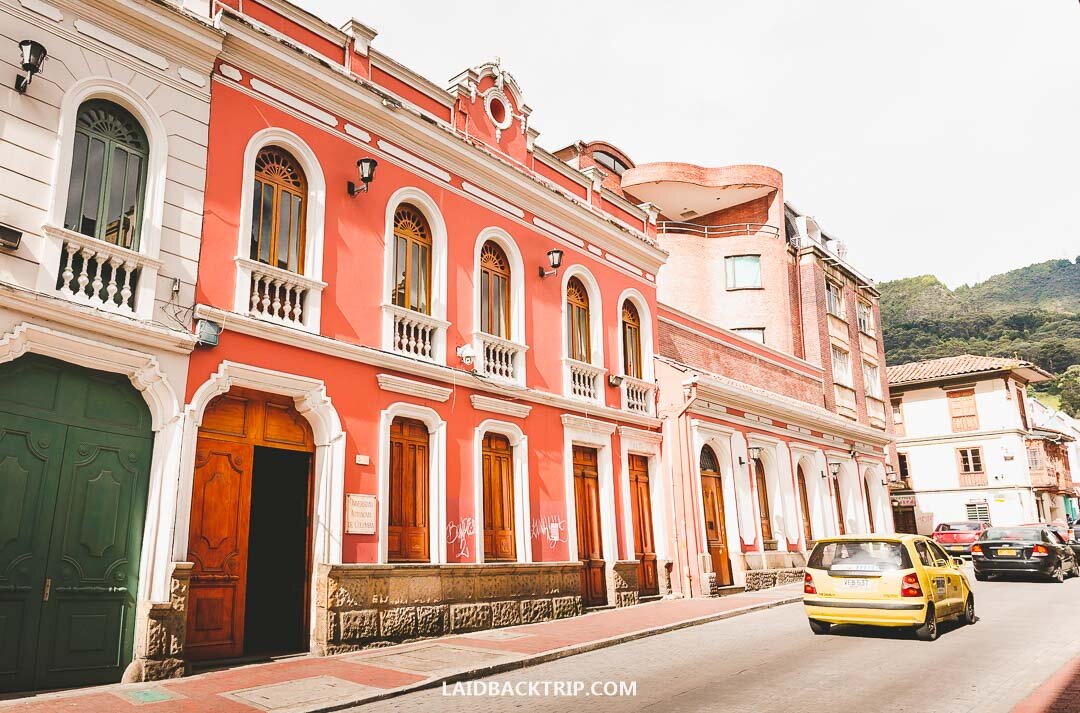
# 21 CASH IS KING
You won't buy much with your credit card in Colombia. You can use it in some shops (Exito) and better quality hotels, but cash always has a priority.
The highest value bill is 50 000 COP, and the highest amount we were able to withdraw was 780 000 COP. If you see a garish green ATM with a black Servibanca sign, that's the one you are looking for!
As it is not very safe to carry around a lot of money with you, always withdraw only as much as you need for a few days. Just make sure that your next destination has an ATM.
And when visiting places such as Tayrona National Park , make sure to bring enough cash for the entire length of your stay as there are no ATMs at all.
#22 YOU CAN'T SEE EVERYTHING
Colombia is a large country, and even if you can travel indefinitely, you would need years to see it all. That's being said, and you simply cannot see everything this country has to offer.
That's not a bad thing.
When creating your travel itinerary, focus on the top highlights, and if time allows, make sure you visit an interesting destination off the well-trodden path.
For instance, we didn't hike to Lost City in the Colombian north, as it was too expensive for us at the time.
And we rather opted for treks in Peru, such as Salkantay Trek and Inca Trail .
Although we usually do not travel to countries we have already visited, we have a feeling we will break this rule of ours quite soon.
Colombia is a captivating country, and we actually see it as a positive that it is impossible to see it all. It is a reason to come back one day.
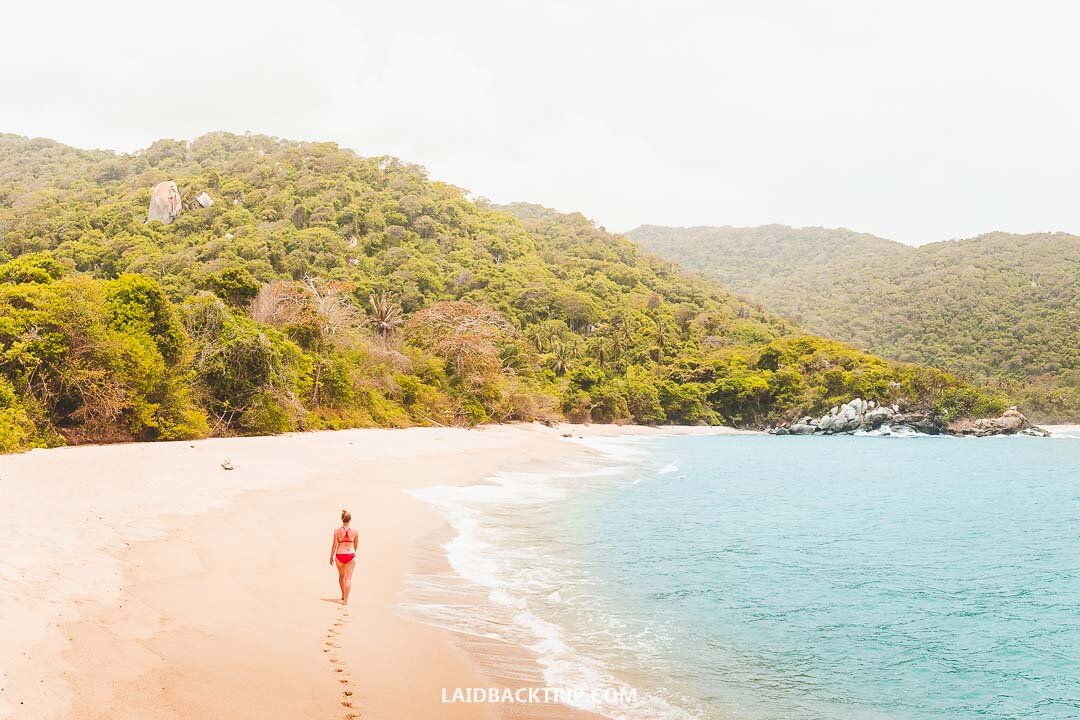
# 23 RAINY AND DRY SEASON
If there's something you should know before planning your trip to Colombia, is that you can experience two distinct seasons: dry and rainy.
According to us, Colombia is a country you can visit any time of the year, but you should consider those seasons.
It is also important to know that you can expect a very different climate in Bogota and Tayrona National Park on the same day because of the diversity and vastness of the country.
In general, the best time to visit Colombia is between December and February. It is the dry season that usually guarantees clear skies and warm temperatures.
We visited Colombia in July and August, which is actually the second-most-popular season. It is a short break between rains, so we enjoyed mostly nice weather, and it rained only a few times in the afternoon.
The rainy season is then April to June and September to November. But what is important to realize, there's not bad weather, only bad clothing.
#24 PACK LIGHT
When talking about the weather, we cannot skip writing a few words about packing for a bit.
Because of all the reasons mentioned above, you cannot arrive in Colombia wearing only flip flops and a straw hat.
Before your trip, go through all the destinations you want to visit. Check out our blog post Best Places to Visit in Colombia to find more inspiration.
Your itinerary will most likely include a handful of beautiful colonial towns , coffee regions, mountains, and you will probably spend some time on the beach.
For example, we climbed the frozen Santa Isabel volcano in Los Nevados National Park , but we also stayed four days in Tayrona National Park on the Caribbean Sea's shores.
As you can see, you need to pack a bit of everything.
If you want to know more, check out our more detailed post: South America Packing List .
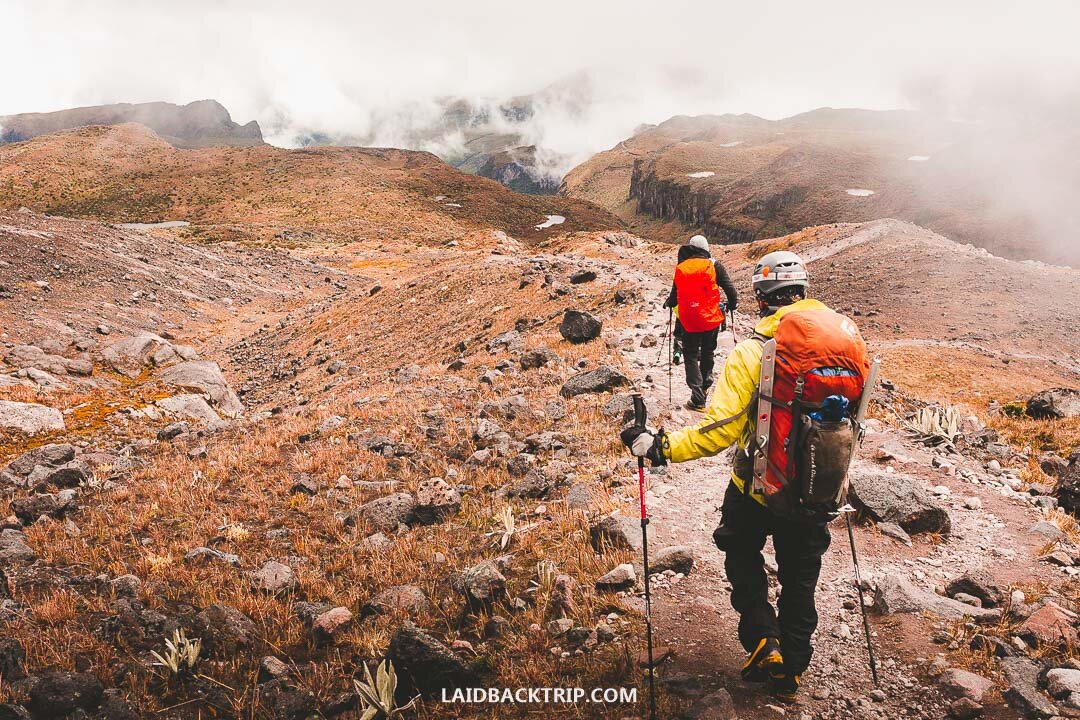
#25 IMPORTED PRODUCTS ARE EXPENSIVE
Imported stuff is expensive not only in Colombia but in general in South and Central America.
Sunscreen , bug repellent , or mouthwash you are used to, will be several times more expensive than in your home country.
And we do not talk about worldwide clothes brands. It is another reason why packing right for your Colombia trip is so essential.
Pack right, and it will save you a lot of money.
#26 YOU ARE GOING TO FALL IN LOVE WITH COLOMBIA
No matter how traveling in a foreign country can be challenging, we have one important announcement to say.
You are going to love Colombia.
It is probably the most significant thing you need to know before visiting Colombia. It will change your life.
People, nature, history, it is all so wonderful that you won't want to leave.
And we think it is really what traveling is all about.
Despite all the differences in life, different opinions, beliefs, traveling brings people closer.
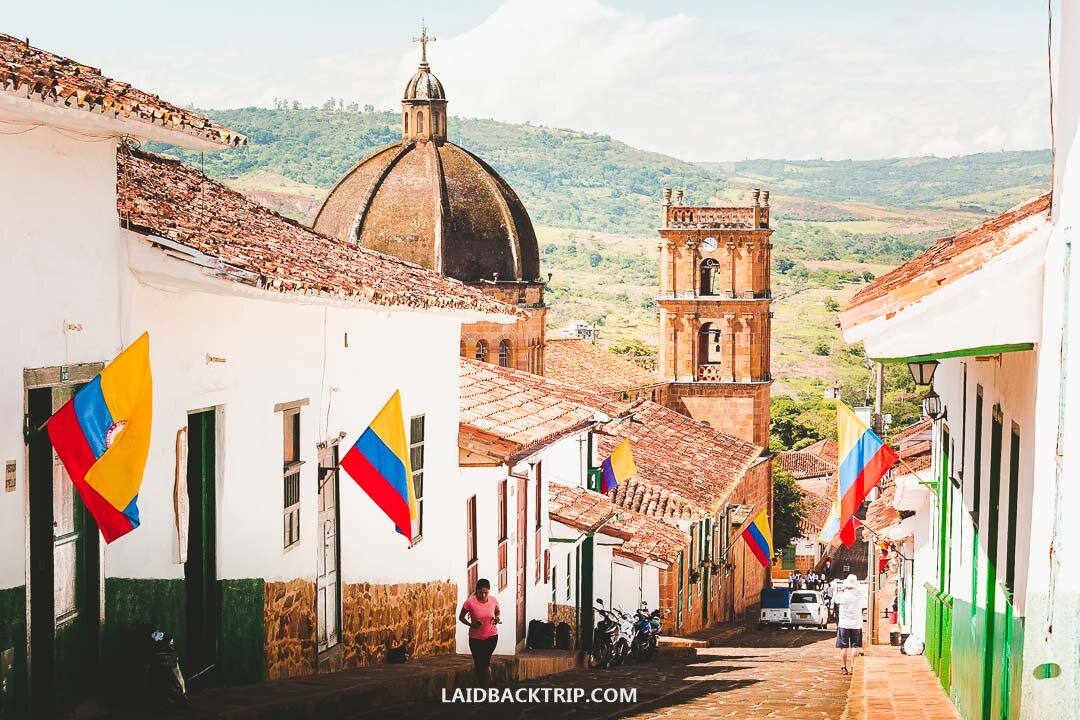
Travel Resources
Here you can find links to all the travel resources we use and which you might find helpful when planning your next holiday.
Accommodation : When looking for accommodation, we usually search hotels via Booking.com or Hostelworld .
Tours : Although we love to travel independently, some places are better to visit with a guided tour.
We prefer GetYourGuide for its easy-to-use interface and solid reputation. Another great alternative is Viator .
Rental Cars : When going on a road trip, we always use Rentalcars.com , a reliable site for booking a rental car in advance.
Flight Tickets : When looking for flight tickets, you can search Skyscanner to find the best price.
Travel Insurance : World Nomads and SafetyWing cover against risks of travel.
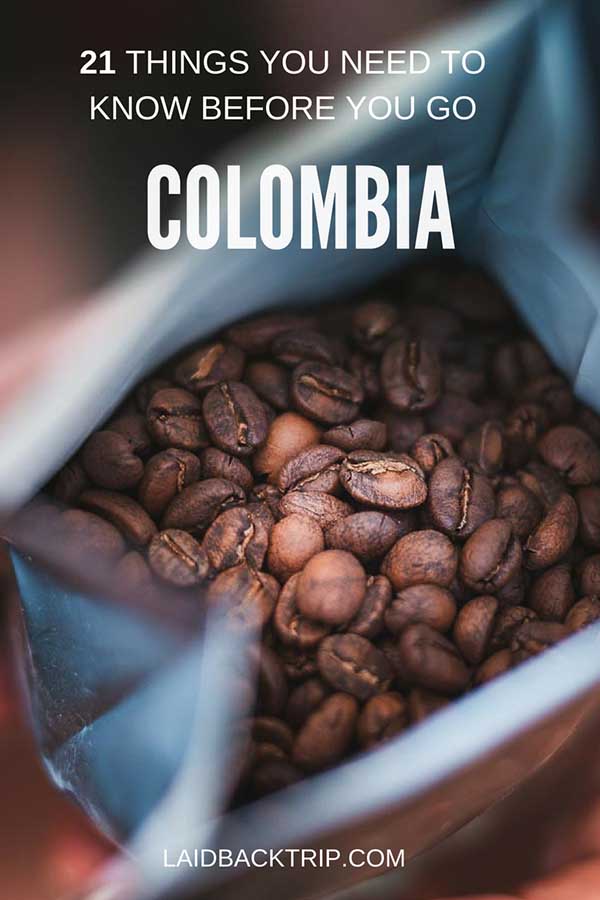
Colombia Travel Guide
Where skyscrapers sit next to quaint pueblos, and dense green rainforests merge with surreal red deserts.
Best time to visit Colombia
Best things to do in colombia, best places to visit in colombia, tayrona national park: best things to do (colombia), 10 best things to do in salento, colombia, best things to do in palomino, colombia, tatacoa desert: colombia’s best kept secret, map of colombia, weather in colombia.
Colombia's location on the Equator guarantees year-round warmth. The best and driest months run from December to March — perfect for sunny adventures. April to November brings more storms but lower prices and a great time to visit for crowd-averse travelers!
Best Cities
13 best things to do in medellin, colombia, 10 best things to do in cartagena, colombia, 15 things to do in bogota, colombia, into nature, cocora valley, colombia: hike along the world’s tallest palm trees, 8 best things to do in minca, colombia, unique places, guatapé: tips for the colorful village and el peñol rock (colombia), best travel insurances, how to travel safe, how to plan a trip.
- Find Hotels via Booking.com
- Find Hostels via Hostelworld
- Find a Rental Car via Sunny Cars
- Find Flights to Colombia via Skyscanner
- Get a Travel Insurance via Heymondo
- Book Tours & Attractions via GetYourGuide
- Book a Bus/Train/Transfer via 12Go
- Get a Visa via iVisa
- How to pack light for your trip
- How to plan your trip our tips
Why is Colombia worth visiting?
Colombia is a captivating destination that seamlessly blends its diverse landscapes, vibrant culture, and warm hospitality. From pristine Caribbean beaches to lush rainforests, rich history, thrilling adventures, and incredible coffee culture, Colombia offers a unique blend of landscapes and experiences perfect for exploring.
Is Colombia cheap to visit?
Colombia is one of the cheapest destinations to travel in South America. Hotels start from around $15 per night, while delicious meals at local eateries cost as little as $3, perfect for those seeking incredible travel experiences without breaking the bank.
Can I drink tap water in Colombia?
It’s a common misconception that tap water is unsafe to drink throughout Colombia, but in most major cities like Cartagena and Medellín, the water is suitable for drinking. However, tap water in rural areas, such as Minca and Tayrona National Park, should be avoided.
Do I need a visa for traveling in Colombia?
Visiting Colombia for less than 90 days? Most passport holders don’t need a visa; you can even fast-track immigration by preloading information about your stay online in advance. Just make sure to have a valid passport and proof of a return/onward ticket, and get ready for your adventure!
Tip: Some countries have stricter visa regulations, so check your entry requirements well ahead of time.
What language do they speak in Colombia?
Spanish is the primary language spoken in Colombia. While English is widely spoken in the tourist areas, it’s worth knowing some basic Spanish words to enhance your connections with Colombian locals.
Do I need travel insurance for Colombia?
Travel insurance is essential when visiting Colombia! It provides crucial protection against unforeseen circumstances, such as medical emergencies, flight disruption, and lost luggage, so that you can discover this incredible country with peace of mind.
Is Colombia safe?
Despite its turbulent history, Colombia is one of the most popular tourist destinations in South America; therefore, an emphasis has been put on traveler safety. Exercise caution by keeping your valuables out of sight and staying in well-traveled areas.
What power plug type does Colombia have?
Colombia primarily uses Type A and Type B plugs. You can use Type A plugs in Type B sockets, but not the other way around. An international plug adapter is a great option, ensuring you always have the correct plug type and keeping you charged during your trip.
Why do people love Colombia?
People love Colombia for its unique blend of diverse landscapes, experiences, and vibrant culture. Whether you’re going to be hiking through the palm-filled landscapes of the Cocora Valley, exploring the colorful streets of Medellín, or relaxing on the beaches of Palomino, there is something for everyone.
Travel to Colombia
Colombia is a country of two sides. Where pristine beaches meet rugged snow-capped mountains, and modern skyscrapers coexist harmoniously next to charming pueblos; a place of unexpected beauty. With a turbulent history of gang rivalry and drug cartels, you’ll now find united communities and smiling locals. This history, combined with its vibrant culture and stunning landscapes, makes traveling Colombia so special.
How to Plan Your Trip to Colombia
Explore our Colombia travel guides to plan your perfect trip! Whether you’re backpacking or looking for the best-kept secrets, we’re here to help. Dive into the best things to do in Colombia, or check our complete 3-week Colombia travel guide and discover this extraordinary country!
Short on time? 2 Weeks in Colombia is the perfect amount of time to tick off the country’s highlights and explore some of the most breathtaking landscapes in the world.
Best Time to Visit Colombia
Planning your backpacking adventure or dream vacation in Colombia? Find out about the weather in Colombia to choose the best month to visit.
Dry Season (December – March): Consider visiting between December and March, the driest months. With minimal rainfall, clear skies, and sunny days, it’s the ideal time to explore Colombia’s stunning landscapes and beaches. However, good weather typically brings larger crowds and higher prices. If you’re planning to visit Tayrona National Park, we’d recommend avoiding December, as locals travel here for the holidays, which can get extremely busy.
Wet Season (April – November): Expect occasional downpours outside these months (April-November), but don’t let that stop you. The off-season is a fantastic time to travel; the temperature is still pleasant, yet prices are typically lower, and there are fewer crowds, so it can be a great time to go on your Colombia holiday!
It’s also worth noting the climate in Colombia varies depending on where you are in the country. Central Colombia is always a little colder than North Colombia, so make sure to pack layers for the cooler temperatures.
Best time to visit Colombia for festivals: If you’re keen to experience the incredible culture, the best time to visit Colombia is during local festivals, such as Carnaval de Barranquilla in February and Medellín’s Feria de las Flores (the Festival of Flowers) in August, offering a unique insight into the traditions of the country.
Whatever time you choose, Colombia promises a rich and diverse experience for every traveler.
Coastlines and Beaches in Colombia
Some of Colombia’s best places to visit are along the Caribbean coast, where you’ll find pristine white sandy beaches and turquoise waters.
One of the best things to do in Colombia is spend the night in Tayrona National Park , home to beautiful beaches, an abundance of wildlife, and dense jungle. Spend your day sipping on freshly picked coconuts, hiking through lush forests, over wooden walkways and boulders, and enjoying the crystal clear waters and incredible marine life. Best of all, end the night sleeping in a hammock under the clear night sky – a true bucket-list experience!
If you’re looking to relax for a few days, Palomino is the perfect spot; a quaint beach town that welcomes the slower pace of life. For a bit more of a buzz, the Baru Islands off the coast of Cartagena is a local favorite, with a lively atmosphere that’s hard to beat.
For off-the-beaten-path adventures, the Pacific coast of Colombia is the ideal place. Home to dense rainforests, rugged beaches, and whale-watching opportunities, this area is a true hidden gem waiting to be explored.
Whether you’re looking for a relaxing vacation in Colombia or a backpacking adventure, the coastlines and beaches cater to all.
Food, Culture, and Religion in Colombia
Colombia is a country where food, art, and festivities hold a special place in the heart of its population, finding any excuse to gather and enjoy home-cooked arepas or take to the streets and salsa dance. But Colombia’s creative expression doesn’t stop there; art is everything, bringing people together and changing the lives of many. Suburbs like Communa 13 in Medellín, once rife with violence, have evolved thanks to the arrival of street art conveying powerful political messages. After seeing these murals, the colors will leave a lasting impression in your memory forever.
In addition to its cultural roots, religion plays a prominent role, with most of the population following the Catholic faith. This influence is evident in the breathtaking churches and cathedrals scattered across the country, like Las Lajas in Pasto, voted one of the world’s most beautiful churches. Additionally, religious events, like Semana Santa (Holy Week), span the country and create a deep connection among its people.
Colombia’s food and coffee scene reflects its vibrant culture, full of diverse flavors, aromas, and colors. From iconic dishes like arepas, bandeja paisa, and buñuelos to regional specialties such as hearty stews in the Andean region and ceviche on the Caribbean coast, Colombian cuisine is a sensory journey. Given its world-renowned coffee culture, it should also be no surprise that Colombia is one of the world’s largest coffee producers, recognized for its rich, full-bodied flavor, a must-try for all coffee lovers while in the country!
Why You Should Travel to Colombia
Some of the planet’s most extraordinary natural experiences can be found on vacation in Colombia. Whether you’re riding through the world’s tallest palm trees, hiking in the Andes, or snorkeling in the crystal clear waters of the Caribbean coast, this country offers endless opportunities for exploration and adventure.
Among these landscapes, discover lost cities, underground salt mines, and puzzling natural phenomena – each with an ancient story that forms the backbone of Colombia’s heritage.
What sets Colombia apart is the availability of travel for all types of budgets. Whether you’re looking to explore diverse landscapes, dive into the rich culture and history, drink endless amounts of coffee, or relax on one of the many tranquil beaches, Colombia is one of the most affordable destinations to experience in South America.
Safety and Travel Advice in Colombia
Colombia is a vibrant and unexpectedly stunning destination in South America with a history of conflict, violence, and political instability. While much of this is in the past, travelers planning a holiday in Colombia should follow precautions to get the most out of this beautiful country.
Natural Disasters: Colombia is susceptible to natural phenomena like earthquakes, hurricanes, and volcanoes. It’s advised to stay informed about local conditions, follow local authorities’ guidance, and consider travel insurance that covers unexpected events.
Crime and safety in Colombia : While violent crime is on the decline, and the country has made significant progress, it’s advised to stick to well-known tourist destinations and exercise caution. Petty theft is still a problem, so always keep valuables out of sight, particularly in busy areas and on public transport. We’d also recommend going out with other travelers at night and not on your own, sticking to well-lit streets.
Learn more about travel safety
Protests in Colombia: Sometimes protests can happen unexpectedly, causing disruption to the area. It’s advisable to steer clear of any of these demonstrations in case they escalate.
Cultural Sensitivity: While Colombians are very warm and welcoming, the country boasts a rich cultural heritage, so respecting local customs is important. Learning a few basic Spanish phrases is always really appreciated. Before taking photographs of local people or their property, always ask permission. And it’s suggested to avoid sensitive topics of conversation such as politics.
Travel Insurance: Before heading on your Colombia holiday, purchasing travel insurance is essential. Petty theft and unexpected accidents, such as lost baggage and injuries, can occur, so it’s always best to protect yourself. Check out these best travel insurances .

Colombia Travel Guide
Your ultimate colombia travel guide, with tips, and things to see and things to do in colombia. great for first-time and returning travelers..
Located between the Caribbean, the Amazon Jungle, and the Andes Mountains, Colombia has something for everyone.
A bright, colorful country, it is a very popular tourist destination and for good reason.
Rich with culture and history and full of tropical climates, it makes a great place for fans of the outdoors or those who want to experience its many beaches and islands.
Add in the vibrant nightlife in cities like Medellin and it is a perfect vacation spot.
This Colombia travel guide will help you plan your next vacation.
Popular Guides
- Things to do in Cartagena
- Must See Cities in Colombia
Our Highlight
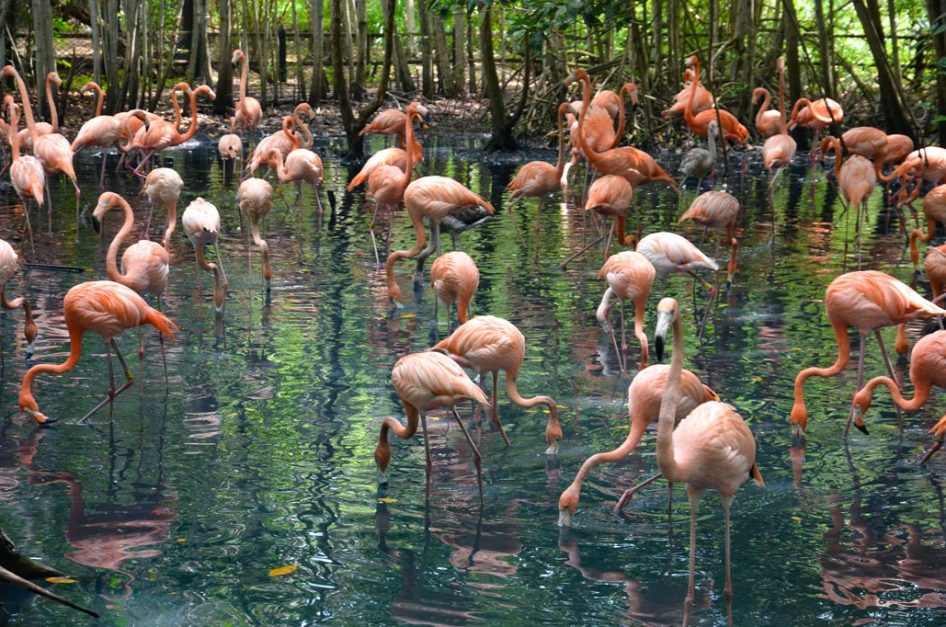
Table of contents
Table of Contents
Fast Facts about Colombia
- Power voltage is 110V at 60 Hz.
- Colombia’s currency is the Colombian Peso and 1 Colombian Peso is equal to 0.0003 USD.
- The best way to get around Colombia is by bus.
- As long as your stay is under 90 days, you do not need a tourist visa, just a valid US passport.
- Popular network providers in Colombia include Claro, Tigo, and Movistar. You can purchase a SIM card through any of these networks by visiting their official stores.
- Colombia has a sales tax rate of 19%.
Things to See and Do in Colombia
Tayrona National Park: Found in the Caribbean Coast of Colombia, head over to the Tayrona National Park to explore beautiful beaches and the Sierra Nevada de Santa Maria, the highest coastal mountain in the world. Once there, you can hike through the hillsides to see Pueblito, a village full of history and sacred sites from an ancient civilization, or go to the rainforest and see a variety of animals and species, including the very rare cotton-top tamarin (monkeys). https://www.beautifulworld.com/south-america/colombia/tayrona-national-park/embed/#?secret=xCh0K8LhzY
Gold Museum: Spend time at this very popular gold exhibition in Bogotá. Take a guided tour to learn more about Colombia and its history or explore at your own pace and see artifacts and gold pieces from pre-Hispanic metallurgy.
Walled City of Cartagena: Feel like you are back in time and explore the bright, colorful streets of Cartagena. Walk past beautiful restored colonial houses and buildings, enjoy fine dining, shop at designer boutique stores, and sample delicious fruits from the fruit stands.
Laguna de Guatape: One of the most popular places in Medellin is the town of Guatape. Take a guided tour or explore on your own. Climb the 700 steps of the El Peñol rock to experience views like no other, see the artwork that decorates the town, visit the abandoned mansion of Pablo Escobar, and swim in the lake of Guatape.
San Andres Island: Spend a day (or more) at this famous coral island. Swim in the warm waters, scuba dive with stingrays, explore the various caves, and take in peaceful sights.
Colombia Travel Guides
- Things to do in Cartagena – Visit the Jewel of Colombia
- Top 5 Must See Cities in Colombia
- 15 Reasons to Visit Colombia
Accommodation
Budget: Colombia offers backpacker hostels with a mix of dorm-styled and private rooms for around 320 to 1,200 Colombian Pesos per night. Hostels tend to come with swimming pools, lounge areas, and/or complimentary breakfast.
Mid-Range: For mid-range hotels, expect to pay 160,000 to 500,000 Colombian Pesos per night. Amenities include air-conditioned rooms and suites, outdoor pools, hotel restaurant and bar, fitness areas, complimentary breakfast, and free Wi-Fi.
High-End: Upscale hotels can go from 650,000 to 1,500,000 Colombian Pesos per night and include top-class hospitality service, upscale rooms with private balconies, prime city locations, ocean views, elegant dining, pools and spas, and more.
Check out our favorite booking platforms Booking.com , Tripadvisor and VRBO for the best deals on accommodation.
Food : The cuisine of Colombia is a mix of Indigenous, African, Spanish, and Arab cuisine and favors rice and bread, legumes, meat and seafood, and a variety of fresh fruits. When out and about, stop by local street vendors to taste some chopped papaya and mangoes or grilled corn on the cob or pastel del pollo (chicken-stuffed pastry) or Obleas con Arequipe (wafer sandwich with caramel sauce). At night, head down to a sit-down restaurant to enjoy more Colombian cuisine. Expect to pay roughly 25,000 Colombian Pesos per day for food.
The Best Ways to Get Around Colombia
Getting to colombia:.
Getting to Colombia: The El Dorado International Airport in Bogotá is Colombia’s busiest airport and is just 9 miles, or a 30 to 60-minute drive, to Bogotá city. If traveling closer to the Amazon region, the Alfredo Vásquez Cobo International Airport is a good option.
Flights: You can check for the best flights to Colombia on Skyscanner .
Transportation:
Train: Colombia has a nonexistent train system for passengers.
Bus: Colombia offers many bus options both for shorter distances and to travel between cities. Long-distance buses are similar to a train and offer air-conditioning and sometimes Wi-Fi. Take a bus from Cali to Bogotá in about 10 hours for 70,000 Colombia Pesos, or take a city bus for 2,000 Colombian Pesos.
Rent a car: To rent a car in Colombia, you will need a valid US license valid for at least two years. Note that is not as recommended to rent a car, as it is considered less safe than taking a bus. If you do rent, make sure to find a rental agency that offers insurance. Prices start at around 400,000 Colombian Pesos per day. Colombia also offers taxi services and Ubers.Check for prices and availability here.
When to go To Colombia
- The best time to visit depends on where you are going. December to March are the driest months in general, which is ideal for those going to the Andes Mountains. If you’re heading to the Amazon region, go between July and August, where there is less rainfall. To avoid the crowds and get better prices on flights and hotels, November is a good month to visit Columbia.
Where to Stay in Colombia
Ibis Medellin : Stay in the heart of Medellin at this stylish hotel. The convention center, Museum of Modern Art, downtown area, and the train station are all just minutes away. Once you’re done exploring, head back to the hotel for free high-speed Wi-Fi, air-conditioned rooms, and the hotel’s bar and restaurant.
Hotel Vilar America: Come stay at this charming hotel situated between the historic and nightlife districts of Bogotá. Enjoy free Wi-Fi and breakfast, family rooms with flat-screen TVs, and the hotel’s restaurant before venturing out in Bogotá.
Hotel Cosmos Cali : Enjoy air-conditioned rooms with flat-screen TVs at this hotel in Cali. Room service, free Wi-Fi, and breakfast are included. Take a short walk to the Cali City Theater or head down to the Cali bullring.
What to Pack for Colombia
- Sunscreen: Protect your skin from the beautiful sun with some sunscreen.
- Hiking Boots: Keep your feet comfortable with a sturdy pair of hiking boots.
- Swimsuit: With so many beaches and waters to explore, make sure to bring a swimsuit with you.
See our packing tips: packing tips
Colombia Travel Guide: Best Booking Resources
Whenever we travel to we make sure to start with these companies. We have tried a lot of different ones over the years and all of these have consistently proven to be the best when it comes to offering great prices.
We have used every one of these personally and continue to do so.
- Booking.com : This is our go site to when comparing prices for accommodation. It usually has the cheapest prices, especially in Europe and we love their interface. Not to mention you get free cancellation and you are guaranteed the best price.
- Trip Advisor : What we like about Trip Advisor is that we can look at all the reviews and then book our accommodation. TripAdvisor is where we go when we want to compare prices with multiple accommodation providers.
- VRBO : is the main search engine we use when we are looking for a home or apartment rental. It can sometimes be cheaper than hotels and it is the best way to stay in areas that offer a more local feel.
- Hostelworld : With one of the largest databases of hostels in the world, Hostelworld is the go-to site when you are looking for budget accommodation.
- Skyscanner : This is the first place we check for flights. It consistently comes back with the cheapest and best options. It allows us to compare a lot of airlines to get the best price.
- Rome 2 Rio : If you want to see how to get somewhere by plane, train, bus, ferry or car Rome2Rio lays it all out for you as well as related costs.I love how they show it all to you on a Google Map and it works offline.
- Get Your Guide: For all your day trip and city guide needs, we use Get Your Guide. It has the world’s largest collection of things to do with more than 30,000 activities in 7500 destinations.
- World Nomads Insurance: When traveling to Italy you should always have travel insurance. We have found the best bang for your buck is by far World Nomads.
Colombia Travel Guide: Related Articles
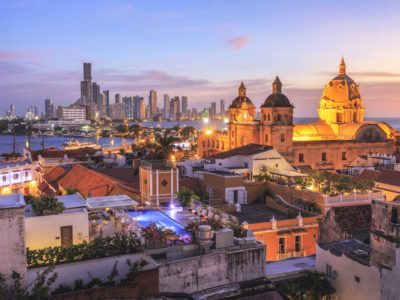
18 Best Things to Do in Cartagena – The Jewel of Colombia
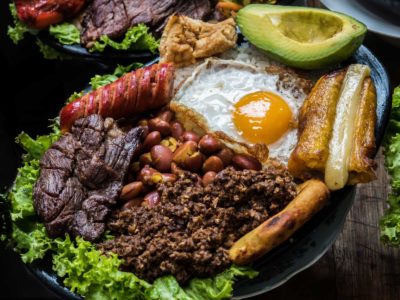
Colombian Food: 28 Traditional Dishes to try in Colombia or at home
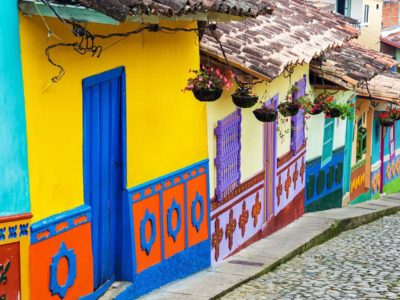
25 Fun Facts About Colombia – Plan Your Trip Today
- Search Please fill out this field.
- Manage Your Subscription
- Give a Gift Subscription
- Newsletters
- Sweepstakes
- Destinations
- Central & South America
20 Best Places to Visit in Colombia, According to Locals and Experts
These are 20 of the best places to visit in Colombia, from colorful villages to stunning beaches.
:max_bytes(150000):strip_icc():format(webp)/carley-rojas-avila1-CarleyRojasAvila1-2d1f25addb774f8d95109e36b51069c4.png)
atosan/Getty Images
A hypnotizing mix of charming coastal cities, world-class cuisine, and lush landscapes hiding immense biodiversity have made the bicoastal country of Colombia one of the most sought-after destinations in the Americas. Spending a long weekend in Cartagena or a few days in Bogotá isn't enough; even after spending months living in Medellín, I felt I barely scratched the surface of all Colombia offers.
With the help of Medellín-based Travel + Leisure A-List advisor Boris Seckovic and locals who work at some of the country's most incredible accommodations, like Bio Habitat Hotel and Casa Pestagua, we've assembled a list of the best places to visit in Colombia. Read on to find the country's most scenic trekking trails, untouched white-sand beaches, and where to get the best cup of Colombian coffee.
Meet the Expert
Boris Seckovic is a T+L A-list advisor and Colombia specialist living in Medellín.
Carolina Bernal is the general manager at Casa San Agustin and Casa Pestagua, luxury hotels located in Cartagena.
Related: 25 Best Places to Visit in South America
Lara D'agostino/Travel + Leisure
Few destinations have done a better job rebranding themselves than Medellín, a vibrant metropolis whose rapid transformation has made it one of South America's most sought-after cities for travelers and digital nomads alike. Laureles was recently named the coolest neighborhood in the world , though travelers might be more familiar with El Poblado as home to some of Colombia's trendiest cafes, restaurants, and bars. Medellín's impressive public transportation network includes several cable cars, making the journey to green spaces like Arvi Park one of the best ways to enjoy breathtaking views of a city that crawls dramatically up the mountainsides of the Aburrá Valley.
Valle de Cocora
John Crux Photography/Getty Images
Don't be surprised if the Valle de Cocora (Cocora Valley) in the heart of Colombia's coffee country looks familiar. This magical area served as the real-life inspiration for Disney's “Encanto,” so you'll be sure to hear the soundtrack's most famous song as you pass through the nearby village of Salento. Despite its new claim to fame, the Valle de Cocora has long been famous for its impressive forest of wax palm trees, which tower high above the valley, growing up to 200 feet tall.
diegograndi/Getty Images
One of the best cities in South America , Colombia's bustling capital city of Bogotá is much more than just a stopover after an international flight. As soon as you arrive, take a funicular or cable car up the Cerro de Monserrate to take in the city views and get your bearings before exploring the historic neighborhood of La Candelaria. Visiting the Museo del Oro (Gold Museum) is a must, as is experiencing the city's increasingly impressive culinary scene at spots like the award-winning El Chato, one of the world's best restaurants .
Stay at the luxurious W Bogotá , named by T+L readers among the best hotels in South America last year, or stop by for their beloved night brunch. The hotel's bold design is a modern interpretation of the legend of El Dorado.
Amazon Rainforest
alfnqn/Getty Images
"Colombia's slice of the Amazon rainforest isn't as well-known as the Amazon in neighboring countries, but it's almost better that way," says Seckovic, who heads Amakuna , the leading specialist for luxury travel in Colombia. "You'll see far fewer people here and have a much better chance of encountering wildlife because of it." Explore the jungle by starting in the regional capital of Leticia, hidden among forest canopy and accessible only by airplane. From there, head to one of the region's ecolodges for biologist-led excursions into the wilderness, where colorful butterflies dart above waters where pink Amazonian river dolphins play.
Santa Cruz de Mompox
Uwe-Bergwitz/Getty Images
Set along the Magdalena River that winds towards Colombia's Caribbean Coast, the colonial village of Santa Cruz de Mompox "feels like what Cartagena used to be," says Seckovic. An important stop along the river used by the Spanish to extract gold, the UNESCO-protected town still retains all its historic beauty, and an artisan filigree jewelry industry points to its golden past. First-of-their-kind cruises along the Magdalena River with AmaWaterways will kick off in 2024, offering a new way to experience the region on routes that twist through the countryside between Cartagena and Barranquilla.
Starcevic/Getty Images
Cartagena is officially Colombia's worst-kept secret. Whether by cruise ship or via newly added flight routes from major U.S. cities, travelers now flock to Colombia's buzziest and most colorful hotspot year-round. A walk along age-old Spanish colonial walls at sunset with glimpses of the glimmering high-rises of Bocagrande in the distance is all you'll need to see why.
Carolina Bernal, general manager at Casa San Agustin and Casa Pestagua , recommends staying in a restored mansion for a look into the city’s past. Longtime Cartagena favorite Casa San Agustin is a gem; its sister property, Casa Pestagua, is a meticulously restored and luxurious 17th-century mansion colloquially known as the most beautiful home in Cartagena.
maphke/Getty Images
Until recently, Isla Barú was mostly a destination for day trippers looking for the best beaches near Cartagena. The recent addition of the Sofitel Barú Casablanca Beach Resort changes all that, making this "island" just 45 minutes from the city an increasingly popular destination all its own. Travelers can also enjoy a beach day or book an overnight at one of the six new cabana-style bungalows at Acasi Private Beach, a luxe extension of Casa San Agustin and Casa Pestagua on the sand.
Eje Cafetero
Anna Haines/Travel + Leisure
Colombia's idyllic coffee-growing region is known as the Eje Cafetero , the "Coffee Axis." This verdant landscape is peppered with grand haciendas and tiny, shaded cafetales where families have long worked the land, and even passersby enjoy the aroma of the world's best coffee. Explore the countryside in a colorful, open-air Jeep Willy, visiting historic villages like Salento, Jardin, and Filandia along the way.
One of the region's coolest places to stay is Bio Habitat Hotel , where luxurious free-standing accommodations are enveloped in rainforest flora and fauna and offer views across the Andes. This eco-conscious, regenerative hotel perched amidst the forest canopy feels a world away, though it's just minutes from the city of Armenia and some of the country's finest artisan coffee farms.
Ciudad Perdida
traffic_analyzer/Getty Images
Tucked within the lush, tropical Sierra Nevada de Santa Marta mountain range, Colombia's Ciudad Perdida ( or “Lost City”) is among the great ancient ruins in South America. There's no easy way to reach Ciudad Perdida; visiting this hidden settlement demands a four-day mountain trek with numerous river crossings. The payoff is well worth it: Just a few dozen intrepid travelers reach this expansive site with its terraced hillsides and circular plazas every day, meaning you'll get to enjoy it almost uninterrupted.
Only a handful of Santa Marta-based tour operators are certified to guide visitors to the site, still cared for by the descendants of the Tairona people who built the settlement centuries ago.
Guatapé and El Peñol
nicolasdecorte/Getty Images
It's impossible to miss El Peñol, a massive monolith towering many stories over the countryside of Antioquia as if dropped from the heavens by a giant. If the climb to the top doesn't take your breath away, the 360-degree views from the top certainly will. Just minutes down the road, the small town of Guatapé has its own flavor of fantasy, with a kaleidoscope of colors and patterns covering the facades of its historic buildings. These twin destinations are an easy day-trip distance from Medellín, but an overnight stay at some of the country's coolest glamping spots is even better.
Caño Cristales
Claudio Sieber/Getty Images
Known as Colombia's "river of five colors," Caño Cristales is home to unique aquatic plants that give it a liquid rainbow effect you must see to believe. When the colorful effect is at peak vibrancy between July and November, the river seems to run green, magenta, purple, maroon, and canary yellow simultaneously. The river is located in the relatively isolated Serranía de la Macarena National Park, though locals attest it's well worth the trip to see one of the world's strangest natural wonders.
Related: Visiting Caño Cristales, Colombia's Liquid Rainbow
mehdi33300/Getty Images
The village of Barichara is arguably Colombia's prettiest. Barichara is a bit further from the country's major cities than other historic gems like Villa de Leyva, so "it's stunningly beautiful, but still not too touristy," says Seckovic. The town made T+L's list of the best hidden gem destinations to visit last year and is conveniently located just a stone's throw from San Gil, the undisputed capital of adventure travel in Colombia.
Tayrona National Park
Rodrigo A. Rodriguez Fuentes/Getty Images
In Tayrona National Park, Colombia's best beaches line untouched jungles with enough endemic flora and fauna to make any eco-conscious traveler swoon. Take a skippered sailing excursion to the park directly from Santa Marta, with stops at spots like Bahia Concha and Cabo San Juan for swimming, snorkeling, and sunbathing. More adventurous travelers can trek through the park and camp in hammocks perched directly over white sands.
Rosario Islands
“The Rosario Islands, or Islas del Rosario, are known for coral reefs and year-round diving and snorkeling opportunities," says Bernal of this perennially popular destination located off the coast of Cartagena. Hop on a speedboat in town and escape to eco-friendly boutique hotels tucked away on sandy shores, offering some serious rest and relaxation far from the crowds. It's an affordable and laid-back alternative to the built-up Caribbean islands where you would spend your days fighting for beach chairs.
Barranquilla
Roxana Charris/Long Visual Press/Universal Images Group via Getty Images
Among the cities on Colombia's Caribbean Coast, Barranquilla can't compete with buzzy, beautiful Cartagena. However, for one week a year, Colombia lives and breathes to the rhythms of the Carnival of Barranquilla. Folkloric dance, music, and rich, regional food shine among a packed schedule of events including the Battle of the Flowers, the Great Troupes Parade, and the Death of Joselito Carnival, each more vibrant than the last. It's such an essential spectacle that it made the UNESCO list of Intangible Cultural Heritage of Humanity .
Related: T+L's Guide to Colombia's Caribbean Coast
Antoine Barthelemy/Getty Images
The small city of Popayán still flies under the radar of most travelers, but it's all the better for it. Known as Colombia's "White City" for its grand historic center's whitewashed facades, this laid-back town feels like a breath of fresh air for travelers with an itinerary packed with just the country's biggest highlights. It's a great first stop on a road trip north through cities like Cali and to the haciendas and villages that make the Eje Cafetero so memorable.
Tatacoa Desert
oscar garces/Getty Images
The Tatacoa Desert is the second-largest arid environment in Colombia, after the dune-studded La Guajira at the northern tip of South America. However, Tatacoa isn't a desert at all, but a long-dry tropical forest where lush flowers bloomed a millennium ago. Its unexpected past makes fossil-hunting a perfect pastime on hikes through its dramatic red canyons. Tatacoa's remote location and ideal atmospheric conditions also make it one of South America's best destinations for stargazing .
alarico/Getty Images
Known as the capital city of salsa, Cali is the best place to visit in Colombia if you want to settle into several days of lessons to truly master these sensual steps. Zaperoco Bar is one of Cali's most famous salsa clubs, while Siboney — its name pointing to the rhythm's original Cuban roots — has long been one of Cali's salsa institutions. Fill your dance breaks by exploring the city's historic center and with day trips through the Valle del Cauca for river tubing, ziplining, and waterfall hikes.
Judith Engbers/Getty Images
Tucked away within Utría National Natural Park on a remote stretch of Colombia's Pacific Coast, the tiny beach town of Nuquí is known as one of the best places in the country for whale watching. Between July and October, humpback whales travel from Antarctica to these warmer waters to give birth to their babies in the region's protected lagoons. Whale watching is the undisputed highlight for most travelers visiting Nuquí, but adventurous travelers will love surfing near jungle-fringed shores and hiking to long-hidden rainforest waterfalls.
San Andrés and Providencia
tifonimages/Getty Images
Search for the islands of San Andrés and Providencia on a map, and you'd be forgiven for thinking they were a part of Central America. These tiny, remote islands over 450 miles from the Colombian mainland sit within a stretch of sea so azure it's called the "Sea of Seven Colors," and they are home to some of Colombia's last truly untouched beaches. Livelier San Andrés and more unspoiled Providencia are little-visited, idyllic destinations worth considering for your next unplugged, unbothered Caribbean getaway.
Related Articles
We’re sorry, this site is currently experiencing technical difficulties. Please try again in a few moments. Exception: request blocked
Nomadic Matt's Travel Site
Travel Better, Cheaper, Longer
Is Colombia Safe to Visit?
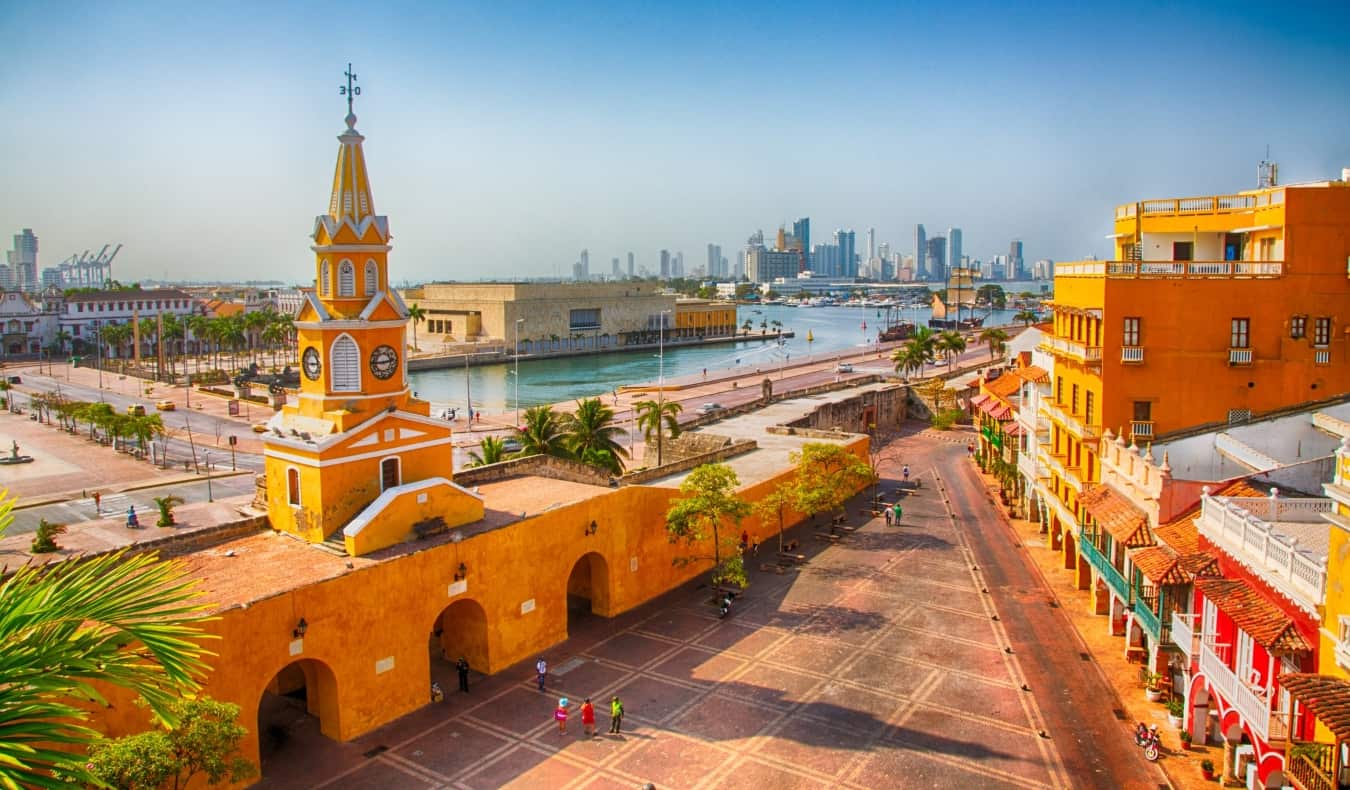
Colombia is one of the most popular countries in South America for backpackers and travelers. In 2022, it saw over 4.6 million visitors — a huge increase from the early 2000s, when just 700,000 visitors came to Colombia each year .
Over the past few decades, Colombia has been working hard to dispel the violent image it earned thanks to the drug cartels that once ravaged the country.
While Colombia still isn’t perfect, it’s come a long way since our parents’ generation . Between the 1970s-1990s, Colombia’s position as an epicenter of cocaine production and trade led to the rise of drug trafficking cartels and associated violence.
Thankfully, violent crimes that were once common here, such as murder and kidnapping, have decreased. Kidnapping has declined by 92% and homicides are down by 50% over the past two decades.
Slowly but surely, conditions in Colombia are improving for locals and tourists alike.
So, as long as you stay in well-traveled areas and mind the advice from locals you can still enjoy traveling here (this is actually one of those times when you want to consider staying on the ‘beaten path’).
But a lot of people still ask me: is Colombia safe? So, here’s everything you need to know about staying safe in Colombia.
Table of Contents
My Experience in Colombia
10 safety tips for colombia.
- Is Colombia Safe for Solo Travelers?
Is Colombia Safe for Solo Female Travelers?
- Are Taxis Safe Colombia?
Is the Food Safe in Colombia?
Can you drink the tap water in colombia, should you visit colombia.
Before I went to Colombia, I’d heard countless stories of petty theft. While there, I heard even more. A friend of mine had been robbed three times, the last time at gunpoint while on his way to meet me for dinner.
Locals and expats alike told me the same thing: the rumors of petty theft are true, but if you keep your wits about you, follow the rules, and don’t flash your valuables, you’ll be OK.
There’s even a local expression about it: “No dar papaya” (Don’t give papaya). Essentially, it means that you shouldn’t have something “sweet” out in the open (a phone, computer, watch, etc.) that would make you a target. Keep your valuables hidden, don’t wander around places you shouldn’t at night, don’t flash money around, avoid coming out of nightlife spots alone at night, etc. Simply put: don’t put yourself in a position where people can take advantage of you.
I heeded such advice. I didn’t wear headphones in public. I didn’t take my phone out unless I was in a group or a restaurant, or completely sure no one else was around. I took just enough money with me for the day when I left my hostel. I warned friends about wearing flashy jewelry or watches when they visited.
But the longer you are somewhere, the more complacent you get.
When you see locals on their phones in crowded areas, tourists toting thousand-dollar cameras, and kids wearing Airpods and Apple Watches, you begin to think, “OK, during the day, maybe it’s not so bad.”
Suddenly, you step out of a café with your phone out without even thinking about it.
You’re giving papaya.
And someone wants to take it.
Which is how I ended up getting mugged and knifed . (I’m OK.)
This was also just a matter of being unlucky and not specific to Colombia. A wrong-time-wrong-place situation. It could have happened to me anywhere where I didn’t follow the safety rules that help you minimize risk.
The experience reminded me of why you can’t get complacent. I gave papaya. I shouldn’t have had my phone out. It didn’t matter the time of day. That’s the rule in Colombia. Keep your valuables hidden. (Especially in Bogotá, which does have a higher rate of petty crime (though a lower homicide rate) than elsewhere in the country.) I didn’t follow the advice.
And I got unlucky because of it. I’d been having my phone out too often and, with each non-incident, I grew more and more relaxed. I kept dropping my guard.
What happened was unlucky, but it didn’t need to happen if I had followed the rules.
This is why people warned me to be careful.
So, if you follow the rules and take appropriate precautions, you’re unlikely to have a problem. I’m not going to let this freak incident change my view of such an amazing country. I’d go back to Colombia the same way I’d get in a car after a car accident. In fact, I was terribly upset to leave. I was having an amazing time.
I still love Bogotá . I still have plans to go back to Colombia.
Learn from my mistake. Not only for when you visit Colombia but when you travel in general.
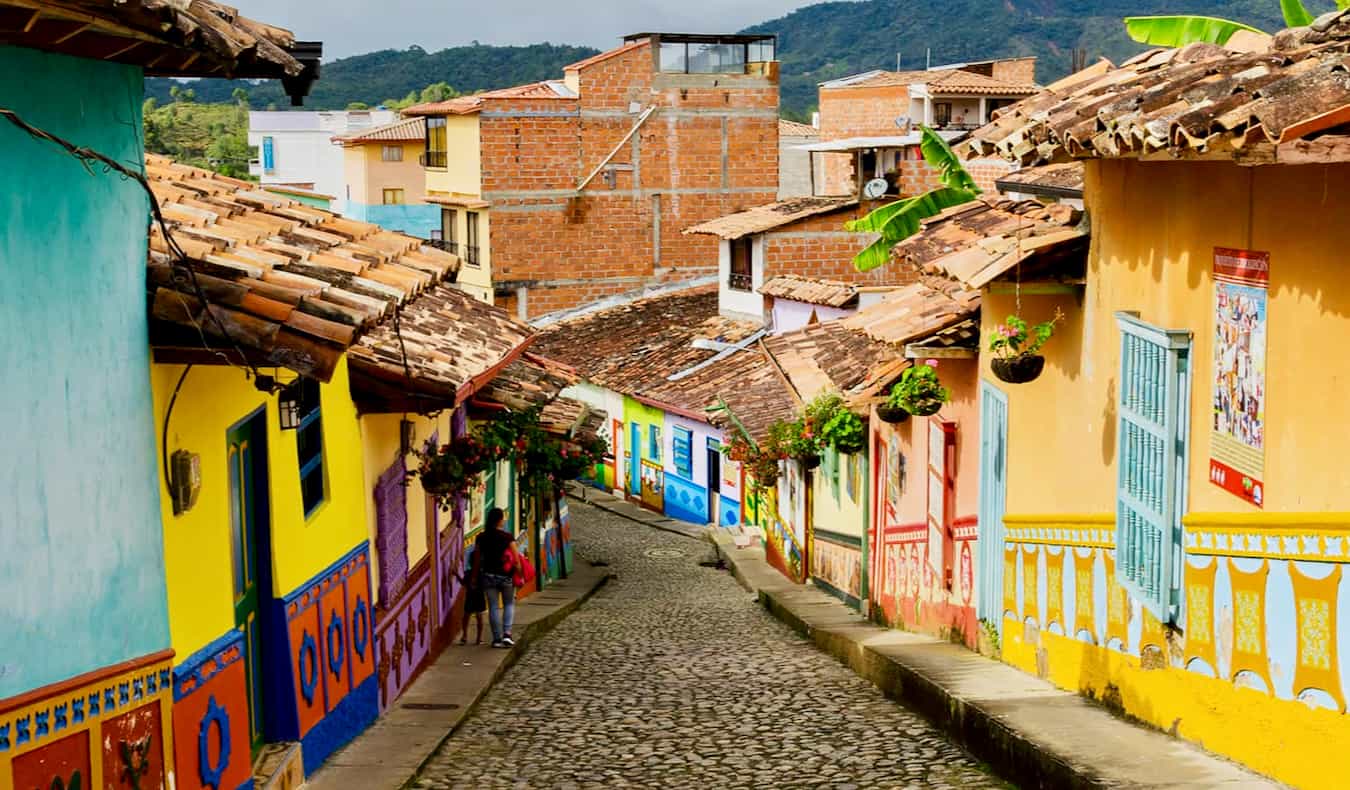
1. Stay somewhere with 24-hour security – You always want someone around in case you need assistance. Most hostels and hotels have security cameras or guards. If you don’t feel safe somewhere, don’t hesitate to move on. This way you always have someone to talk to in case something goes wrong.
2. Don’t flash your belongings while you’re out and about – Keep your phone out of sight, and don’t wear any jewelry or watches. If you need to use your phone, do it inside and not out on the street. This is where people get in the most trouble. This is how I got into trouble. Put everything away so you don’t stand out.
3. Don’t travel alone at night – Try to go out with other travelers if you’re going out at night. Also, if you’re out, watch your drink and don’t leave it unattended and be cautious when using dating apps. If you do plan to go out alone or party late, be sure to take an Uber home or have someone call you a cab. Don’t walk alone really late at night.
4. Learn some Spanish – Even just a few phrases can help you in an emergency. Download Spanish on the Google Translate app so you have it offline as well, just in case.
5. Download an offline map of the city – Having a map will be helpful in case you get lost and need to guide yourself (or a taxi driver) back to your accommodation. If you use your phone at night, be sure to not use it out in the streets.
6. Don’t do drugs – The drug cartels have crippled this country. Don’t support them by buying drugs. Locals don’t like it because drugs have devastated the country and doing it just further harms the country. It’s really disrespectful. Additionally, getting involved with drugs here increases your chances of getting into trouble. Finally, doing drugs here is illegal, and you don’t want to end up in a Colombian prison.
7. Keep your valuables separate – When you’re going out for the day, leave some credit cards and cash locked in your accommodation. That way, if you lose your wallet, you’ll still have cash and cards back at your hostel. In general, it’s a good idea to make photocopies of your passport to take with you and lock up your passport in your hostel locker. Keep digital copies of your passport in your email inbox too just in case.
8. If the worst happens, just give the attacker your stuff – Handing over your things is much better than risking the alternative (trust me). If you have travel insurance , you’ll be able to get reimbursed (just be sure to save all of your receipts).
9. Download the Prey app to your phone and laptop – If either device gets stolen, you’ll be able to track it and remotely turn on your camera to photograph the thief (you can also wipe the data and message the thief too). It costs just $1.10/month.
10. Buy travel insurance – If something does go wrong, you want to be sure you’re covered and someone has your back. Travel insurance can help you find medical treatment and give you money to buy replacements for what was stolen. It’s always better to be safe than sorry, especially in a country where petty crime is still a problem.
We recommend Safety Wing for travelers under 70, while Insure My Trip is the best choice for travelers over 70.
You can check out this widget to get a quote for Safety Wing:
For more information on travel insurance, check out these posts:
- What Does Travel Insurance ACTUALLY Cover?
- The Best Travel Insurance Companies
- How to Buy the Best Travel Insurance
So, is Colombia Safe for Solo Travelers?
Colombia can be safe for solo travelers if you take the right precautions. While petty crime is still a problem, as long as you don’t flaunt your valuables, you’ll likely not run into any problems. When you go out, only take what you need for the day and leave your other valuables in your hostel or hotel room.
If you’re not feeling comfortable, try to meet other travelers at hostels or on tours so you can explore together. That way you’ll never be alone and will avoid being a target for pickpockets and petty criminals.
At night, make sure you’re never traveling alone and that you have your ride home planned in advance. Don’t get into sketchy cabs. Avoid wandering around non-touristy areas at night and alone. If you’re using dating apps, exercise caution as there have been instances of tourists being drugged and robbed.
I never felt really unsafe in the country during the day or in public places. You’ll see locals with phones out and, generally, going about their life. It’s really at night that you have to be careful.
While solo female travelers should take some extra precautions in Colombia, the country should definitely still be under consideration for women traveling on their own.
Whenever possible, avoid traveling alone — especially at night or in areas where there are not many people. Don’t flaunt any valuables, and avoid taking taxis alone at night.
Always watch your drinks in a bar and don’t accept drinks from people you don’t know.
Always have a downloaded map and translator so you can find your way home or ask for help if you need it.
By taking some precautions and planning accordingly, solo female travelers will be able to have a rewarding time traveling in Colombia. Just make sure to follow the advice and tips above!
Here are a couple of helpful posts on safety written by our solo female travel experts:
- How to Stay Safe as a Solo Female Traveler
- 8 Myths About Solo Female Travel Debunked
- 10 Common Questions About Solo Female Travel
Are Taxis Safe in Colombia?
Taxis are safe here, but always make sure you call your taxi in advance or use an app like EasyTaxi. Never get into a random vehicle. Even if it looks like a taxi, it might not be one. It’s always better to play it safe.
Get your hostel or accommodation to call a cab for you, or download a taxi app (Uber is available in major cities in Colombia, including Cartagena , Medellín , Cali , and Bogotá ) so you can order your own. Avoid taking taxis at night as well (especially as a solo female traveler).
The food in Colombia is quite safe. Just make sure to avoid any food that’s been sitting out in the sun all day. Look for places with lots of patrons — that’s how you can tell the food is fresh and delicious.
Also, make sure any fruit you eat has a peel to avoid it getting contaminated.
If you’re a vegetarian or have other dietary concerns, you might be hard-pressed to find food outside of the major cities, as most dishes are meat-based. Learn some basic phrases (or download Google Translate) to help you ask questions and find foods suitable for your diet.
Lastly, always wash your hands before you eat. That’s the best way to avoid getting sick!
While improvements in water treatment are coming along, you can’t really drink the water outside of Bogotá and Medellín.
I’d suggest you travel with a Lifestraw so you can purify water no matter where you are. That will help you save money and reduce your reliance on single-use plastic. Double win!
So, is Colombia safe?
That depends on how you act, where you go, and if you follow the tips above.
While petty theft is a growing concern and there has been a slight uptick in crime, the country has so much to offer the intrepid traveler. There is amazing nature, vibrant cities, a fun nightlife, and a growing community of entrepreneurs and digital nomads who call Colombia home .
It’s cheap and easy to navigate, and as long as you follow your instincts and use common sense, you will avoid trouble.
So, while my personal experience in Colombia didn’t end well, I definitely plan on going back.
Because it’s just too amazing a place not to visit.
Book Your Trip to Colombia: Logistical Tips and Tricks
Book Your Flight Use Skyscanner to find a cheap flight. They are my favorite search engine because they search websites and airlines around the globe so you always know no stone is left unturned!
Book Your Accommodation You can book your hostel with Hostelworld as they have the biggest inventory and best deals. If you want to stay somewhere other than a hostel, use Booking.com as they consistently return the cheapest rates for guesthouses and cheap hotels.
Don’t Forget Travel Insurance Travel insurance will protect you against illness, injury, theft, and cancellations. It’s comprehensive protection in case anything goes wrong. I never go on a trip without it as I’ve had to use it many times in the past. My favorite companies that offer the best service and value are:
- Safety Wing (best for everyone)
- Insure My Trip (for those over 70)
- Medjet (for additional evacuation coverage)
Looking for the Best Companies to Save Money With? Check out my resource page for the best companies to use when you travel. I list all the ones I use to save money when I’m on the road. They will save you money when you travel too.
Want More Information on Colombia? Be sure to visit our robust destination guide to Colombia for even more planning tips!
Got a comment on this article? Join the conversation on Facebook , Instagram , or Twitter and share your thoughts!
Disclosure: Please note that some of the links above may be affiliate links, and at no additional cost to you, I earn a commission if you make a purchase. I recommend only products and companies I use and the income goes to keeping the site community supported and ad free.
Related Posts
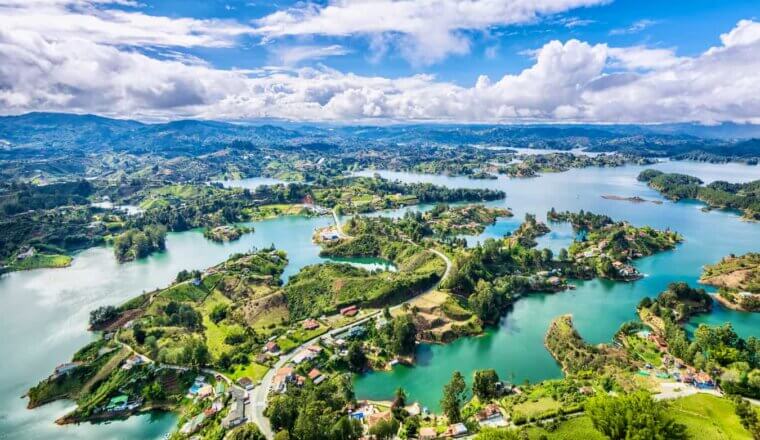
Get my best stuff sent straight to you!
Pin it on pinterest.
Update May 10, 2024
Information for u.s. citizens in the middle east.
- Travel Advisories |
- Contact Us |
- MyTravelGov |
Find U.S. Embassies & Consulates
Travel.state.gov, congressional liaison, special issuance agency, u.s. passports, international travel, intercountry adoption, international parental child abduction, records and authentications, popular links, travel advisories, mytravelgov, stay connected, legal resources, legal information, info for u.s. law enforcement, replace or certify documents.
Share this page:
Colombia Travel Advisory
Travel advisory january 2, 2024, colombia - level 3: reconsider travel.
Reissued with updates to the country summary.
Reconsider travel due to crime and terrorism . Exercise increased caution due to civil unrest and kidnapping . Some areas have increased risk. Read the entire Travel Advisory.
Do Not Travel to:
- Arauca, Cauca (excluding Popayán), and Norte de Santander departments due to crime and terrorism.
- The Colombia-Venezuela border region due to crime, kidnapping, and risk of detention when crossing into Venezuela from Colombia.
Country Summary: Violent crime, such as homicide, assault, and armed robbery, is widespread. Organized criminal activities, such as extortion, robbery, and kidnapping, are common in some areas.
Terrorist groups and criminal organizations continue operating and carrying out attacks in Colombia. They may attack with little or no warning, targeting transportation hubs, markets/shopping malls, local government facilities, police stations, military facilities, hotels, clubs, restaurants, airports, other public areas, and U.S. government facilities.
Demonstrations occur regularly throughout the country and can be about a variety of political or economic issues. They can shutdown roads and highways, often without prior notice or estimated reopening timelines. Demonstrations and road closures may significantly reduce access to public transportation and may disrupt travel within and between cities. Protests can become violent and can result in fatalities and injuries.
U.S. direct-hire government employees must adhere to the noted restrictions:
- They are not permitted to travel by road between most cities.
- Colombia’s land border areas are off-limits to U.S. government personnel unless specifically authorized.
- They may not use motorcycles.
- They may not hail street taxis or use public buses.
Read the country information page for additional information on travel to Colombia.
If you decide to travel to Colombia:
- Avoid protest areas and crowds.
- Monitor local media for breaking events and adjust your plans based on new information.
- Keep a low profile.
- Be aware of your surroundings.
- Enroll in the Smart Traveler Enrollment Program (STEP) to receive Alerts and make it easier to locate you in an emergency.
- Follow the Department of State on Facebook and Twitter
- Review the Country Security Report for Colombia.
- Prepare a contingency plan for emergency situations. Review the Traveler’s Checklist .
Arauca, Cauca, and Norte de Santander Departments – Level 4: Do Not Travel
Violent crime, including armed robbery and homicide, is widespread. Terrorist groups are active in some parts.
The U.S. government has limited ability to provide emergency services to U.S. citizens as U.S. government-personnel travel to these areas is severely restricted due to security concerns.
Colombia - Venezuela Border – Level 4: Do Not Travel
U.S. citizens are advised not to travel to the border of Colombia and Venezuela. U.S. citizens are at risk of detention when crossing into Venezuela.
The Colombia-Venezuela border is not clearly marked, and U.S. citizens should not go near the border due to the risk of crossing into Venezuela accidentally.
U.S. citizens attempting to enter Venezuela without a visa have been charged with terrorism and other serious crimes and detained for long periods. For more information, see the Venezuela Travel Advisory.
Visit our website for Travel to High-Risk Areas .
Travel Advisory Levels
Assistance for u.s. citizens, colombia map, search travel advisories, external link.
You are about to leave travel.state.gov for an external website that is not maintained by the U.S. Department of State.
Links to external websites are provided as a convenience and should not be construed as an endorsement by the U.S. Department of State of the views or products contained therein. If you wish to remain on travel.state.gov, click the "cancel" message.
You are about to visit:
Colombia Travel Restrictions
Traveler's COVID-19 vaccination status
Traveling from the United States to Colombia
Open for vaccinated visitors
COVID-19 testing
Not required
Not required for vaccinated visitors
Restaurants
Not required in enclosed environments and public transportation.
Colombia entry details and exceptions
Documents & additional resources, ready to travel, find flights to colombia, find stays in colombia, explore more countries on travel restrictions map, destinations you can travel to now, dominican republic, netherlands, philippines, puerto rico, switzerland, united arab emirates, united kingdom, know when to go.
Sign up for email alerts as countries begin to open - choose the destinations you're interested in so you're in the know.
Can I travel to Colombia from the United States?
Most visitors from the United States, regardless of vaccination status, can enter Colombia.
Can I travel to Colombia if I am vaccinated?
Fully vaccinated visitors from the United States can enter Colombia without restrictions.
Can I travel to Colombia without being vaccinated?
Unvaccinated visitors from the United States can enter Colombia without restrictions.
Do I need a COVID test to enter Colombia?
Visitors from the United States are not required to present a negative COVID-19 PCR test or antigen result upon entering Colombia.
Can I travel to Colombia without quarantine?
Travelers from the United States are not required to quarantine.
Do I need to wear a mask in Colombia?
Mask usage in Colombia is not required in enclosed environments and public transportation.
Are the restaurants and bars open in Colombia?
Restaurants in Colombia are open. Bars in Colombia are .

13 Important Tips For First-Timers Visiting Colombia
- Eat at the hotel for cleanliness and safety.
- Bring enough cash for daily activities, especially in remote areas.
- Learn basic Spanish to navigate the country and communicate effectively.
Visiting Colombia for the first time can be exciting, but just like any destination worldwide, there are some tips one needs to know before visiting. Language, weather, money, and transportation can be quite confusing, especially in Colombia. Still, with these tips, one will be able to avoid a lot of difficult situations in the country. It doesn't matter if you're here for ten days or three; Colombia is a gorgeous country with endless things to experience. Whether it's someone's first time or they need a refresher, you can't go wrong with following these essential tips for traveling to beautiful Colombia!
UPDATE: 2023/11/25 16:36 EST BY NOAH STAATS
There Are More Things To Know When Visiting Colombia
This article has been refreshed with new information regarding a trip to beautiful Colombia, as well as expanded talking points for previous suggestions. Remember to stay out of bad neighborhoods at night, bring enough cash for day trips, learn some Spanish, and have plenty of fun!
Eat At The Hotel If You're Worried About Cleanliness
For those coming to Colombia and nervous about food and water cleanliness, it's always a safe bet to eat with your hotel or resort and get water via gift shops inside them. Although most places in bigger Colombian cities are clean and safe, some smaller villages do not abide by strict health and sanitation regulations when preparing or serving food and drinks. To steer clear of food-borne illness, make sure and book restaurants with good reviews and clean kitchens/dining rooms.
- It's generally better to eat at the hotel if you're staying somewhere off the beaten path.
Tayrona National Park is a fun day trip idea for visitors to Colombia.
Make Sure And Keep Some Cash Ready
One thing many visitors to Colombia forget is to bring enough cash for daily activities. Because debit and credit cards are often not accepted or take a large conversion fee, getting cash from the bank or at your hotel may be the better option. Of course, in bigger cities, there will be more accessibility and availability to ATMs and stores taking credit cards, but in remote towns and villages: bring cash.
That said, keep all cash somewhere safe and hard to get to. Pickpocketing is prevalent here, as well as violent assault in poorer areas.
- Because of steep ATM and credit card fees, it's best to bring enough money for everyday food, attractions, and transportation when visiting Colombia.
Learn Some Spanish Words
Colombia is a place where the majority of the population speaks only Spanish. In a place like Bogotá - the capital city , most people only speak Spanish, which means it can be difficult to get around if one only knows English. While one does not necessarily need to know how to speak the language, some basic words will go a long way and help one better get around the country.
- Learning basic Spanish will go a long way when coming to Colombia.
Taxis Are Cheap, But Buses Are Cheaper And Safer
Buses are Colombia's main means of transportation, and they are incredibly cheap and safe. Taxis, on the other hand, are also cheap, but a few inconveniences come with them. First, they can be unsafe, as fake taxi drivers can rob passengers. Apps such as Uber and Easy Taxi are illegal in the country, but they are still in operation and are the safest ways to get taxis.
- Taking the bus is often cheaper and safer than taxis while in Colombia.
Avoid Lonely Areas, Especially At Night
Just like many other amazing destinations worldwide, Colombia experiences increased crime, which is why one must exercise extreme caution when visiting. A good rule is avoiding lonely areas, especially at night. For the first trip, travelers can stick to the popular tourist destinations around the country, which are usually more crowded, to avoid being an easy target.
- Tourists to Colombia are not recommended to venture out into lonely/quiet areas at night.
Avoid Unnecessary Display Of Wealth
Showing unnecessary displays of wealth, especially in a country like Colombia, may be dangerous. The country's economy is bad, which has made many people living there desperate. It is advisable to avoid putting on too many accessories or carrying large amounts of money around to avoid drawing too much attention to oneself.
- Wearing fancy clothes, jewelry, or other accessories in Colombia can get you into trouble at night or in certain areas.
Prepare An Itinerary To Follow Before Visiting
Colombia is very big and endowed with plenty of natural and man-made attractions, which means there are plenty of things to see and do here. Without a proper itinerary of what to do in the country, one can find it difficult to get the most out of their visit. During the planning process, make a list of things to do in the country and follow that itinerary when in the country. There will be more to do, but it is better to have a plan rather than randomly deciding what to do.
- Planning before you come here can help ease frustration due to Colombia's vast offerings.
Related: 10 Best Places To Visit In Colombia
The Weather Can Be Unpredictable, So Come Prepared
Colombia experiences two major seasons, which are rainy and dry. But the weather is not usually not dependent on the time of the year but on elevation. The weather can easily change from sunny to rainy in some parts of the country with higher elevations, like Bogotá. The temperature is also known to sometimes rise from as low as 4 degrees Celsius to 19 degrees Celsius on some days. Some parts of the country, such as Cartagena and Santa Marta, experience lots of sunshine all year round. This means at any time of the year; one can experience all four seasons in Colombia. With such diverse and unpredictable weather, one has to come prepared to face any type of weather in this country.
- The weather is unpredictable in Colombia, with wild changes in temperature being common.
Never Talk About Drugs, Especially Cocaine
One important thing to always avoid doing in Colombia is talking about drugs. Drug production and trafficking continue to increase in this country, and drug is always accompanied by crime. This makes it not just a national issue but a global issue for which Colombia plays a major role as it is one of the major producers of cocaine in the world. In 2021, the production of coca leaves which is the main ingredient for cocaine, increased drastically. To avoid getting into a difficult situation, pretend not to know anything about drugs in Colombia and instead focus on enjoying the amazing things the country has to offer.
- Joking or discussing cocaine can and will get you in trouble with law enforcement in Colombia.
Haggle Before Buying Something
The asking price of a product in Colombia may not always be the actual price but just the seller trying to get more profit from tourists who may not know the price. To avoid getting ripped by sellers (who always know a gringo when they see one), employ the skill of bargaining when purchasing something. Buying something $5 less than the initial asking price is not uncommon.
- It's worth it to try and bargain with vendors while shopping in Colombia.
Altitude Sickness Is Real In Colombia
In Colombia, like many parts of South America, high altitude is something that one often has to worry about as the country is filled with many mountains. Bogota, the country’s capital, rises to an elevation of 8,660 feet , making it one of the highest cities in the world. One important tip to help deal with altitude sickness in Colombia is to always stay hydrated when heading to places with high altitudes. Adventurers seeking to go rock climbing or visit higher places can also include other substances like vitamins and minerals to cushion the effects of the high altitudes. Alcohol, caffeine, and other dehydrating substances should also be avoided when heading to higher elevations.
- Because of the possible 8,660 feet of elevation in Colombia, it's not uncommon for altitude sickness to ravage through groups vacationing to the country.
Related: Tips To Avoid The Altitude Sickness While Traveling In South America
It’s Not Mandatory To Tip
In hotels, bars, restaurants, and other service centers around Colombia, tipping is not usually mandatory or expected, unlike in other countries. Nicer restaurants usually include a 10% service charge automatically on the bill. Of course, if the service was exceptional, it does not hurt to give the service person some extra change. Tipping taxi drivers is also not a thing as passengers are only required to pay the amount on the meter; still, the extra tip is always appreciated. In most cases, tips cost between 2,000 and 5,000 Columbian Pesos, equivalent to a dollar. That's like nothing to most tourists, but the locals in Colombia appreciate it so much.
- Adding a tip (although appreciated) is not required in Colombia.
Be Careful On The Roads
The traffic in Colombia can be chaotic. Drivers here are usually impatient and aggressive and won’t stop for anybody. To avoid getting into a dangerous situation on the road, it is important to be careful on the roads. With dangerous roads and long traffic jams, it will be better to avoid driving in Colombia and just stick to using taxis and buses.
- Driving can be difficult here, especially regarding other impatient and volatile drivers.
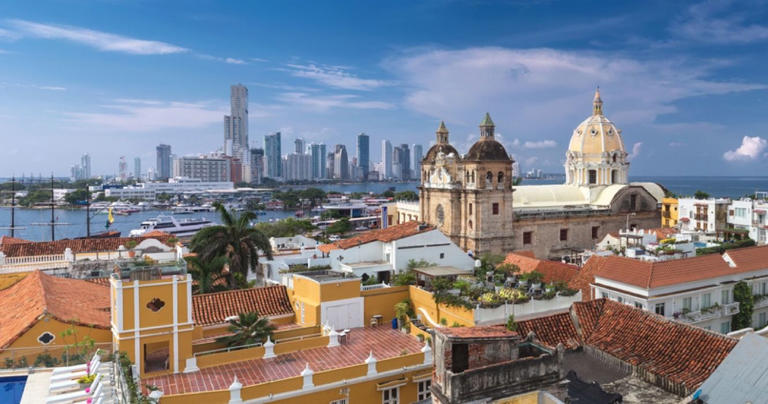
You are using an outdated browser. Upgrade your browser today or install Google Chrome Frame to better experience this site.
Colombia Traveler View
Travel health notices, vaccines and medicines, non-vaccine-preventable diseases, stay healthy and safe.
- Packing List

After Your Trip
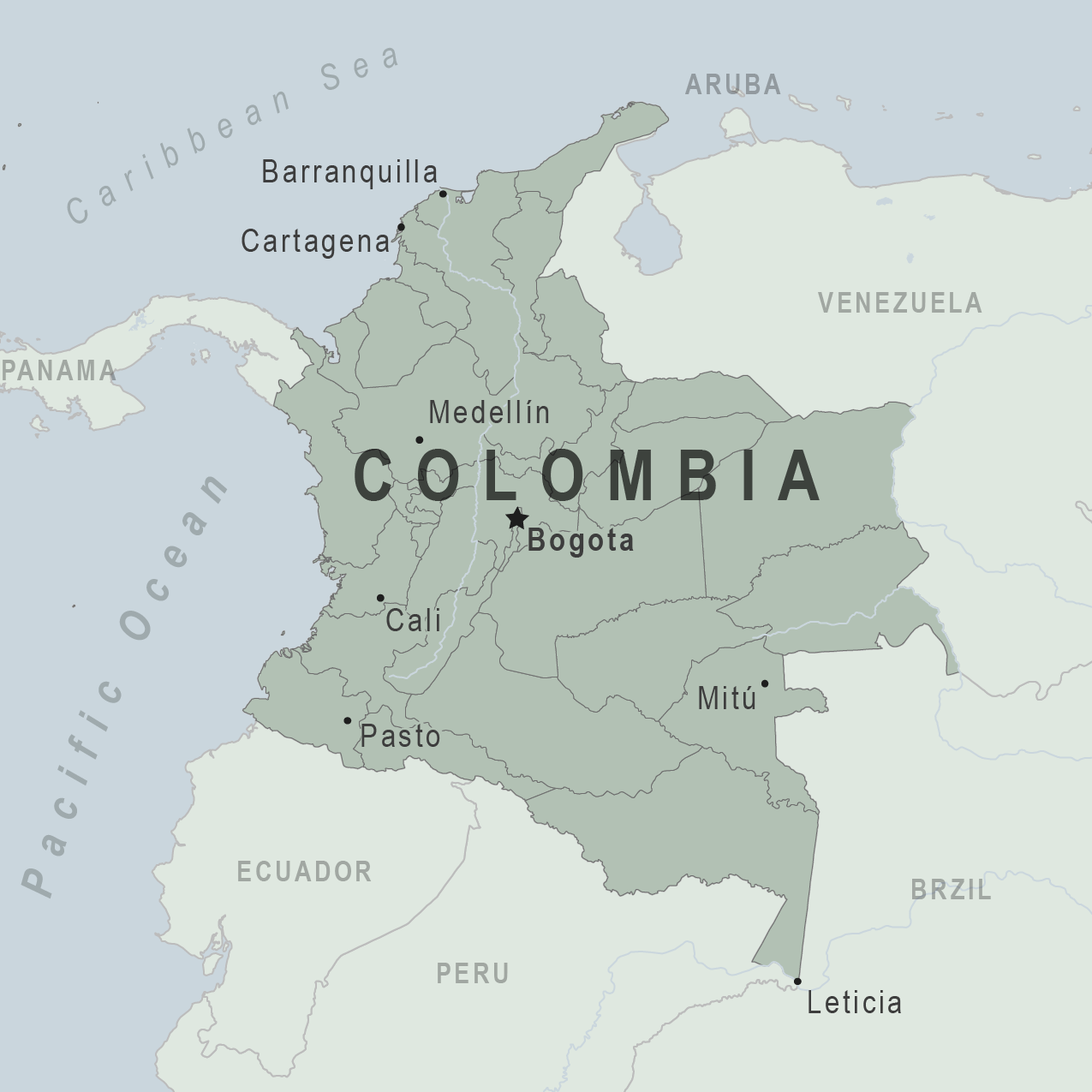
Be aware of current health issues in Colombia. Learn how to protect yourself.
Level 1 Practice Usual Precautions
- Dengue in the Americas April 18, 2024 Dengue is a risk in many parts of Central and South America, Mexico, and the Caribbean. Some countries are reporting increased numbers of cases of the disease. Travelers to the Americas can protect themselves by preventing mosquito bites. Destination List: Argentina, Brazil, Colombia, Costa Rica, Ecuador, including the Galápagos Islands, French Guiana (France), Guadeloupe, Guatemala, Martinique (France), Mexico, Nicaragua, Panama, Paraguay, Peru, Turks and Caicos Islands (U.K.), Uruguay
⇧ Top
Check the vaccines and medicines list and visit your doctor at least a month before your trip to get vaccines or medicines you may need. If you or your doctor need help finding a location that provides certain vaccines or medicines, visit the Find a Clinic page.
Routine vaccines
Recommendations.
Make sure you are up-to-date on all routine vaccines before every trip. Some of these vaccines include
- Chickenpox (Varicella)
- Diphtheria-Tetanus-Pertussis
- Flu (influenza)
- Measles-Mumps-Rubella (MMR)
Immunization schedules
All eligible travelers should be up to date with their COVID-19 vaccines. Please see Your COVID-19 Vaccination for more information.
COVID-19 vaccine
Hepatitis A
Recommended for unvaccinated travelers one year old or older going to Colombia.
Infants 6 to 11 months old should also be vaccinated against Hepatitis A. The dose does not count toward the routine 2-dose series.
Travelers allergic to a vaccine component or who are younger than 6 months should receive a single dose of immune globulin, which provides effective protection for up to 2 months depending on dosage given.
Unvaccinated travelers who are over 40 years old, immunocompromised, or have chronic medical conditions planning to depart to a risk area in less than 2 weeks should get the initial dose of vaccine and at the same appointment receive immune globulin.
Hepatitis A - CDC Yellow Book
Dosing info - Hep A
Hepatitis B
Recommended for unvaccinated travelers younger than 60 years old traveling to Colombia. Unvaccinated travelers 60 years and older may get vaccinated before traveling to Colombia.
Hepatitis B - CDC Yellow Book
Dosing info - Hep B
CDC recommends that travelers going to certain areas of Colombia take prescription medicine to prevent malaria. Depending on the medicine you take, you will need to start taking this medicine multiple days before your trip, as well as during and after your trip. Talk to your doctor about which malaria medication you should take.
Find country-specific information about malaria.
Malaria - CDC Yellow Book
Considerations when choosing a drug for malaria prophylaxis (CDC Yellow Book)
Malaria information for Colombia.
Cases of measles are on the rise worldwide. Travelers are at risk of measles if they have not been fully vaccinated at least two weeks prior to departure, or have not had measles in the past, and travel internationally to areas where measles is spreading.
All international travelers should be fully vaccinated against measles with the measles-mumps-rubella (MMR) vaccine, including an early dose for infants 6–11 months, according to CDC’s measles vaccination recommendations for international travel .
Measles (Rubeola) - CDC Yellow Book
Rabid dogs are commonly found in Colombia. If you are bitten or scratched by a dog or other mammal while in Colombia, there may be limited or no rabies treatment available.
Consider rabies vaccination before your trip if your activities mean you will be around dogs or wildlife.
Travelers more likely to encounter rabid animals include
- Campers, adventure travelers, or cave explorers (spelunkers)
- Veterinarians, animal handlers, field biologists, or laboratory workers handling animal specimens
- Visitors to rural areas
Since children are more likely to be bitten or scratched by a dog or other animals, consider rabies vaccination for children traveling to Colombia.
Rabies - CDC Yellow Book
Recommended for most travelers, especially those staying with friends or relatives or visiting smaller cities or rural areas.
Typhoid - CDC Yellow Book
Dosing info - Typhoid
Yellow Fever
Required for travelers ≥1 year old arriving from Angola, Brazil, Democratic Republic of the Congo, or Uganda; this includes >12-hour airport transits or layovers in any of these countries.
Recommended for all travelers ≥9 months old except as follows. Generally not recommended for travel limited to the cities of Barranquilla, Cali, Cartagena, or Medellín. Not recommended for travel limited to areas >2,300 m (≈7,550 ft) elevation, the archipelago department of San Andrés and Providencia, or the city of Bogotá (the capital).
Yellow Fever - CDC Yellow Book
Avoid contaminated water
Leptospirosis
How most people get sick (most common modes of transmission)
- Touching urine or other body fluids from an animal infected with leptospirosis
- Swimming or wading in urine-contaminated fresh water, or contact with urine-contaminated mud
- Drinking water or eating food contaminated with animal urine
- Avoid contaminated water and soil
Clinical Guidance
Avoid bug bites, chagas disease (american trypanosomiasis).
- Accidentally rub feces (poop) of the triatomine bug into the bug bite, other breaks in the skin, your eyes, or mouth
- From pregnant woman to her baby, contaminated blood products (transfusions), or contaminated food or drink.
- Avoid Bug Bites
Chagas disease
- Mosquito bite
Leishmaniasis
- Sand fly bite
- An infected pregnant woman can spread it to her unborn baby
Airborne & droplet
- Breathing in air or accidentally eating food contaminated with the urine, droppings, or saliva of infected rodents
- Bite from an infected rodent
- Less commonly, being around someone sick with hantavirus (only occurs with Andes virus)
- Avoid rodents and areas where they live
- Avoid sick people
Tuberculosis (TB)
- Breathe in TB bacteria that is in the air from an infected and contagious person coughing, speaking, or singing.
Learn actions you can take to stay healthy and safe on your trip. Vaccines cannot protect you from many diseases in Colombia, so your behaviors are important.
Eat and drink safely
Food and water standards around the world vary based on the destination. Standards may also differ within a country and risk may change depending on activity type (e.g., hiking versus business trip). You can learn more about safe food and drink choices when traveling by accessing the resources below.
- Choose Safe Food and Drinks When Traveling
- Water Treatment Options When Hiking, Camping or Traveling
- Global Water, Sanitation and Hygiene | Healthy Water
- Avoid Contaminated Water During Travel
You can also visit the Department of State Country Information Pages for additional information about food and water safety.
Prevent bug bites
Bugs (like mosquitoes, ticks, and fleas) can spread a number of diseases in Colombia. Many of these diseases cannot be prevented with a vaccine or medicine. You can reduce your risk by taking steps to prevent bug bites.
What can I do to prevent bug bites?
- Cover exposed skin by wearing long-sleeved shirts, long pants, and hats.
- Use an appropriate insect repellent (see below).
- Use permethrin-treated clothing and gear (such as boots, pants, socks, and tents). Do not use permethrin directly on skin.
- Stay and sleep in air-conditioned or screened rooms.
- Use a bed net if the area where you are sleeping is exposed to the outdoors.
What type of insect repellent should I use?
- FOR PROTECTION AGAINST TICKS AND MOSQUITOES: Use a repellent that contains 20% or more DEET for protection that lasts up to several hours.
- Picaridin (also known as KBR 3023, Bayrepel, and icaridin)
- Oil of lemon eucalyptus (OLE) or para-menthane-diol (PMD)
- 2-undecanone
- Always use insect repellent as directed.
What should I do if I am bitten by bugs?
- Avoid scratching bug bites, and apply hydrocortisone cream or calamine lotion to reduce the itching.
- Check your entire body for ticks after outdoor activity. Be sure to remove ticks properly.
What can I do to avoid bed bugs?
Although bed bugs do not carry disease, they are an annoyance. See our information page about avoiding bug bites for some easy tips to avoid them. For more information on bed bugs, see Bed Bugs .
For more detailed information on avoiding bug bites, see Avoid Bug Bites .
Stay safe outdoors
If your travel plans in Colombia include outdoor activities, take these steps to stay safe and healthy during your trip.
- Stay alert to changing weather conditions and adjust your plans if conditions become unsafe.
- Prepare for activities by wearing the right clothes and packing protective items, such as bug spray, sunscreen, and a basic first aid kit.
- Consider learning basic first aid and CPR before travel. Bring a travel health kit with items appropriate for your activities.
- If you are outside for many hours in heat, eat salty snacks and drink water to stay hydrated and replace salt lost through sweating.
- Protect yourself from UV radiation : use sunscreen with an SPF of at least 15, wear protective clothing, and seek shade during the hottest time of day (10 a.m.–4 p.m.).
- Be especially careful during summer months and at high elevation. Because sunlight reflects off snow, sand, and water, sun exposure may be increased during activities like skiing, swimming, and sailing.
- Very cold temperatures can be dangerous. Dress in layers and cover heads, hands, and feet properly if you are visiting a cold location.
Stay safe around water
- Swim only in designated swimming areas. Obey lifeguards and warning flags on beaches.
- Practice safe boating—follow all boating safety laws, do not drink alcohol if driving a boat, and always wear a life jacket.
- Do not dive into shallow water.
- Do not swim in freshwater in developing areas or where sanitation is poor.
- Avoid swallowing water when swimming. Untreated water can carry germs that make you sick.
- To prevent infections, wear shoes on beaches where there may be animal waste.
Leptospirosis, a bacterial infection that can be spread in fresh water, is found in Colombia. Avoid swimming in fresh, unchlorinated water, such as lakes, ponds, or rivers.
Keep away from animals
Most animals avoid people, but they may attack if they feel threatened, are protecting their young or territory, or if they are injured or ill. Animal bites and scratches can lead to serious diseases such as rabies.
Follow these tips to protect yourself:
- Do not touch or feed any animals you do not know.
- Do not allow animals to lick open wounds, and do not get animal saliva in your eyes or mouth.
- Avoid rodents and their urine and feces.
- Traveling pets should be supervised closely and not allowed to come in contact with local animals.
- If you wake in a room with a bat, seek medical care immediately. Bat bites may be hard to see.
All animals can pose a threat, but be extra careful around dogs, bats, monkeys, sea animals such as jellyfish, and snakes. If you are bitten or scratched by an animal, immediately:
- Wash the wound with soap and clean water.
- Go to a doctor right away.
- Tell your doctor about your injury when you get back to the United States.
Consider buying medical evacuation insurance. Rabies is a deadly disease that must be treated quickly, and treatment may not be available in some countries.
Reduce your exposure to germs
Follow these tips to avoid getting sick or spreading illness to others while traveling:
- Wash your hands often, especially before eating.
- If soap and water aren’t available, clean hands with hand sanitizer (containing at least 60% alcohol).
- Don’t touch your eyes, nose, or mouth. If you need to touch your face, make sure your hands are clean.
- Cover your mouth and nose with a tissue or your sleeve (not your hands) when coughing or sneezing.
- Try to avoid contact with people who are sick.
- If you are sick, stay home or in your hotel room, unless you need medical care.
Avoid sharing body fluids
Diseases can be spread through body fluids, such as saliva, blood, vomit, and semen.
Protect yourself:
- Use latex condoms correctly.
- Do not inject drugs.
- Limit alcohol consumption. People take more risks when intoxicated.
- Do not share needles or any devices that can break the skin. That includes needles for tattoos, piercings, and acupuncture.
- If you receive medical or dental care, make sure the equipment is disinfected or sanitized.
Know how to get medical care while traveling
Plan for how you will get health care during your trip, should the need arise:
- Carry a list of local doctors and hospitals at your destination.
- Review your health insurance plan to determine what medical services it would cover during your trip. Consider purchasing travel health and medical evacuation insurance.
- Carry a card that identifies, in the local language, your blood type, chronic conditions or serious allergies, and the generic names of any medications you take.
- Some prescription drugs may be illegal in other countries. Call Colombia’s embassy to verify that all of your prescription(s) are legal to bring with you.
- Bring all the medicines (including over-the-counter medicines) you think you might need during your trip, including extra in case of travel delays. Ask your doctor to help you get prescriptions filled early if you need to.
Many foreign hospitals and clinics are accredited by the Joint Commission International. A list of accredited facilities is available at their website ( www.jointcommissioninternational.org ).
In some countries, medicine (prescription and over-the-counter) may be substandard or counterfeit. Bring the medicines you will need from the United States to avoid having to buy them at your destination.
Malaria is a risk in some parts of Colombia. If you are going to a risk area, fill your malaria prescription before you leave, and take enough with you for the entire length of your trip. Follow your doctor’s instructions for taking the pills; some need to be started before you leave.
Select safe transportation
Motor vehicle crashes are the #1 killer of healthy US citizens in foreign countries.
In many places cars, buses, large trucks, rickshaws, bikes, people on foot, and even animals share the same lanes of traffic, increasing the risk for crashes.
Be smart when you are traveling on foot.
- Use sidewalks and marked crosswalks.
- Pay attention to the traffic around you, especially in crowded areas.
- Remember, people on foot do not always have the right of way in other countries.
Riding/Driving
Choose a safe vehicle.
- Choose official taxis or public transportation, such as trains and buses.
- Ride only in cars that have seatbelts.
- Avoid overcrowded, overloaded, top-heavy buses and minivans.
- Avoid riding on motorcycles or motorbikes, especially motorbike taxis. (Many crashes are caused by inexperienced motorbike drivers.)
- Choose newer vehicles—they may have more safety features, such as airbags, and be more reliable.
- Choose larger vehicles, which may provide more protection in crashes.
Think about the driver.
- Do not drive after drinking alcohol or ride with someone who has been drinking.
- Consider hiring a licensed, trained driver familiar with the area.
- Arrange payment before departing.
Follow basic safety tips.
- Wear a seatbelt at all times.
- Sit in the back seat of cars and taxis.
- When on motorbikes or bicycles, always wear a helmet. (Bring a helmet from home, if needed.)
- Avoid driving at night; street lighting in certain parts of Colombia may be poor.
- Do not use a cell phone or text while driving (illegal in many countries).
- Travel during daylight hours only, especially in rural areas.
- If you choose to drive a vehicle in Colombia, learn the local traffic laws and have the proper paperwork.
- Get any driving permits and insurance you may need. Get an International Driving Permit (IDP). Carry the IDP and a US-issued driver's license at all times.
- Check with your auto insurance policy's international coverage, and get more coverage if needed. Make sure you have liability insurance.
- Avoid using local, unscheduled aircraft.
- If possible, fly on larger planes (more than 30 seats); larger airplanes are more likely to have regular safety inspections.
- Try to schedule flights during daylight hours and in good weather.
Medical Evacuation Insurance
If you are seriously injured, emergency care may not be available or may not meet US standards. Trauma care centers are uncommon outside urban areas. Having medical evacuation insurance can be helpful for these reasons.
Helpful Resources
Road Safety Overseas (Information from the US Department of State): Includes tips on driving in other countries, International Driving Permits, auto insurance, and other resources.
The Association for International Road Travel has country-specific Road Travel Reports available for most countries for a minimal fee.
Maintain personal security
Use the same common sense traveling overseas that you would at home, and always stay alert and aware of your surroundings.
Before you leave
- Research your destination(s), including local laws, customs, and culture.
- Monitor travel advisories and alerts and read travel tips from the US Department of State.
- Enroll in the Smart Traveler Enrollment Program (STEP) .
- Leave a copy of your itinerary, contact information, credit cards, and passport with someone at home.
- Pack as light as possible, and leave at home any item you could not replace.
While at your destination(s)
- Carry contact information for the nearest US embassy or consulate .
- Carry a photocopy of your passport and entry stamp; leave the actual passport securely in your hotel.
- Follow all local laws and social customs.
- Do not wear expensive clothing or jewelry.
- Always keep hotel doors locked, and store valuables in secure areas.
- If possible, choose hotel rooms between the 2nd and 6th floors.
Healthy Travel Packing List
Use the Healthy Travel Packing List for Colombia for a list of health-related items to consider packing for your trip. Talk to your doctor about which items are most important for you.
Why does CDC recommend packing these health-related items?
It’s best to be prepared to prevent and treat common illnesses and injuries. Some supplies and medicines may be difficult to find at your destination, may have different names, or may have different ingredients than what you normally use.
If you are not feeling well after your trip, you may need to see a doctor. If you need help finding a travel medicine specialist, see Find a Clinic . Be sure to tell your doctor about your travel, including where you went and what you did on your trip. Also tell your doctor if you were bitten or scratched by an animal while traveling.
If your doctor prescribed antimalarial medicine for your trip, keep taking the rest of your pills after you return home. If you stop taking your medicine too soon, you could still get sick.
Malaria is always a serious disease and may be a deadly illness. If you become ill with a fever either while traveling in a malaria-risk area or after you return home (for up to 1 year), you should seek immediate medical attention and should tell the doctor about your travel history.
For more information on what to do if you are sick after your trip, see Getting Sick after Travel .
Map Disclaimer - The boundaries and names shown and the designations used on maps do not imply the expression of any opinion whatsoever on the part of the Centers for Disease Control and Prevention concerning the legal status of any country, territory, city or area or of its authorities, or concerning the delimitation of its frontiers or boundaries. Approximate border lines for which there may not yet be full agreement are generally marked.
Other Destinations
If you need help finding travel information:
Message & data rates may apply. CDC Privacy Policy
File Formats Help:
- Adobe PDF file
- Microsoft PowerPoint file
- Microsoft Word file
- Microsoft Excel file
- Audio/Video file
- Apple Quicktime file
- RealPlayer file
- Zip Archive file
Exit Notification / Disclaimer Policy
- The Centers for Disease Control and Prevention (CDC) cannot attest to the accuracy of a non-federal website.
- Linking to a non-federal website does not constitute an endorsement by CDC or any of its employees of the sponsors or the information and products presented on the website.
- You will be subject to the destination website's privacy policy when you follow the link.
- CDC is not responsible for Section 508 compliance (accessibility) on other federal or private website.
- Skip to main content
- Skip to "About this site"
Language selection
Search travel.gc.ca.
Help us to improve our website. Take our survey !
COVID-19: travel health notice for all travellers
Colombia travel advice
Latest updates: Health – editorial update
Last updated: May 6, 2024 11:23 ET
On this page
Safety and security, entry and exit requirements, laws and culture, natural disasters and climate, colombia - exercise a high degree of caution.
Exercise a high degree of caution in Colombia due to high levels of crime.
Border areas - Avoid all travel
- Caquetá, excluding the city of Florencia
- Cauca, excluding the city of Popayan
- Chocó, excluding the towns of Nuquí, Bahía Solano and Capurganá
- within 50 km of the border with Venezuela, excluding the city of Cúcuta
- within 100 km of the border with Panama
- within 50 km of the border with Ecuador, excluding the border crossing at Ipiales
- Norte de Santander, excluding the city of Cúcuta
- the Port of Tumaco and the city of Buenaventura
Regional advisory - Avoid non-essential travel
- Antioquia, north of the city of Buriticá, west of highway 62 and west of highway 60 along the borders with Choco, Risaralda and Caldas departments, excluding the cities of Jardín, Andes and Hispania
- Córdoba, south and west of the city of Montería
- Guainía
- City of Cúcuta
- Meta, excluding the city of Villavicencio and Caño Cristales
- Nariño, excluding the cities of Pasto and Ipiales
- Valle del Cauca, excluding the cities of Buga, Cali and Palmira
- Vaupés
Back to top
Movement restrictions for minors in Medellin
On January 31, 2024, local authorities issued restrictions on the movements of minors under the age of 18 in certain areas of Medellin where they are at a high risk for sexual exploitation. These restrictions will remain in place until July 31, 2024. Minors are not allowed in certain areas every day between 7 pm and 5 am unless they are accompanied by their parents or legal guardians and carry proper identification.
These areas include:
- El Poblado, including Parque Lleras
- parts of Corredor vial de la 33
- La Candelaria, including:
- Plaza de Botero
- Parroquia de la Veracruz
- parts of Corredor de la 70
If you are travelling with a minor in Medellin:
- ensure that they carry proper identification and a photocopy of their passport
- follow the instructions of local authorities
Decree restricting the movement of minors in high-risk zones – Mayor's office of Medellin (in Spanish)
Crime rates are high throughout the country, particularly in the main cities. In some cases, extreme violence leading to death has occurred.
Violent crime
Muggings and assaults occur even in the safer areas of Colombia’s cities. These incidents can turn violent. Firearms and other weapons are common in Colombia. Armed robberies are frequent and may occur on streets, in buses, taxis, restaurants and shopping malls. Criminals won’t hesitate to use weapons on victims who refuse to co-operate.
- Avoid walking alone in isolated or deserted areas
- Avoid travelling alone after dark
- Dress down and avoid wearing jewellery or watches
- Keep cell phones, cameras and other electronic equipment out of sight
- Avoid carrying large amounts of cash
- Use ATMs inside banks, shopping malls and other public locations during business hours only
- If you're robbed, hand over cash, electronic devices and valuables without resistance
Petty crime
Petty crime, such as pickpocketing and purse and cell phone snatching, is common in all parts of the country. Drive-by snatching by thieves on motorcycles occurs regularly. They occur in both impoverished and wealthier parts of the country.
- Ensure that your belongings, including your passport and other travel documents, are secure at all times
- Stay in reputable accommodations with good security
- Keep windows and doors locked at all times
There is a risk of kidnapping for ransom in Colombia.
Armed groups may target foreigners in all parts of the country, especially those who work for oil and mining companies. Business travellers and Canadian companies establishing operations in Colombia should take enhanced security measures to protect both personnel and company assets.
Choose living accommodations that have significant security measures in place and modern office facilities.
Express kidnappings
“Express kidnappings” are frequent and often occur in affluent areas, as well as in tourist areas. In this scenario, criminals kidnap the victim from the street or a taxi and force the person to withdraw funds from an ATM. The victim is sometimes held overnight so that a second withdrawal can be made the next day
- Avoid hailing taxis on the street
- If you're threatened by armed criminals, stay calm and don’t resist
Illegal armed groups
Illegal armed groups pose a major risk to travellers. These groups carry out violent attacks, such as bombings, and finance themselves through extortions and kidnappings. Attacks often result in casualties.
- Remain on well-travelled roads and paths when visiting remote locations
- Be aware of your surroundings at all times
There is a threat of domestic terrorism. Terrorist groups are active in some parts of the country. Attacks occur periodically.
Further attacks are likely. Targets may include:
- government buildings, including schools
- places of worship
- military and police installations and vehicles
- airports and other transportation hubs and networks
- infrastructure, including energy facilities
- public areas such as tourist attractions, restaurants, bars, coffee shops, shopping centres, markets, hotels and other sites frequented by foreigners
Always be aware of your surroundings when in public places. Be particularly vigilant during:
- religious holidays
- public celebrations
- major political events, such as elections
Terrorists may use such occasions to mount attacks.
- Avoid unattended packages or parcel and bring these to the attention of police or security personnel
- Follow the instructions of local authorities
- Monitor local media for the latest updates
Credit card and ATM fraud occurs. Card overcharging also happens, especially in popular tourist areas, where scammers target tourists by charging them elevated prices for services, food and drink.
Ask for a printed price list before ordering.
When using debit or credit cards:
- pay careful attention when others are handling your cards
- use ATMs located in well-lit public areas or inside a bank or business
- avoid using card readers with an irregular or unusual feature
- cover the keypad with one hand when entering your PIN
- check for any unauthorized transactions on your account statements
Fraudulent police officers
Thieves posing as police officers have approached foreigners to verify their documents or foreign currency in the intend to rob them.
If you face this situation:
- don’t hand over your money or documents unless you feel threatened
- request to provide your documents or currency at the nearest police station, your hotel or another public place
Overseas fraud
Demonstrations
Demonstrations and strikes take place regularly throughout Colombia, especially in large cities.
Even peaceful demonstrations can turn violent at any time. They can also lead to disruptions to traffic and public transportation.
- Avoid areas where demonstrations and large gatherings are taking place
- Monitor local media for information on ongoing demonstrations
Mass gatherings (large-scale events)
Spiked food and drinks
Never leave food or drinks unattended or in the care of strangers. Be wary of accepting snacks, beverages, gum, cigarettes or anything else from new acquaintances or someone in the street. These items may contain drugs that could put you at risk of sexual assault and robbery.
Scopolamine and other incapacitating drugs
Scopolamine is a drug that temporarily incapacitates unsuspecting victims, who become quickly disoriented and are vulnerable to crime.
Thieves may put the drug on pamphlets or wares distributed on the street. They may also slip it into food and drinks or blow it into the face of the victim. They often work in teams, with women easing the victim into a false sense of security. They then steal the valuables once the victim has been incapacitated. Dating applications and websites are often used by criminals to identify and lure foreigners travelling alone and looking to meet local people.
Incidents occur:
- in nightclubs
- in bars and restaurants
- on public transportation, including taxis
- on the street
Ayahuasca ceremonies
Spiritual cleansing and ayahuasca ceremonies, offered by shamans and other individuals, have led to serious illness, injury, assault and even the deaths of several tourists.
Ceremonies involve consuming substances that can cause medical complications and severely impair cognitive and physical abilities. They often take place in remote areas with no access to medical or mental health facilities or resources. Often, there is no access to communications with local authorities or emergency services. Facilities generally lack basic first aid or emergency plans to help those suffering from physical or psychological illness during these ceremonies.
Ayahuasca ceremonies are not regulated and individuals offering them are not licensed. There is no way to assess the safety of any of the services, the operators or the shamans.
Avoid participating in spiritual cleansing or ayahuasca ceremonies.
Women’s safety
Women travelling alone may be subject to some forms of harassment and verbal abuse.
Incidents of attacks and sexual assault, including rape, have been reported throughout the country, particularly in tourist areas.
- Avoid travelling alone, especially after dark
- Stay in accommodations with good security
- Be careful when dealing with strangers or recent acquaintances, especially regarding the acceptance of rides or other invitations
- Avoid hospitality exchange arrangements, such as shared accommodations
If you are a victim of a sexual assault or other crime, you should report it immediately to the police and the nearest Canadian office.
Advice for women travellers
Boat accidents have occurred due to unlicensed tour boats not meeting safety standards, including in Cartagena, Santa Marta and San Andrés.
- Choose a reputable boating company
- Ensure that your tour operator follows up-to-date safety regulations
- Don’t board vessels that appear overloaded or unseaworthy
Water safety abroad
Road safety
Road conditions and road safety can vary greatly throughout the country, due to:
- road signs that are difficult to see or non-existent
- lack of lighting and guard rails
- livestock grazing on the roadside in rural areas
- pedestrians walking on the street
Road conditions
Driving conditions may be particularly hazardous during the rainy seasons, from April to May and from October to November.
Road habits
Drivers are extremely aggressive and reckless. They often drive at excessive speeds, are frequently distracted and ignore traffic controls.
Motorcycles are common and are often involved in traffic accidents.
Pedestrians don’t have the right of way, including at stop signs.
When travelling by car in Colombia:
- avoid driving at night
- avoid driving on secondary roads as they are often targeted by criminals
- don’t pick up hitchhikers
- keep your doors locked and windows closed at all times
- always place all belongings under your seat
- carry a cell phone
- park your car in a guarded parking lot when in a city
Local authorities may deny you entry to certain areas due to emerging security threats. Military checkpoints outside cities are common.
Strikes occur often in Colombia and associated roadblocks on major transit routes may cause significant travel disruptions.
Unauthorized roadblocks and bandits also pose a threat.
If you’re planning to travel by land in Colombia:
- dial 767 from your cell phone to receive advice on current road closures from the Colombian Highway Police information line (in Spanish)
- never hitchhike
- consult local media
Public transportation
Public transportation isn’t safe in Colombia. You should avoid using it.
City and rural buses are frequent targets for theft. Armed groups frequently stop and rob rural buses.
If you must take an overnight bus, keep your belongings close to you, not on the floor or in storage compartments, as they could be stolen while you sleep.
Express kidnappings and assaults often occur in unlicensed taxis.
- Use only reputable taxi companies through establishments such as hotels or ride-hailing apps
If you have no choice but to hail a taxi on the street:
- avoid cabs without licence plates
- never enter a cab if it already has one or more passengers
- note the licence plate number and name of the driver when you travel and immediately communicate this information to family or friends
El Dorado International Airport in Bogotá allows only authorized taxis to pick up passengers at its terminals.
Arrange pickup in advance with your travel agency or hotel.
Transportation services - El Dorado International Airport
We do not make assessments on the compliance of foreign domestic airlines with international safety standards.
Information about foreign domestic airlines
Entry restrictions at land and river borders with Ecuador
On January 11, 2024, the Government of Ecuador announced new entry restrictions in response to the ongoing state of internal armed conflict.
All foreigners entering Ecuador at crossing points with land or rivers borders with Colombia will need to present a criminal records check from their country of origin or residence. Both the original criminal record check and the Spanish translation must be apostilled and cover the past five years. Minors travelling with their family members will generally be exempt.
The Apostille Convention took effect in Canada on January 11, 2024. An apostille is a standard certificate allowing documents to be accepted in all countries where the convention is in effect.
Useful links
- Migration information – Ecuador Immigration Agency (in Spanish)
- Changes to authentication services in Canada
- Apostilles for documents
Every country or territory decides who can enter or exit through its borders. The Government of Canada cannot intervene on your behalf if you do not meet your destination’s entry or exit requirements.
We have obtained the information on this page from the Colombian authorities. It can, however, change at any time.
Verify this information with the Foreign Representatives in Canada .
Entry requirements vary depending on the type of passport you use for travel.
Before you travel, check with your transportation company about passport requirements. Its rules on passport validity may be more stringent than the country’s entry rules.
Regular Canadian passport
Your passport must be valid for at least 6 months beyond the date you expect to leave Colombia.
Passport for official travel
Different entry rules may apply.
Official travel
Passport with “X” gender identifier
While the Government of Canada issues passports with an “X” gender identifier, it cannot guarantee your entry or transit through other countries. You might face entry restrictions in countries that do not recognize the “X” gender identifier. Before you leave, check with the closest foreign representative for your destination.
Other travel documents
Different entry rules may apply when travelling with a temporary passport or an emergency travel document. Before you leave, check with the closest foreign representative for your destination.
- Foreign Representatives in Canada
- Canadian passports
Tourist visa: not required for stays of up to 90 days Business or work visa: required Student visa: required
Electronic Immigration Form
You must complete a free electronic immigration form (Check-Mig) within 72 hours to 1 hour before:
- boarding a flight to or from Colombia
- entering into Colombia via land, maritime or river crossings
You will need the following information to complete the form:
- flight details
- a valid passport
- a valid email address
- the address where you will be staying in Colombia
- a phone number
Electronic Immigration Form – Colombia Migration Agency
As of November 14, 2023, you must pay an entry fee equivalent to $85 CAD in Colombian Pesos upon arrival in Colombia. You can only pay by credit card. The payment must be made upon entering the country during the immigration control process. There could be significant delays to make the payment, which could disrupt your travel plans.
You don't have to pay this entry tax if:
- your destination is the archipelago of San Andres, Providencia and Santa Catalina
- you have a valid Colombian visa
- you are less than 14 years of age or more than 79 years old
- you are a member of the crew of international transport means (conditions apply)
- Entry tax for Canadian travellers starts on Nov 14, 2023 – Migration Colombia (in Spanish)
- Entry tax applicable to Canadian nationals – Ministry of External Relations of Colombia (in Spanish)
Entry stamp
You must obtain an entry stamp in your passport when you enter Colombia by land.
You may be fined if you fail to obtain an entry stamp
Length of stay for tourists
The immigration officer will determine the permitted length of your stay when you enter Colombia. As a tourist, you may be granted a stay up to 90 days.
You will be fined if you overstay the specified period on your entry stamp. You may apply for a stay extension at the nearest Migración Colombia office. You may extend your stay up to a maximum of 180 days per calendar year. The final decision remains with the immigration authority.
Migración Colombia - Government of Colombia (in Spanish)
Other entry requirements
Customs officials may ask you to show them a return or onward ticket and proof of sufficient funds to cover your stay.
Archipelago of San Andrés, Providencia and Santa Catalina
If you plan to visit the Archipelago of San Andrés, Providencia and Santa Catalina, you must purchase a tourist card at the airport before departure.
You must also show this card before you depart the island.
Drug screening
Colombia employs strict screening measures at its international airports to detect narcotics smuggling.
Customs officials may:
- search you and your luggage
- fingerprint you
- require you to undergo an X-ray inspection upon arrival or departure
Most airport customs inspectors speak only Spanish.
Dual citizenship
Canadian citizens who also hold Colombian citizenship must enter and exit Colombia using the following documents:
- Colombian passport
- Colombian identification card
Although local immigration authorities will allow dual citizens to enter without Colombian documents, they will stamp their foreign passport indicating that they must leave using Colombian documents.
Children and travel
Exit requirements for dual citizen children.
Whether travelling to a domestic or international destination, underage Canadian-Colombian dual citizens must present:
If under 18 and travelling alone or accompanied by a single parent
- an authorization to travel from both parents, written in Spanish and notarized at a local notary public or at a Colombian embassy or consulate abroad; and
- a Colombian birth certificate, notarized at a local notary public, or a long-form Canadian birth certificate and its official Spanish translation
If under 18 and travelling with both parents
- a Colombian birth certificate notarized at a local notary public; or
- a long-form Canadian birth certificate showing the parents' names, and its official Spanish translation.
- Authorization to travel for minors - Colombian Ministry of Foreign Affairs (in Spanish)
- Colombian Notaries Directory - Superintendent of Notaries and Registry (in Spanish)
- Ministry of Foreign Affairs - Government of Colombia (in Spanish)
- Travelling with children
Yellow fever
Learn about potential entry requirements related to yellow fever (vaccines section).
Relevant Travel Health Notices
- Global Measles Notice - 13 March, 2024
- Zika virus: Advice for travellers - 31 August, 2023
- COVID-19 and International Travel - 13 March, 2024
- Dengue: Advice for travellers - 6 May, 2024
This section contains information on possible health risks and restrictions regularly found or ongoing in the destination. Follow this advice to lower your risk of becoming ill while travelling. Not all risks are listed below.
Consult a health care professional or visit a travel health clinic preferably 6 weeks before you travel to get personalized health advice and recommendations.
Routine vaccines
Be sure that your routine vaccinations , as per your province or territory , are up-to-date before travelling, regardless of your destination.
Some of these vaccinations include measles-mumps-rubella (MMR), diphtheria, tetanus, pertussis, polio, varicella (chickenpox), influenza and others.
Pre-travel vaccines and medications
You may be at risk for preventable diseases while travelling in this destination. Talk to a travel health professional about which medications or vaccines may be right for you, based on your destination and itinerary.
Yellow fever is a disease caused by a flavivirus from the bite of an infected mosquito.
Travellers get vaccinated either because it is required to enter a country or because it is recommended for their protection.
- There is a risk of yellow fever in this country.
Country Entry Requirement*
- Proof of vaccination is required if you are arriving from Angola, Brazil, Democratic Republic of the Congo, or Uganda, or have transited through an airport in one of these countries.
Recommendation
- Vaccination is recommended depending on your itinerary.
- Contact a designated Yellow Fever Vaccination Centre well in advance of your trip to arrange for vaccination.
- Discuss travel plans, activities, and destinations with a health care professional.
- Protect yourself from mosquito bites .
About Yellow Fever
Yellow Fever Vaccination Centres in Canada * It is important to note that country entry requirements may not reflect your risk of yellow fever at your destination. It is recommended that you contact the nearest diplomatic or consular office of the destination(s) you will be visiting to verify any additional entry requirements.
There is a risk of hepatitis A in this destination. It is a disease of the liver. People can get hepatitis A if they ingest contaminated food or water, eat foods prepared by an infectious person, or if they have close physical contact (such as oral-anal sex) with an infectious person, although casual contact among people does not spread the virus.
Practise safe food and water precautions and wash your hands often. Vaccination is recommended for all travellers to areas where hepatitis A is present.
Measles is a highly contagious viral disease. It can spread quickly from person to person by direct contact and through droplets in the air.
Anyone who is not protected against measles is at risk of being infected with it when travelling internationally.
Regardless of where you are going, talk to a health care professional before travelling to make sure you are fully protected against measles.
Hepatitis B is a risk in every destination. It is a viral liver disease that is easily transmitted from one person to another through exposure to blood and body fluids containing the hepatitis B virus. Travellers who may be exposed to blood or other bodily fluids (e.g., through sexual contact, medical treatment, sharing needles, tattooing, acupuncture or occupational exposure) are at higher risk of getting hepatitis B.
Hepatitis B vaccination is recommended for all travellers. Prevent hepatitis B infection by practicing safe sex, only using new and sterile drug equipment, and only getting tattoos and piercings in settings that follow public health regulations and standards.
Coronavirus disease (COVID-19) is an infectious viral disease. It can spread from person to person by direct contact and through droplets in the air.
It is recommended that all eligible travellers complete a COVID-19 vaccine series along with any additional recommended doses in Canada before travelling. Evidence shows that vaccines are very effective at preventing severe illness, hospitalization and death from COVID-19. While vaccination provides better protection against serious illness, you may still be at risk of infection from the virus that causes COVID-19. Anyone who has not completed a vaccine series is at increased risk of being infected with the virus that causes COVID-19 and is at greater risk for severe disease when travelling internationally.
Before travelling, verify your destination’s COVID-19 vaccination entry/exit requirements. Regardless of where you are going, talk to a health care professional before travelling to make sure you are adequately protected against COVID-19.
The best way to protect yourself from seasonal influenza (flu) is to get vaccinated every year. Get the flu shot at least 2 weeks before travelling.
The flu occurs worldwide.
- In the Northern Hemisphere, the flu season usually runs from November to April.
- In the Southern Hemisphere, the flu season usually runs between April and October.
- In the tropics, there is flu activity year round.
The flu vaccine available in one hemisphere may only offer partial protection against the flu in the other hemisphere.
The flu virus spreads from person to person when they cough or sneeze or by touching objects and surfaces that have been contaminated with the virus. Clean your hands often and wear a mask if you have a fever or respiratory symptoms.
Malaria is a serious and sometimes fatal disease that is caused by parasites spread through the bites of mosquitoes. There is a risk of malaria in certain areas and/or during a certain time of year in this destination.
Antimalarial medication may be recommended depending on your itinerary and the time of year you are travelling. Consult a health care professional or visit a travel health clinic before travelling to discuss your options. It is recommended to do this 6 weeks before travel, however, it is still a good idea any time before leaving. Protect yourself from mosquito bites at all times: • Cover your skin and use an approved insect repellent on uncovered skin. • Exclude mosquitoes from your living area with screening and/or closed, well-sealed doors and windows. • Use insecticide-treated bed nets if mosquitoes cannot be excluded from your living area. • Wear permethrin-treated clothing. If you develop symptoms similar to malaria when you are travelling or up to a year after you return home, see a health care professional immediately. Tell them where you have been travelling or living.
In this destination, rabies is commonly carried by dogs and some wildlife, including bats. Rabies is a deadly disease that spreads to humans primarily through bites or scratches from an infected animal. While travelling, take precautions , including keeping your distance from animals (including free-roaming dogs), and closely supervising children.
If you are bitten or scratched by a dog or other animal while travelling, immediately wash the wound with soap and clean water and see a health care professional. In this destination, rabies treatment may be limited or may not be available, therefore you may need to return to Canada for treatment.
Before travel, discuss rabies vaccination with a health care professional. It may be recommended for travellers who are at high risk of exposure (e.g., occupational risk such as veterinarians and wildlife workers, children, adventure travellers and spelunkers, and others in close contact with animals).
Safe food and water precautions
Many illnesses can be caused by eating food or drinking beverages contaminated by bacteria, parasites, toxins, or viruses, or by swimming or bathing in contaminated water.
- Learn more about food and water precautions to take to avoid getting sick by visiting our eat and drink safely abroad page. Remember: Boil it, cook it, peel it, or leave it!
- Avoid getting water into your eyes, mouth or nose when swimming or participating in activities in freshwater (streams, canals, lakes), particularly after flooding or heavy rain. Water may look clean but could still be polluted or contaminated.
- Avoid inhaling or swallowing water while bathing, showering, or swimming in pools or hot tubs.
Travellers' diarrhea is the most common illness affecting travellers. It is spread from eating or drinking contaminated food or water.
Risk of developing travellers' diarrhea increases when travelling in regions with poor standards of hygiene and sanitation. Practise safe food and water precautions.
The most important treatment for travellers' diarrhea is rehydration (drinking lots of fluids). Carry oral rehydration salts when travelling.
Typhoid is a bacterial infection spread by contaminated food or water. Risk is higher among children, travellers going to rural areas, travellers visiting friends and relatives or those travelling for a long period of time.
Travellers visiting regions with a risk of typhoid, especially those exposed to places with poor sanitation, should speak to a health care professional about vaccination.
Insect bite prevention
Many diseases are spread by the bites of infected insects such as mosquitoes, ticks, fleas or flies. When travelling to areas where infected insects may be present:
- Use insect repellent (bug spray) on exposed skin
- Cover up with light-coloured, loose clothes made of tightly woven materials such as nylon or polyester
- Minimize exposure to insects
- Use mosquito netting when sleeping outdoors or in buildings that are not fully enclosed
To learn more about how you can reduce your risk of infection and disease caused by bites, both at home and abroad, visit our insect bite prevention page.
Find out what types of insects are present where you’re travelling, when they’re most active, and the symptoms of the diseases they spread.
There is a risk of chikungunya in this country. The risk may vary between regions of a country. Chikungunya is a virus spread through the bite of an infected mosquito. Chikungunya can cause a viral disease that typically causes fever and pain in the joints. In some cases, the joint pain can be severe and last for months or years.
Protect yourself from mosquito bites at all times. There is no vaccine available for chikungunya.
Cutaneous and mucosal leishmaniasis causes skin sores and ulcers. It is caused by a parasite spread through the bite of a female sandfly.
Risk is generally low for most travellers. Protect yourself from sandfly bites, which typically occur after sunset in rural and forested areas and in some urban centres. There is no vaccine or medication to protect against leishmaniasis.
- In this country, dengue is a risk to travellers. It is a viral disease spread to humans by mosquito bites.
- Dengue can cause flu-like symptoms. In some cases, it can lead to severe dengue, which can be fatal.
- The level of risk of dengue changes seasonally, and varies from year to year. The level of risk also varies between regions in a country and can depend on the elevation in the region.
- Mosquitoes carrying dengue typically bite during the daytime, particularly around sunrise and sunset.
- Protect yourself from mosquito bites . There is no vaccine or medication that protects against dengue.
Zika virus is a risk in this country.
Zika virus is primarily spread through the bite of an infected mosquito. It can also be sexually transmitted. Zika virus can cause serious birth defects.
During your trip:
- Prevent mosquito bites at all times.
- Use condoms correctly or avoid sexual contact, particularly if you are pregnant.
If you are pregnant or planning a pregnancy, you should discuss the potential risks of travelling to this destination with your health care provider. You may choose to avoid or postpone travel.
For more information, see Zika virus: Pregnant or planning a pregnancy.
American trypanosomiasis (Chagas disease) is a risk in this country. It is caused by a parasite spread by infected triatomine bugs. The infection can be inactive for decades, but humans can eventually develop complications causing disability and even death.
Risk is generally low for most travellers. Protect yourself from triatomine bugs, which are active at night, by using mosquito nets if staying in poorly-constructed housing. There is no vaccine available for Chagas disease.
Animal precautions
Some infections, such as rabies and influenza, can be shared between humans and animals. Certain types of activities may increase your chance of contact with animals, such as travelling in rural or forested areas, camping, hiking, and visiting wet markets (places where live animals are slaughtered and sold) or caves.
Travellers are cautioned to avoid contact with animals, including dogs, livestock (pigs, cows), monkeys, snakes, rodents, birds, and bats, and to avoid eating undercooked wild game.
Closely supervise children, as they are more likely to come in contact with animals.
Person-to-person infections
Stay home if you’re sick and practise proper cough and sneeze etiquette , which includes coughing or sneezing into a tissue or the bend of your arm, not your hand. Reduce your risk of colds, the flu and other illnesses by:
- washing your hands often
- avoiding or limiting the amount of time spent in closed spaces, crowded places, or at large-scale events (concerts, sporting events, rallies)
- avoiding close physical contact with people who may be showing symptoms of illness
Sexually transmitted infections (STIs) , HIV , and mpox are spread through blood and bodily fluids; use condoms, practise safe sex, and limit your number of sexual partners. Check with your local public health authority pre-travel to determine your eligibility for mpox vaccine.
Medical services and facilities
Good health care is limited is available in major cities. Quality of care varies greatly throughout the country.
Private clinics offer emergency services. They typically require advance payment in cash or by credit card.
If you don’t have proof of travel insurance, you may be transferred to a public hospital, where medical care may not meet Canadian standards.
Make sure you get travel insurance that includes coverage for medical evacuation and hospital stays.
Travel health and safety
Medical tourism
Canadian citizens have died or had serious health complications following cosmetic or other elective surgeries in Colombia.
Before leaving for medical travel:
- make sure you have done your research
- use reputable health-care providers only
Receiving medical care outside Canada
Some prescription medication may not be available in Colombia.
If you take prescription medication, you’re responsible for determining their legality in the country.
- Bring sufficient quantities of your medication with you
- Always keep your medication in the original container
- Pack your medication in your carry-on luggage
- Carry a copy of your prescriptions
Altitude sickness
Bogotá is located at 2600 metres above sea level. In some parts of the country, you may experience health problems due to high altitudes.
Altitude sickness can be life-threatening. It may require immediate medical evacuation.
- Know about the symptoms of altitude sickness
- Find out how to prevent or reduce the effects of altitude sickness
Keep in Mind...
The decision to travel is the sole responsibility of the traveller. The traveller is also responsible for his or her own personal safety.
Be prepared. Do not expect medical services to be the same as in Canada. Pack a travel health kit , especially if you will be travelling away from major city centres.
You must abide by local laws.
Learn about what you should do and how we can help if you are arrested or detained abroad .
Penalties for breaking the law in Colombia can be more severe than in Canada, even for similar offences. No transfer of offenders’ treaty exists between Canada and Colombia. If you’re convicted of a serious crime, you must serve your jail sentence in Colombia. You may also have to remain in Colombia for a parole period following your release.
Detention conditions may be below the standards of Canadian prisons.
- Overview of the criminal law system in Colombia
- Arrest and detention
Penalties for possession, use or trafficking of illegal drugs are severe. Convicted offenders can expect lengthy jail sentences and heavy fines.
- Pack your own luggage and monitor it closely at all times
- Never transport other people’s packages, bags or suitcases
- Never exchange money for strangers, as this is a common practice among money launderers
Drugs, alcohol and travel
It’s illegal to import firearms into Colombia.
Conviction may result in lengthy prison sentences.
Political activities
It’s illegal for foreigners to participate in local political activities, rallies or public demonstrations in Colombia.
Political involvement may result in your deportation.
It’s illegal to export certain cultural artifacts with historical value from Colombia, such as:
- original paintings
Child sex tourism
It's a serious criminal offence to have sex with minors in Colombia.
Conviction may result in a lengthy prison sentence.
Child Sex Tourism: It’s a Crime
2SLGBTQI+ travellers
Colombian law does not prohibit sexual acts between individuals of the same sex.
However, 2SLGBTQI+ travellers could be discriminated against based on their sexual orientation, gender identity, gender expression or sex characteristics.
Travel and your sexual orientation, gender identity, gender expression and sex characteristics
Dual citizenship is legally recognized in Colombia.
If you are a Canadian citizen, but also a citizen of Colombia, our ability to offer you consular services may be limited while you're there. You may also be subject to different entry/exit requirements .
Travellers with dual citizenship
International Child Abduction
The Hague Convention on the Civil Aspects of International Child Abduction is an international treaty. It can help parents with the return of children who have been removed to or retained in certain countries in violation of custody rights. The convention applies between Canada and Colombia.
If your child was wrongfully taken to, or is being held in Colombia, and if the applicable conditions are met, you may apply for the return of your child to the Colombian court.
If you are in this situation:
- act as quickly as you can
- contact the Central Authority for your province or territory of residence for information on starting an application under The Hague Convention
- consult a lawyer in Canada and in Colombia to explore all the legal options for the return of your child
- report the situation to the nearest Canadian government office abroad or to the Vulnerable Children’s Consular Unit at Global Affairs Canada by calling the Emergency Watch and Response Centre
If your child was removed from a country other than Canada, consult a lawyer to determine if The Hague Convention applies.
Be aware that Canadian consular officials cannot interfere in private legal matters or in another country’s judicial affairs.
- List of Canadian Central Authorities for the Hague Convention
- International Child Abduction: A Guidebook for Left-Behind Parents
- The Hague Convention - Hague Conference on Private International Law
- Canadian embassies and consulates by destination
- Emergency Watch and Response Centre
Identification
Local authorities may ask you to show identification at any time.
- Carry photo identification at all times
- Keep a photocopy of your passport and visa or residence permit in a safe place, in case they’re lost or confiscated
You must carry an international driving permit.
In the event of a car accident:
- remain at the scene
- don’t move your vehicle until the authorities arrive
Failure to remain at the site may be considered an admission of guilt under Colombian law.
However, some accidents may attract a crowd that could turn hostile. If you feel unsafe:
- ensure your windows and doors are locked
- leave the area
- report the accident to the police and your insurance company as soon as possible
International Driving Permit
The currency in Colombia is the peso (COP).
You can easily exchange U.S. dollars and euros for pesos in banks and currency exchange bureaus.
Credit and debit cards are widely accepted. In rural areas, ATMs may be limited in availability.
Colombia is subject to various natural disasters such as hurricanes, earthquakes, volcanic eruptions, torrential rains, floods and mudslides.
El Niño
The complex weather phenomenon called El Niño happens at irregular intervals of 2 to 7 years and can last 9 months to 2 years.
- Keep informed of regional weather forecasts before and during your travels, and plan accordingly
- Ensure you have adequate insurance to cover the consequences of such events, including the disruption of travel plans
Learn about El Niño
Seismic activity
There are several active and potentially active volcanoes throughout Colombia.
Debris from erupting volcanoes may clog rivers and cause them to overflow, which could in turn cause flash floods and landslides. Ash clouds may also cause disruptions to domestic and international flights.
Earthquakes
Colombia is located in an active seismic area. Earthquakes occur frequently. Dangerous landslides can also occur, even after minor earthquakes.
- Colombian Geological Service - Colombia’s government (in Spanish)
- Latest earthquakes - U.S. Geological Survey
- Earthquakes - What to Do?
Hurricane season
Hurricanes usually occur from mid-May to the end of November. During this period, even small tropical storms can quickly develop into major hurricanes.
These severe storms can put you at risk and hamper the provision of essential services.
If you decide to travel to a coastal area during the hurricane season:
- know that you expose yourself to serious safety risks
- be prepared to change your travel plans on short notice, including cutting short or cancelling your trip
- stay informed of the latest regional weather forecasts
- carry emergency contact information for your airline or tour operator
- follow the advice and instructions of local authorities
- Tornadoes, cyclones, hurricanes, typhoons and monsoons
- Large-scale emergencies abroad
- Active storm tracking and hurricane watches and warnings - United States’ National Hurricane Center
Rainy seasons
Colombia’s rainy seasons usually occur from March to June and from September to November. Incidents of flooding and mudslides can occur, especially in rural areas.
Seasonal flooding can hamper overland travel and reduce the provision of essential services. Roads may become impassable and bridges damaged.
Local services
For emergency assistance, dial 123.
For non-urgent matters, you can reach the National Police by email at [email protected] .
Consular assistance
Aruba, Bonaire, Curaçao, Venezuela
For emergency consular assistance, call the Embassy of Canada to Colombia, in Bogotá, and follow the instructions. At any time, you may also contact the Emergency Watch and Response Centre in Ottawa.
The decision to travel is your choice and you are responsible for your personal safety abroad. We take the safety and security of Canadians abroad very seriously and provide credible and timely information in our Travel Advice to enable you to make well-informed decisions regarding your travel abroad.
The content on this page is provided for information only. While we make every effort to give you correct information, it is provided on an "as is" basis without warranty of any kind, expressed or implied. The Government of Canada does not assume responsibility and will not be liable for any damages in connection to the information provided.
If you need consular assistance while abroad, we will make every effort to help you. However, there may be constraints that will limit the ability of the Government of Canada to provide services.
Learn more about consular services .
Risk Levels
take normal security precautions.
Take similar precautions to those you would take in Canada.
Exercise a high degree of caution
There are certain safety and security concerns or the situation could change quickly. Be very cautious at all times, monitor local media and follow the instructions of local authorities.
IMPORTANT: The two levels below are official Government of Canada Travel Advisories and are issued when the safety and security of Canadians travelling or living in the country or region may be at risk.
Avoid non-essential travel
Your safety and security could be at risk. You should think about your need to travel to this country, territory or region based on family or business requirements, knowledge of or familiarity with the region, and other factors. If you are already there, think about whether you really need to be there. If you do not need to be there, you should think about leaving.
Avoid all travel
You should not travel to this country, territory or region. Your personal safety and security are at great risk. If you are already there, you should think about leaving if it is safe to do so.
5 Reasons Why You Should Exchange Money Before You Travel To Colombia
- Last updated May 13, 2024
- Difficulty Beginner
- Category Travel

Are you planning a trip to Colombia? Don't forget to exchange your money before you set off! While it may seem convenient to exchange your currency upon arrival, there are several reasons why it's better to do so before you travel. From avoiding expensive fees to ensuring you have enough cash for emergencies, this article will explore five compelling reasons why you should exchange your money before traveling to Colombia. So, let's dive in and discover why it pays off to be prepared!
What You'll Learn
Understanding the colombian currency: peso exchange rate and denominations, pros and cons of exchanging money before traveling to colombia, options for exchanging money in colombia: banks, atms, and currency exchange offices, tips for getting the best exchange rate and avoiding fees in colombia.

If you're planning a trip to Colombia, one important aspect to consider is the country's currency. The official currency of Colombia is the Colombian peso (COP), and understanding its exchange rate and denominations is crucial to ensure a smooth and hassle-free travel experience. In this article, we will discuss everything you need to know about the Colombian peso.
Exchange rate:
Before you travel to Colombia, it is advisable to exchange some currency in your home country. This way, you will have some Colombian pesos on hand when you arrive. It's worth noting that the exchange rate can vary, so it's a good idea to check the current rate before making the exchange. You can do this easily by using an online currency converter or by visiting your local bank or currency exchange service.
While it is possible to exchange currency once you arrive in Colombia, it's generally recommended to do so in your home country. This is because exchange rates at airports or other tourist areas in Colombia may not be as favorable as those in your home country.
Denominations:
Colombian pesos come in different denominations, ranging from as small as 1 peso to as large as 100,000 pesos. Here is a breakdown of the different denominations you'll come across:
- Coins: Colombian pesos are available in 20, 50, 100, 200, 500, and 1,000 peso coins. While smaller denomination coins are common, it's important to note that the 1,000 peso coin is relatively rare. Most transactions involving pesos will be conducted using paper denominations.
- Banknotes: Colombian pesos are available in paper denominations of 1,000, 2,000, 5,000, 10,000, 20,000, 50,000, and 100,000 pesos. The 1,000 and 2,000 peso bills are less commonly used, while the 50,000 and 100,000 peso bills are the largest denominations and may not be accepted everywhere. It's a good idea to carry a mix of denominations to ensure you can easily make purchases or pay for services.
It's important to note that some businesses, especially smaller establishments or vendors in remote areas, may not accept large denomination bills. Therefore, it's always a good idea to carry smaller bills and coins for day-to-day transactions and have larger bills for emergencies or bigger expenses.
Tips for handling Colombian currency:
When handling Colombian currency, there are a few tips worth keeping in mind:
- Always carry small bills and coins for everyday purchases, such as public transportation or buying food from street vendors.
- Keep larger bills separate from smaller denominations to avoid confusion during transactions.
- Be cautious when handling large denomination bills, as counterfeit currency can be an issue in some areas. Familiarize yourself with the security features of Colombian banknotes to help identify potential counterfeit bills.
- Use ATMs to withdraw local currency when needed. However, always be cautious and use machines located in secure and well-lit areas to avoid any potential safety issues.
In conclusion, understanding the Colombian currency is essential when traveling to the country. Familiarize yourself with the exchange rate, carry a mix of denominations, and follow these tips to make your experience with Colombian pesos a smooth one. Enjoy your trip to Colombia!
A Step-by-Step Guide on How to Check the Status of Your Travel Document Application
You may want to see also
If you are planning a trip to Colombia, one of the important considerations you need to make is whether to exchange your money before you travel or whether to wait until you arrive in the country. There are pros and cons to both options, and it ultimately depends on your personal situation and preferences. In this article, we will discuss the advantages and disadvantages of exchanging money before traveling to Colombia, so you can make an informed decision.
Pros of Exchanging Money Before Traveling to Colombia:
- Convenience: One of the main advantages of exchanging money before your trip is the convenience it offers. By exchanging your currency in your home country, you can avoid the hassle of trying to find a currency exchange provider in Colombia, especially if you don't speak the language fluently. It can save you time and effort, allowing you to focus on enjoying your trip.
- Avoid Exchange Fees: Exchanging money in your home country can help you avoid currency exchange fees that are typically charged at airports, hotels, or local exchange bureaus in Colombia. These fees can add up and eat into your travel budget. By exchanging your money in advance, you can potentially save a significant amount of money.
- Familiarity with Currency: Exchanging money before your trip allows you to become familiar with the Colombian currency, which is the Colombian Peso (COP). By having some local currency on hand, you can easily pay for small expenses upon arrival, such as transportation or food. It can also help you get a sense of the value of goods and services in the local currency, making it easier to plan your budget.
Cons of Exchanging Money Before Traveling to Colombia:
- Exchange Rate Fluctuations: One of the potential downsides of exchanging money in advance is the risk of exchange rate fluctuations. Currencies can fluctuate in value, and if the exchange rate of the Colombian Peso improves after you exchange your money, you may end up losing out on potential savings. However, it is important to note that predicting exchange rate movements is difficult, and it is a risk that applies to both options.
- Security Concerns: Carrying large amounts of cash while traveling can be risky, as it increases the chances of theft or loss. If you exchange a significant amount of money before your trip, you will need to ensure its safekeeping throughout your journey. On the other hand, if you choose to carry a minimal amount of cash and rely on ATMs in Colombia, you may face withdrawal limits or transaction fees imposed by your home bank or the local banks.
- Accessibility of ATMs: Colombia generally has a good network of ATMs, especially in urban areas and popular tourist destinations. If you choose to rely on ATMs for obtaining local currency, you will have access to a convenient and secure way of withdrawing money as and when needed. However, it is worth noting that in more remote or rural areas of Colombia, ATMs may be less accessible, making it more challenging to withdraw cash.
In conclusion, exchanging money before traveling to Colombia has its advantages and disadvantages. If you value convenience, want to avoid exchange fees, and prefer having local currency on hand, exchanging money in advance may be the right choice for you. On the other hand, if you want to take advantage of potentially better exchange rates, prefer not to carry large sums of cash, or if you have easy access to ATMs, exchanging money upon arrival in Colombia might be more suitable. Evaluate your personal circumstances and preferences to make an informed decision that best suits your needs.
When to Enjoy Off-Peak Rail Travel in London
When traveling to Colombia, it's important to have the local currency, the Colombian peso, on hand. While credit cards are widely accepted in major cities and tourist areas, having some cash can be useful for small, local establishments and for when you're in more remote areas. Here are your options for exchanging money in Colombia:
Banks are a reliable and secure option for exchanging money in Colombia. Major banks, such as Bancolombia, Banco de Bogota, and Davivienda, have branches throughout the country. You can exchange your currency at these banks either by visiting a branch in person or using their ATMs. Make sure to check the exchange rates and fees beforehand, as they vary between banks. It's also a good idea to notify your bank of your travel plans to avoid any issues with your debit or credit card.
ATMs are widely available in Colombia, particularly in major cities and tourist areas. They offer a convenient option for withdrawing cash in the local currency directly from your bank account. However, it's important to be cautious when using ATMs in Colombia, as card skimming and other fraudulent activities can occur. To minimize the risk, use ATMs located inside banks or busy areas, and shield your PIN while entering it. Additionally, notify your bank about your travel plans and inquire about any international withdrawal fees that may apply.
Currency Exchange Offices:
Currency exchange offices, also known as "casa de cambio," are prevalent in most Colombian cities and tourist destinations. These establishments specialize in exchanging foreign currency for the local currency. While they may offer competitive rates, be mindful of potential fees and always compare rates between different offices to ensure you're getting the best deal. It's advisable to exchange money at authorized exchange offices to avoid counterfeit currency.
Before exchanging money in Colombia, it's important to familiarize yourself with the current exchange rates. You can check the rates online or use currency converter apps to ensure you get a fair deal. Additionally, it's recommended to exchange money in moderate amounts, as carrying large sums of cash can make you a target for theft.
Overall, while credit cards are widely accepted in Colombia, having some local currency on hand can be advantageous. Choose the option that best suits your needs and take the necessary precautions to ensure a safe and hassle-free currency exchange experience.
Is it Possible to Travel to China on a Tourist Visa?
When traveling to Colombia, it's important to consider how to get the best exchange rate and avoid excessive fees when converting your money. Here are some tips to help you make the most of your currency exchange:
- Compare exchange rates: Before exchanging your money, it's essential to compare the exchange rates offered by different banks, exchange offices, or online platforms. Look for institutions that offer competitive rates to ensure you get the best deal.
- Avoid exchanging at airports or hotels: Airports and hotels often offer unfavorable exchange rates and charge high fees. It's best to avoid exchanging your money at these locations unless it's absolutely necessary. Instead, opt for local banks or authorized exchange offices in the city.
- Use ATMs: Using ATMs to withdraw cash in Colombia is a convenient and cost-effective option. Look for ATMs affiliated with recognized banks to ensure a secure transaction. However, keep in mind that some banks may charge a fee for international withdrawals, so it's advisable to check with your own bank beforehand.
- Notify your bank: Before traveling to Colombia, inform your bank about your trip to avoid any unexpected issues with your debit or credit card. This will prevent your card from being blocked due to suspected fraudulent activity when you try to make withdrawals or payments in a foreign country.
- Use credit cards wisely: Credit cards are widely accepted in Colombia, especially in tourist areas and larger establishments. However, keep in mind that some businesses may add a currency conversion fee on your transactions. To avoid this, opt to be charged in the local currency (Colombian Pesos) rather than your home currency when given the choice.
- Consider a prepaid travel card: Another option to consider is a prepaid travel card. These cards allow you to load your desired amount of money onto the card in your home currency, which can then be used like a debit or credit card abroad. Prepaid travel cards often offer competitive exchange rates and provide security in case of loss or theft.
- Be cautious with street vendors: While Colombia is generally a safe country for tourists, it's always important to exercise caution, especially when dealing with street vendors who offer currency exchange services. These individuals may engage in illegal activities or offer unfavorable rates. Stick to authorized exchange offices or banks to ensure a reliable and secure transaction.
- Plan your currency needs: It's a good idea to estimate your currency needs before traveling to Colombia. While it's tempting to exchange all your money at once, it's generally recommended to exchange smaller amounts as needed to avoid carrying excessive cash or being left with large amounts of local currency at the end of your trip.
By following these tips, you can get the best exchange rate and minimize fees when converting your money in Colombia. Remember to research local exchange rates, use ATMs wisely, inform your bank, and consider alternative options like prepaid travel cards. With careful planning, you can make the most of your currency exchange and enjoy your trip to Colombia without unnecessary financial stress.
Does Duane Reade Carry Travel Size Products?
Frequently asked questions.
It is recommended to exchange some money before you travel to Colombia. While major cities and tourist areas in Colombia have plenty of ATMs and currency exchange offices, it's always a good idea to have some local currency on hand for smaller shops, markets, and transportation options that may not accept credit cards.
You can exchange money at your local bank or currency exchange offices that offer Colombian pesos. It's advisable to compare rates and fees beforehand to get the best deal. You can also check if your bank offers foreign currency exchange services.
The amount of money you should exchange before traveling to Colombia depends on your travel plans and preferences. It's recommended to have enough cash to cover basic expenses for the first few days, such as transportation, meals, and small purchases. Additionally, having some emergency funds is always a good idea. Remember to keep an eye on exchange rates to make the most of your money.

- Paolo Barresi Author

- Jose Ramos Author Editor Reviewer Traveller
It is awesome. Thank you for your feedback!
We are sorry. Plesae let us know what went wrong?
We will update our content. Thank you for your feedback!
Leave a comment
Travel photos, related posts.
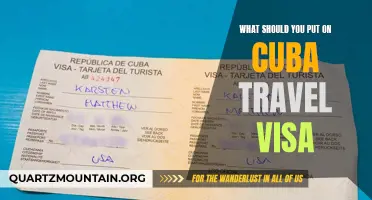
What to Include on Your Cuba Travel Visa Application
- May 08, 2024

Is Travelers Giving Money Back to its Customers?
- May 13, 2024

How to Travel from the US to Canada with a Visa
- Mar 15, 2024

The Essential Guide to Checking INR Levels While Traveling
- May 11, 2024

The Number of Chapters Found in 'Travel Team' Revealed
- May 10, 2024
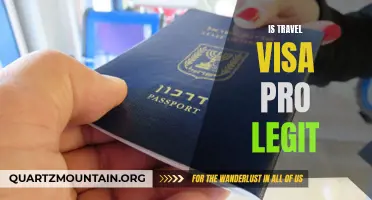
Is Travel Visa Pro Legit? Uncover the Truth Here
- Mar 14, 2024
How to get around Colombia, from buses to bicycles
Oct 2, 2023 • 8 min read
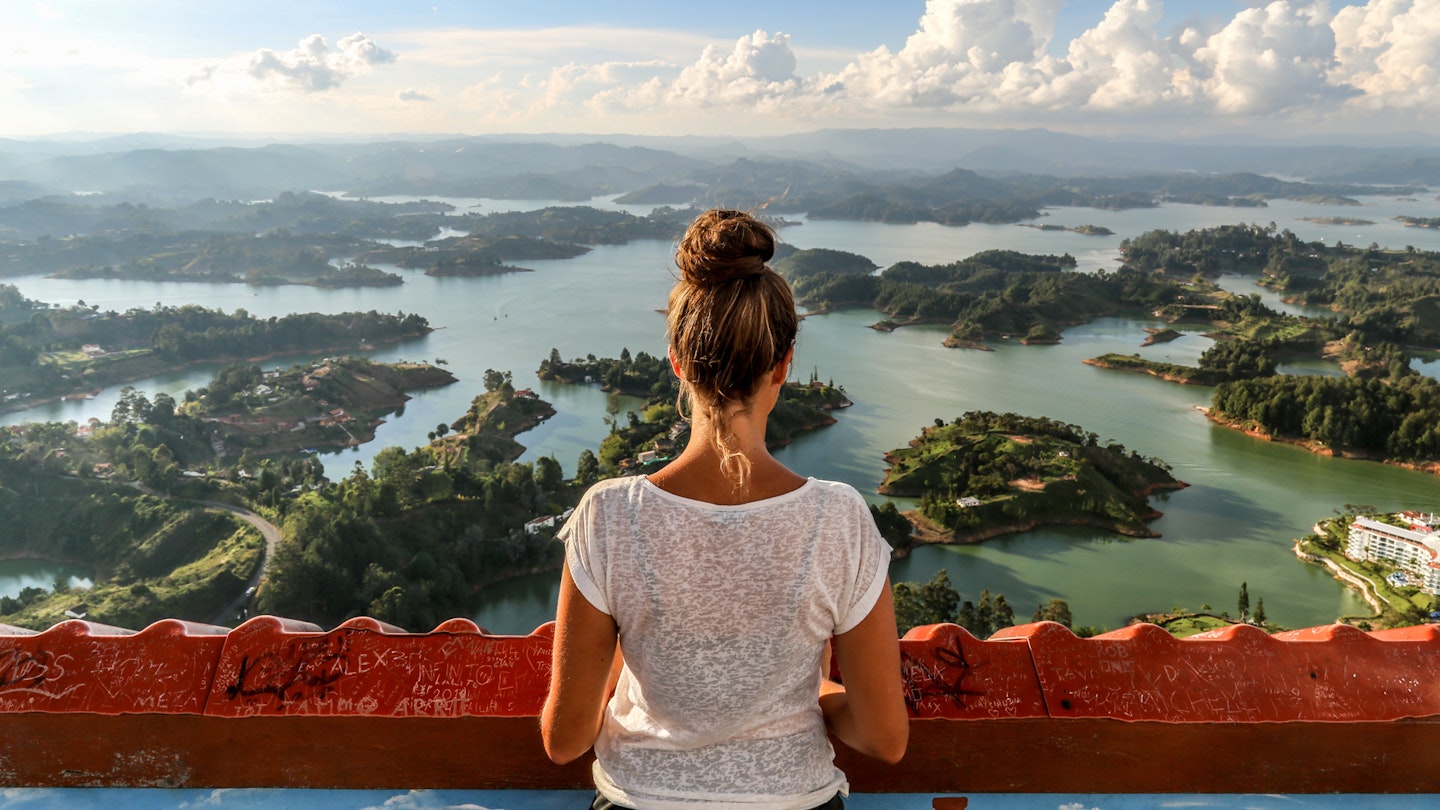
Traveling by public transport in rural parts of Colombia is always an experience © jeremykingnz / Shutterstock
Covering an area nearly twice the size of Texas, Colombia is a huge country. And with a backbone formed by the Andes Mountains and vast swaths of forest covering more than 70% of its land area, this isn't the easiest place to navigate overground.
Luckily, getting around in Colombia is made easier by a solid network of transport options, allowing you to cover large distances relatively easily – although you’ll struggle to fit every highlight of the country in just one trip.
While some remote parts of Colombia are best avoided because of ongoing guerilla or paramilitary activity, exploring this country is now safer than it’s ever been. Most visitors use a combination of inexpensive domestic flights, affordable long-distance buses and pocket-friendly local transport – with the latter being the only means of exploring some of the country’s more rural stretches.
However you travel, getting around in Colombia is an experience in itself and using public transport should be an integral part of any trip to this lively South American nation.
Getting around by air saves time, but not carbon
Thanks to a flood of no-frills airlines making their mark in Colombia, it’s never been easier to turn all-day bus journeys into short flights. EasyFly is the main budget company and you’ll find fares are only a little higher (if not the same) as the comparable bus journey, making domestic flights an extremely affordable and time-saving solution (though you'll need to factor in the carbon cost).
Be aware that prices skyrocket during December and January when Colombians rush to the Caribbean coast for their holidays – destinations such as Cartagena , San Andrés and Santa Marta are heavily affected. Booking in advance is generally advised, but you can sometimes find good deals at the last minute.
For many remote coastal and Amazon regions, flying is the only option, with Leticia , Nuquí and La Macarena among the destinations yet to be connected by road. Flights are mostly served by the state-owned airline Satena , using small jets and ATR turboprops.
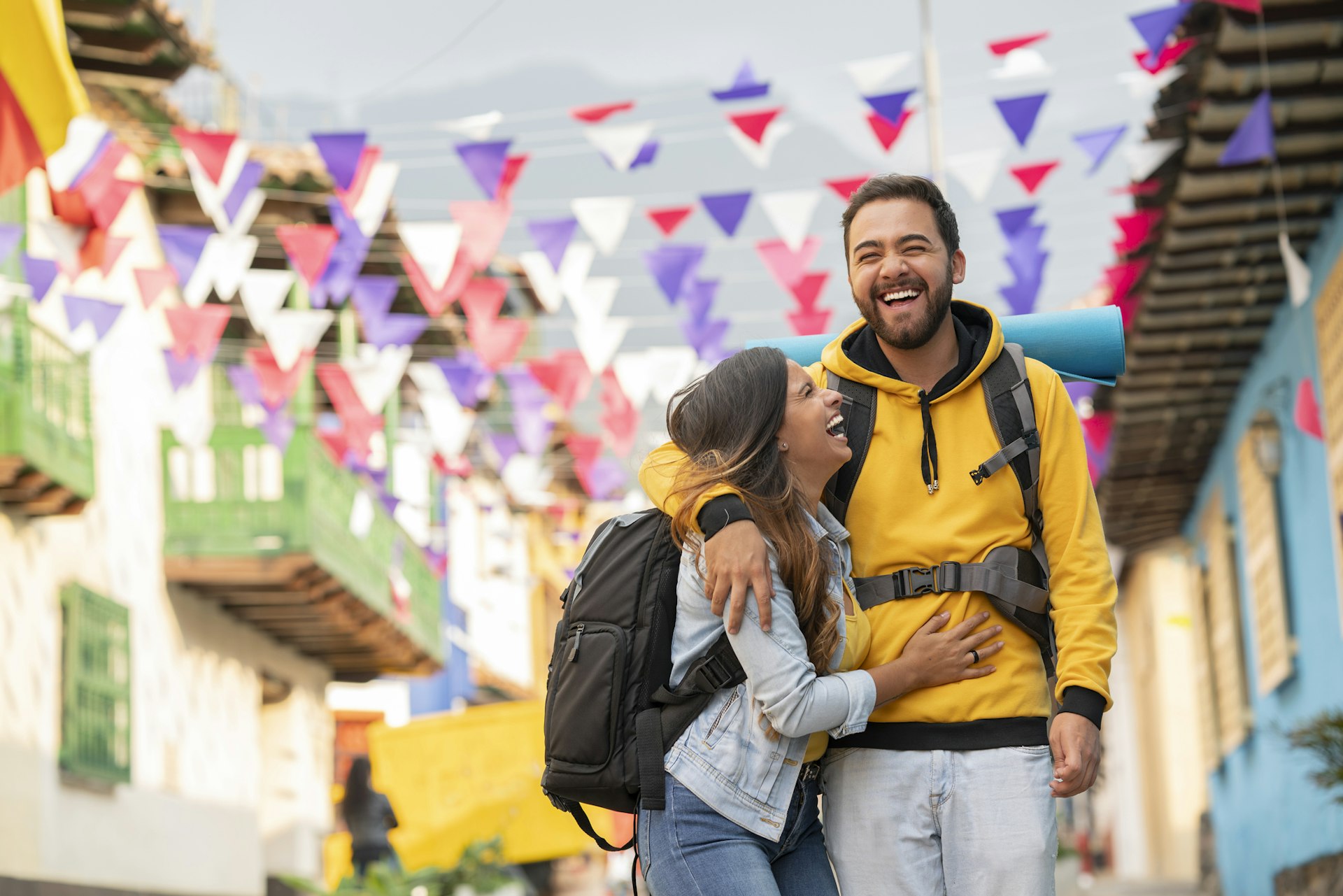
Buses are the backbone of public transport in Colombia
As in most countries in South America, buses are the main mode of transport in Colombia. Most towns have a central bus station from which large public buses depart for destinations across the country. If you’re sticking to a backpacker budget , traveling by overnight bus will save costs on accommodations and help you stretch your money further.
For the nine-hour bus ride from Medellín to Bogotá , you can expect to pay around COP$65,000, while the 11-hour bus ride from Bogotá to Cali will set you back around COP$80,000. This affordability comes with other costs, however. On most bus journeys in Colombia, you can expect to be treated to music so loud you’ll be worried about bursting your eardrums, or excessively violent films played for the entirety of the journey.
Earplugs are a must and bringing enough food and drink to get you through the long hours is also essential. Air conditioning is typically cranked up to Arctic levels, so bring plenty of layers, even if you’re traveling in a hot part of the country. Keep your passport handy as you may be asked to show ID at military checkpoints en route.
Colombia is crisscrossed by snaking mountain roads, and bus drivers often put their foot down on the gas on open stretches, so you'll need to be strong of stomach or bring anti-sickness pills to stave off motion sickness. Be cautious with your belongings – don’t flash expensive cameras or phones around and avoid keeping valuables in luggage placed beneath the bus or in the overhead lockers. Keep precious items close by at your feet where you can see them at all times.
Choosing a bus company
Not all bus companies are created equally. Traveling around the country is safer than it has been for years, but for long-distance journeys in Colombia, it’s still best to book with one of the more expensive bus companies such as Expreso Bolivariano and Flota Occidental , rather than relying on cheaper operators.
On these premium services, buses don’t stop to pick up passengers mid-journey, which reduces the risk of being hijacked (it's uncommon but still a possible scenario). These buses also have more legroom, functioning toilets and sometimes even Wi-Fi, and they are more likely to stick to schedules and get you to your destination on time.
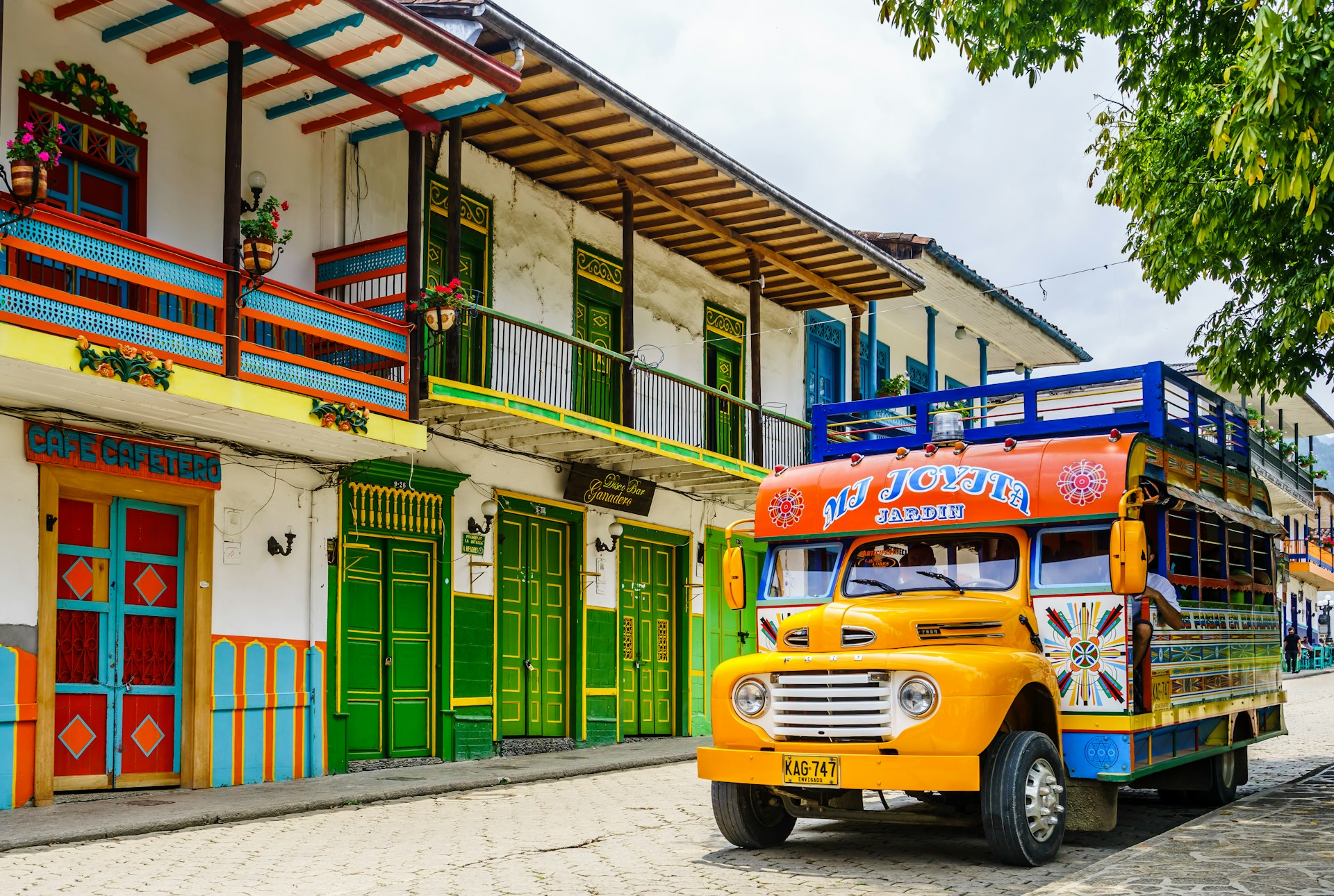
Colectivos and chivas are handy for shorter trips in rural Colombia
For shorter trips between regional destinations, the quickest route is often by buseta or colectivo – interchangeable terms for a minivan, which will be packed to the max with people squeezed in alongside luggage and potentially even livestock. Because of their small size and speed, these vehicles can cover shorter distances between towns and cities much faster than larger buses, and they charge a slight premium as a result. Sometimes colectivos also take the form of shared taxis with just four passengers.
Fares are typically paid directly to the driver, who decides the price, and the van or car won’t leave until full. It’s better to better to look for a vehicle with passengers on board that’s almost ready to depart, rather than committing your luggage to an empty vehicle.
In the coffee region, you might also encounter old-fashioned Willys Jeeps – small 4WD vehicles that have room for a couple of passengers seated up front, and more clinging on at the back – though this can be a hair-raising way to travel. Iconic chiva s, colorful but aging local buses with seating inside and on the roof, are still a fixture in rural areas. You’ll mostly find them crawling up mountain roads or offered for rent as raucous party buses around the bigger cities.
Urban transport in Colombia is safe and efficient
In Colombia’s larger cities, you can expect to find clean and safe public transportation. In Bogotá, the TransMilenio bus network serves the city using dedicated bus lanes (the TransMi App is great for route planning). Calí has the Masivo Integrado de Occidente (Mio), which works in a similar way.
In Medellín, the Metro is the city’s pride and joy, and it efficiently joins up with the Metroplús bus network and the Metrocable cable car. The latter takes you into the surrounding hills and is worth riding for the spectacular city views.
To ride on any of these forms of transport, you will need a rechargeable card specific to that city, which can typically be purchased at stations and, in the case of Bogotá, at El Dorado International Airport .
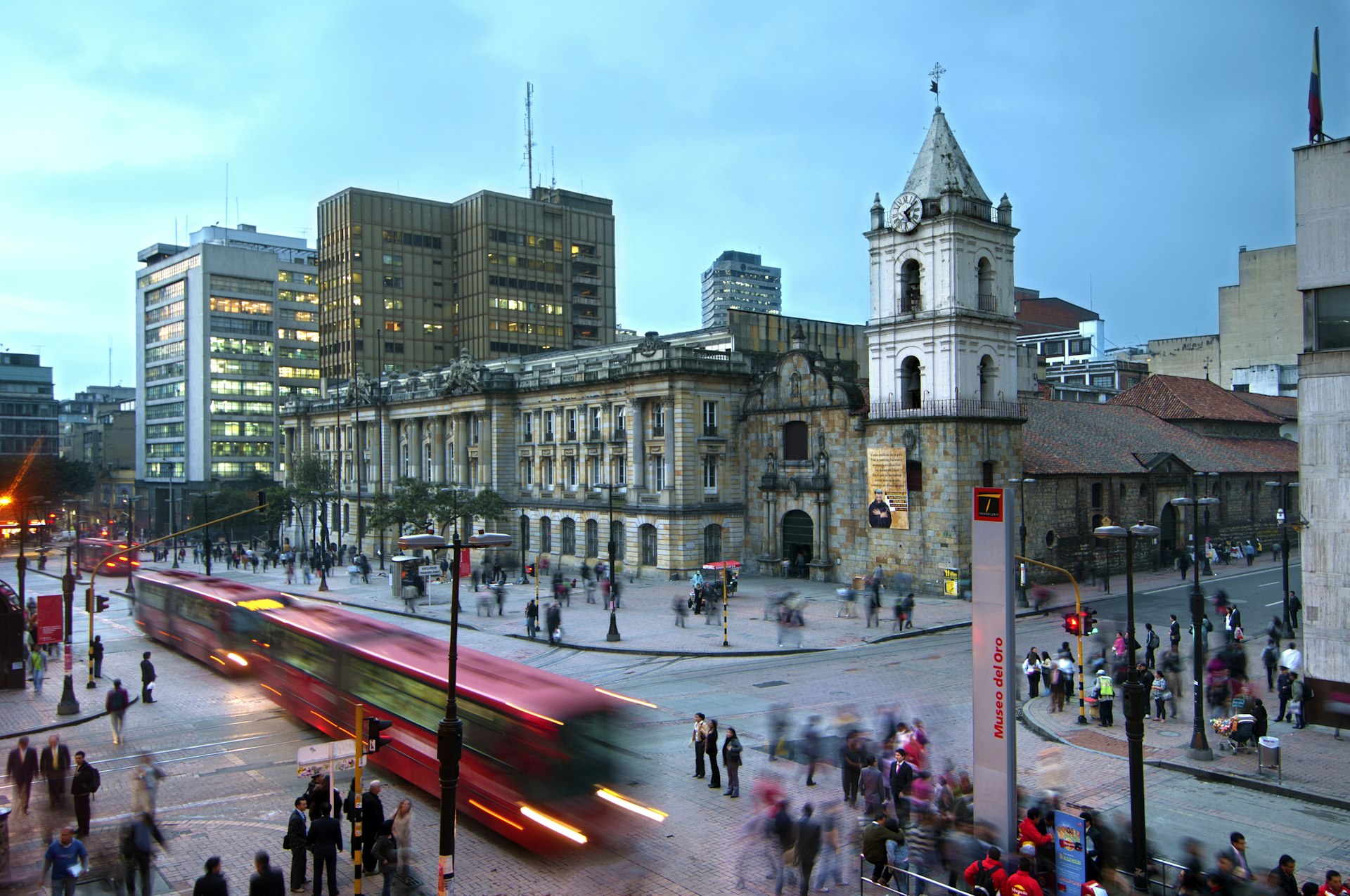
Using an app is the safest way to summon a taxi in Colombia
Parts of many Colombian cities are dangerous at night, so it’s always worth taking a taxi rather than attempting to walk back to your accommodation after dark. Apps such as Easy Taxi and Uber (which is wrangling in the courts over regulatory issues but is still in operation) have made taking a taxi in Colombia a much safer endeavor.
Yellow cabs that you can hail on the street are commonplace in all Colombian cities and are typically metered. However, using an app can help ensure you don’t get ripped off when it's time to pay your fare. If using a cab from the street, it’s best to go to a taxi rank rather than flagging down a moving vehicle. While robberies are uncommon, they do happen, so take a photo of the taxi registration plate before you get in and forward it on so you have a safe copy.
In the cities, taxis are typically metered, but fares in Bogotá can be particularly complicated. Rather than displaying prices, the meter counts up from 25, and you’re expected to decode the fare according to a tariff sheet attached to the back of the passenger seat.
To simplify this obtuse system of calculations, download the Calculadora de Tarifas app or consult with your hotel about the fare you can expect to pay and confirm this with the driver before accepting a ride. In small towns and rural areas where taxis are unmetered, it’s standard practice to agree on the fare before you get in.
Traveling by bicycle is an adventure
Colombia is one of Latin America’s cycling hotspots, and local people are very partial to hitting the tarmac on two wheels. While the terrain isn’t easy for thigh-powered transport, cycling around Colombia is a whirlwind of an adventure and you can find bicycle shops dotted around the country that will rent you a bike or help you repair your own.
If you’re in Bogotá on a Sunday, hit the streets alongside hundreds of other cyclists and pedestrians when the capital closes 120km (75 miles) of its roads to vehicles for the weekly Ciclovía event .
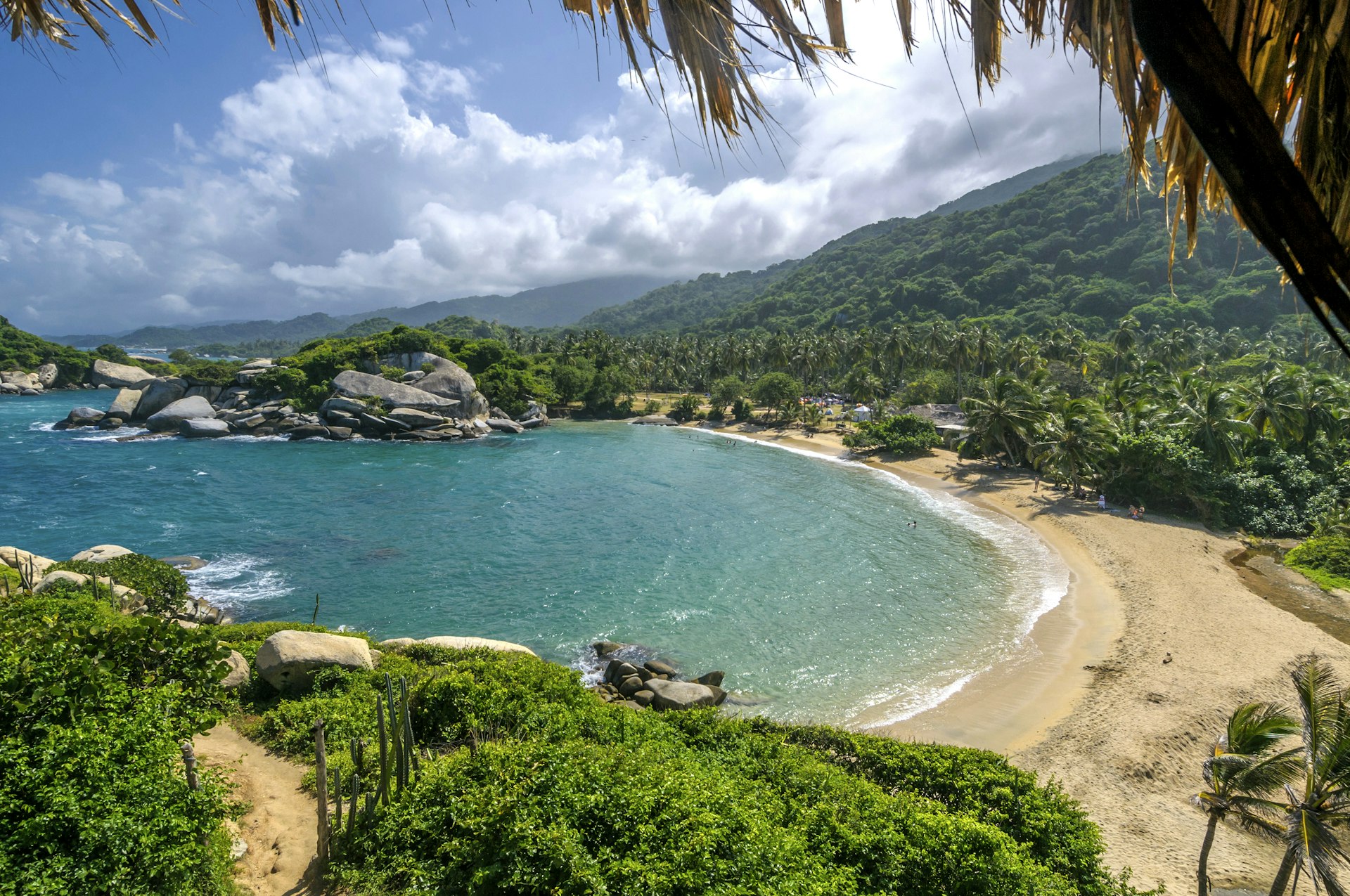
Boats zip along the Caribbean and Pacific shorelines
Along the Caribbean and Pacific coasts, it's often faster (and more scenic) to reach isolated settlements, hidden beaches and gloriously remote islands by lancha (boat). The beautiful Islas del Rosario islands can only be reached by boat from Cartagena, while chartered speedboats are the only way to reach some of the most picturesque parts of Parque Nacional Natural Tayrona .
Boats can typically be arranged at the harbor of the town nearest to the destination you wish to reach. You'll usually have to wait until the skipper is satisfied he has enough passengers to make the voyage worthwhile before you depart.
Accessible transportation in Colombia
Colombia isn’t a particularly accessible destination for travelers with disabilities. Wheelchair-friendly transport is rare in most parts of the country, although Bogotá’s TransMilenio system is mostly wheelchair-accessible, with a designated space for wheelchairs on city buses. Traveling with your own portable ramp is recommended in case the bus stops too far from the curb.
Wheelchair-accessible taxis are rare (or nonexistent) in most cities, so it's best to travel with a folding manual wheelchair or small collapsible travel scooter that can be stored in the trunk (this requires you to be able to transfer yourself into the vehicle). Few long-distance buses are accessible, so flights are a better alternative. For more information, download Lonely Planet’s free Accessible Travel Resources guide.
This article was first published Apr 30, 2022 and updated Oct 2, 2023.
Explore related stories
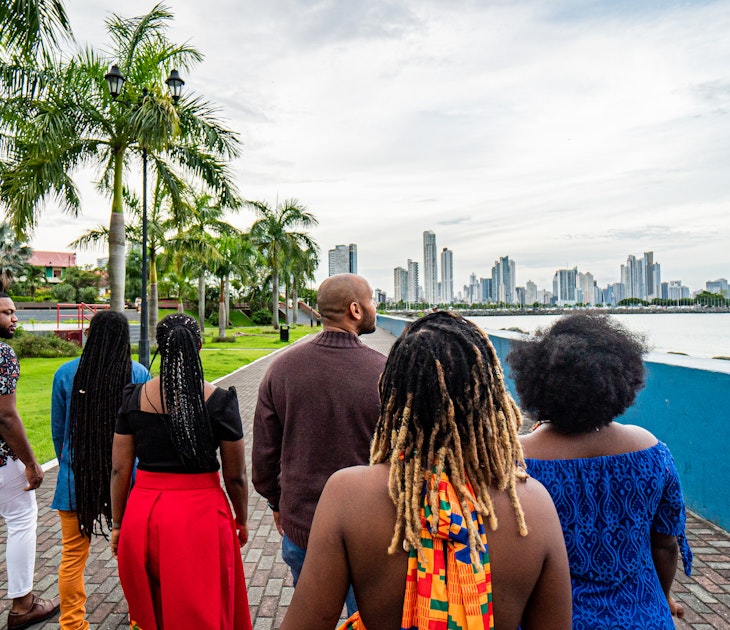
Public Transport
Dec 23, 2023 • 6 min read
Panama may be small, but its attractions are mighty and not always easy to get to. Here's everything you need to know about getting around Panama.
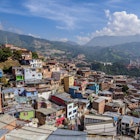
Oct 22, 2021 • 6 min read

May 8, 2024 • 5 min read

Feb 29, 2024 • 9 min read

Feb 11, 2024 • 9 min read

Dec 20, 2023 • 7 min read

Dec 15, 2023 • 7 min read

Oct 1, 2023 • 4 min read
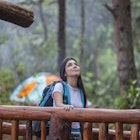
Sep 30, 2023 • 6 min read

Sep 23, 2023 • 5 min read

IMAGES
VIDEO
COMMENTS
Stick to exploring one section of the country and exploring it well: spend three weeks bouncing between sun-soaked, Caribbean beaches or heading from Medellín deep into the Zona Cafetera. Your trip should match Colombia's characteristic pace: slow and enjoyable. 2. Domestic flights are affordable and quick.
It is a reason to come back one day. # 23 RAINY AND DRY SEASON. If there's something you should know before planning your trip to Colombia, is that you can experience two distinct seasons: dry and rainy. According to us, Colombia is a country you can visit any time of the year, but you should consider those seasons.
An Illustrated Handbook for Nature Tourism Guides in Colombia. Flowers, forests, jungles, birds, bears, and even capybaras—Colombia truly has it all. You'll be utterly charmed by the beauty of our nature and you'll be able to show visitors that the legends it spawns have some surprising truths to them. Learn more.
Colombia Itinerary: The Complete 3-Week Travel Guide. Discover the unexpected in extraordinary Colombia! In a country of two sides, expect to find steel skyscrapers bordering colorful pueblos, beaches backing onto snow-capped mountains, and dense green jungle merging into red deserts. Travel this immense country with our 3-week Colombia ...
Find out about the weather in Colombia to choose the best month to visit. Dry Season (December - March): Consider visiting between December and March, the driest months. With minimal rainfall, clear skies, and sunny days, it's the ideal time to explore Colombia's stunning landscapes and beaches.
Colombia. South America. Soaring Andean summits, unspoiled Caribbean coast, enigmatic Amazon jungle and cryptic archaeological ruins. Colombia boasts all of South America's allure and more. Best Time to Visit.
Your ultimate Colombia travel guide, with tips, and things to see and things to do in Colombia. Great for first-time and returning travelers. Located between the Caribbean, the Amazon Jungle, and the Andes Mountains, Colombia has something for everyone. A bright, colorful country, it is a very popular tourist destination and for good reason.
Whether you're seeking adventure, history, showstopping nature or a fabulous party, here are the top things to do in Colombia. 1. Photograph Colombia's national plant in the Valle de Cocora. Adjoining the lower reaches of Parque Nacional Natural Los Nevados, one of the best national parks for hiking in Colombia, the Valle de Cocora is one ...
Colombia is a diverse and captivating country that offers something for every traveler. Whether you want to explore the vibrant cities, the charming villages, the stunning beaches, or the lush ...
An Illustrated Manual for Magdalena River Tour Guides. The Magdalena River is among the most important in Colombia, and it has become a cultural symbol for the people living on its banks: their history, culture, celebrations and much more. Navigate through this guidebook for more information. Learn more.
Colombia has a National Network of Tourist Information Points, which was set up in 2006 to provide a comprehensive tourist information service for the entire country. Since 2010, the National Network has been managed by the National Tourism Fund (Fontur) and has facilities in a wide range of regions across the country.
The Department of State renewed its Travel Advisory for Colombia on October 26, 2021, which remains at Level 3 (Reconsider Travel). Reconsider travel to Colombia due to COVID-19. Exercise increased caution in Colombia due to civil unrest, crime, terrorism and kidnapping. Some areas have increased risk.
Colombia - Venezuela Border - Level 4: Do Not Travel. U.S. citizens are advised not to travel to the border of Colombia and Venezuela. U.S. citizens are at risk of detention when crossing into Venezuela. ... Colombia does not allow the sale of certain psychiatric medications. Travelers should carry a sufficient supply for their trips.
Colombia Travel Guide. Last Updated: March 12, 2024. Colombia is fast becoming the travel highlight of South America. After decades of struggling with crime and cartels, Colombia has become a hub for digital nomads and budget backpackers. More and more people are visiting to soak up the sun and enjoy the country's low cost of living.
Colombia is one of the most popular countries in South America for backpackers and travelers. In 2022, it saw over 4.6 million visitors — a huge increase from the early 2000s, when just 700,000 visitors came to Colombia each year. Over the past few decades, Colombia has been working hard to dispel the violent image it earned thanks to the ...
11. Parque Nacional Natural Serranía de La Macarena. Best for natural spectacles. Due south of Bogotá, Parque Nacional Natural Serranía de La Macarena is one of the most incredible places to visit in Colombia. Just a short drive from the town of La Macarena, Caño Cristales is a river that runs vivid pink.
Read the entire Travel Advisory. Do Not Travel to: Arauca, Cauca (excluding Popayán), and Norte de Santander departments due to crime and terrorism. The Colombia-Venezuela border region due to crime, kidnapping, and risk of detention when crossing into Venezuela from Colombia. Country Summary: Violent crime, such as homicide, assault, and ...
Find continuously updated travel restrictions for Colombia such as border, vaccination, COVID-19 testing, and quarantine requirements.
Buses are Colombia's main means of transportation, and they are incredibly cheap and safe. Taxis, on the other hand, are also cheap, but a few inconveniences come with them. First, they can be ...
Dengue in the Americas April 18, 2024 Dengue is a risk in many parts of Central and South America, Mexico, and the Caribbean. Some countries are reporting increased numbers of cases of the disease. Travelers to the Americas can protect themselves by preventing mosquito bites. Destination List: Argentina, Brazil, Colombia, Costa Rica, Ecuador ...
December to February is ideal for hiking Colombia's national parks. December to February is a fantastic time to travel through Colombia because it's dry everywhere except the Amazon. In the Andes, expect sunny skies and warmish days - perfect for hiking in the country's clutch of outstanding national parks, while the Caribbean coast is at ...
Firearms and other weapons are common in Colombia. Armed robberies are frequent and may occur on streets, in buses, taxis, restaurants and shopping malls. Criminals won't hesitate to use weapons on victims who refuse to co-operate. Avoid walking alone in isolated or deserted areas. Avoid travelling alone after dark.
Before you travel to Colombia, it is advisable to exchange some currency in your home country. This way, you will have some Colombian pesos on hand when you arrive. It's worth noting that the exchange rate can vary, so it's a good idea to check the current rate before making the exchange. You can do this easily by using an online currency ...
Remember, you can also get the vaccine in any of Colombia's major cities. Other recommended vaccines, but not mandatory, include immunization against Hepatitis A and Typhoid fever. The same applies to Malaria pills, which are advisable if visiting the rainforest regions, where we would also recommend the use of insect repellent and mosquito nets.
Urban transport in Colombia is safe and efficient. In Colombia's larger cities, you can expect to find clean and safe public transportation. In Bogotá, the TransMilenio bus network serves the city using dedicated bus lanes (the TransMi App is great for route planning). Calí has the Masivo Integrado de Occidente (Mio), which works in a ...
Nestled high in the Andean mountains, find Bogotá, the dynamic capital city of Colombia. Despite its sprawling urban landscape, vibrant culture and rich history, Bogotá has managed to maintain a low profile on the international travel scene. Better for you, because beneath the surface of its ...
The potential for stronger events of course does exist and we'll see if any materialize." The peak of the geomagnetic storm activity for Earth could occur between 2 a.m. and 5 a.m. ET on ...